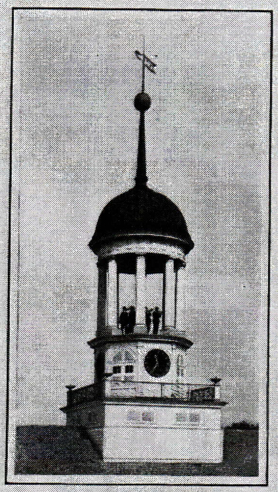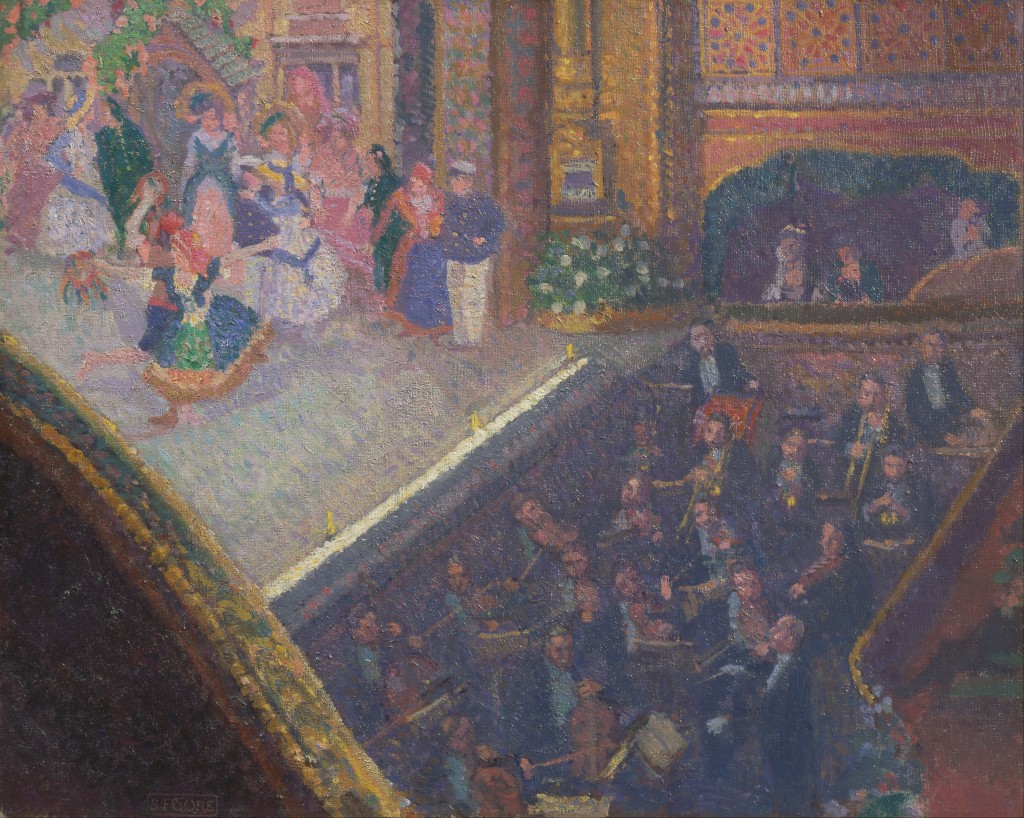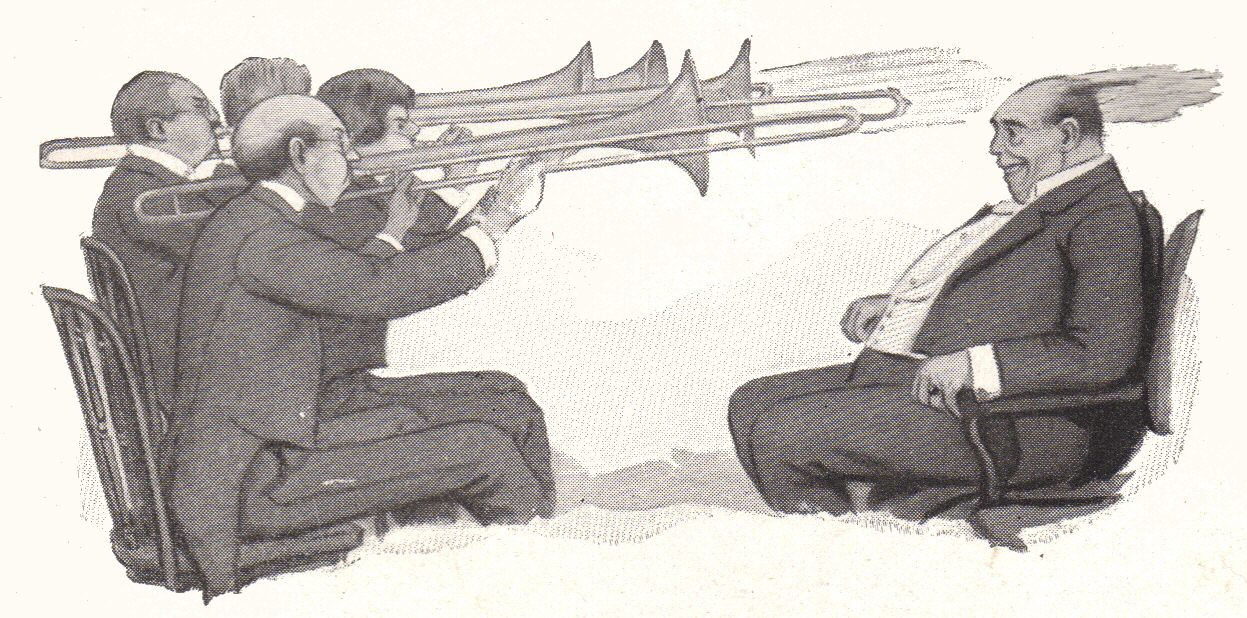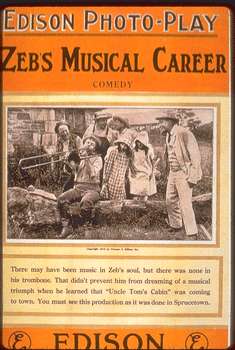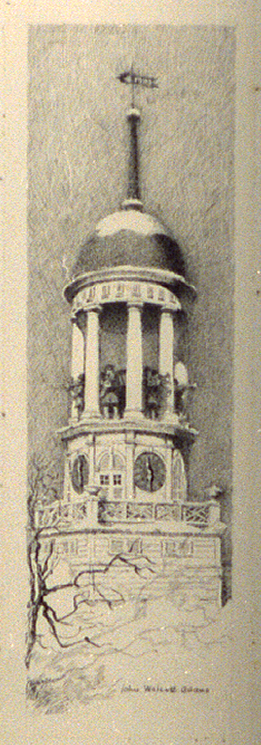A history of the trombone in timeline form. For sources see Trombone History Bibliography.
_______________
c. 1901—Spanish artist and writer Santiago Rusiñol i Prats (1861-1930) draws a series of musicians, including a valve trombonist (see below image; public domain; source: wikimedia commons).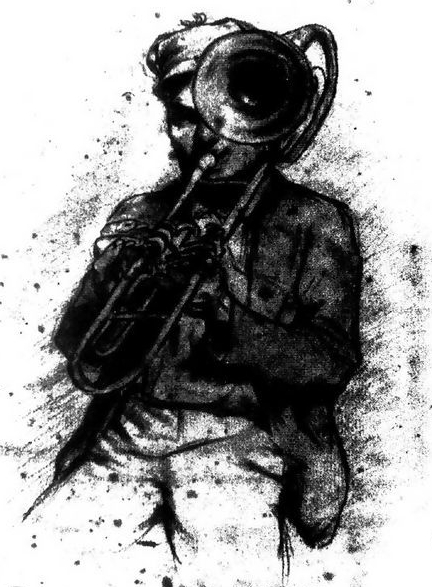
c. 1901—A watercolor signed by Albert Escher (1833-1905) depicts a group of Dutch soldiers, including a military trombonist. The title is Netherlands, 1821 (see below image; public domain) (New York Public Library Digital Gallery).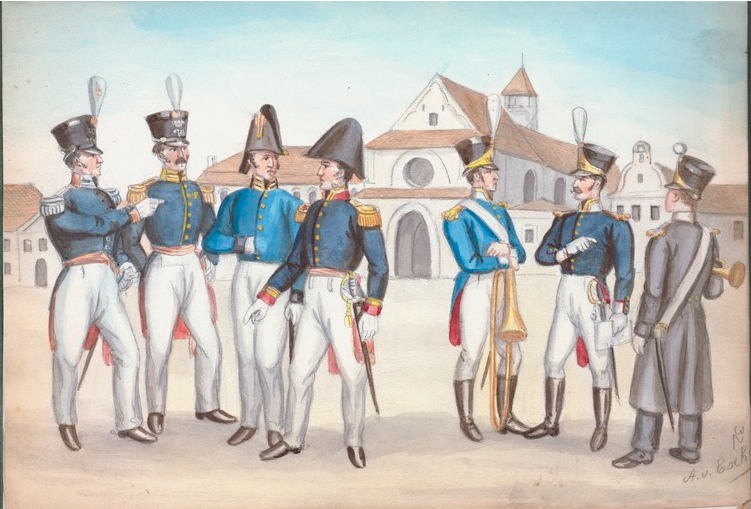
c. 1901—A watercolor signed by Albert Escher (1833-1905) depicts a group of Italian soldiers, including a military trombonist. The title is Italy: Kingdom of the Two Sicilies, 1824-1828 (see below image; public domain) (New York Public Library Digital Gallery).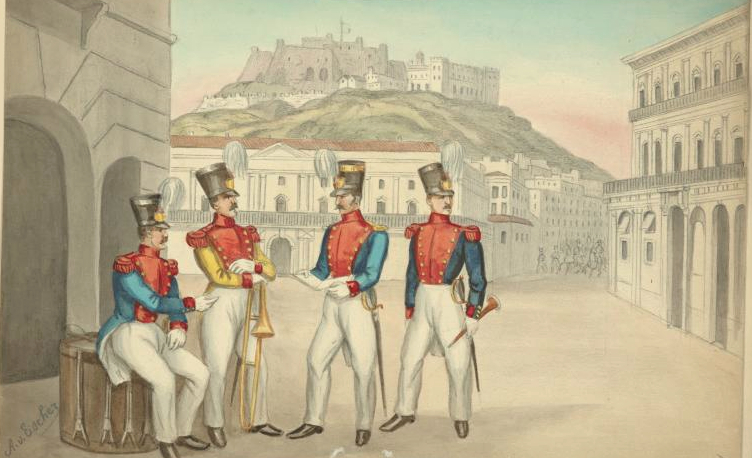
1901—Paris Conservatory morceau de concours: Alfred Bachelet, Morceau de Concours.
c. 1901-1905—Arthur, Illinois: A photograph captures a delivery boy for Rigney Haney General Store standing by the delivery wagon, practicing trombone (see below image; public domain) (Arthur, Illinois Public Library).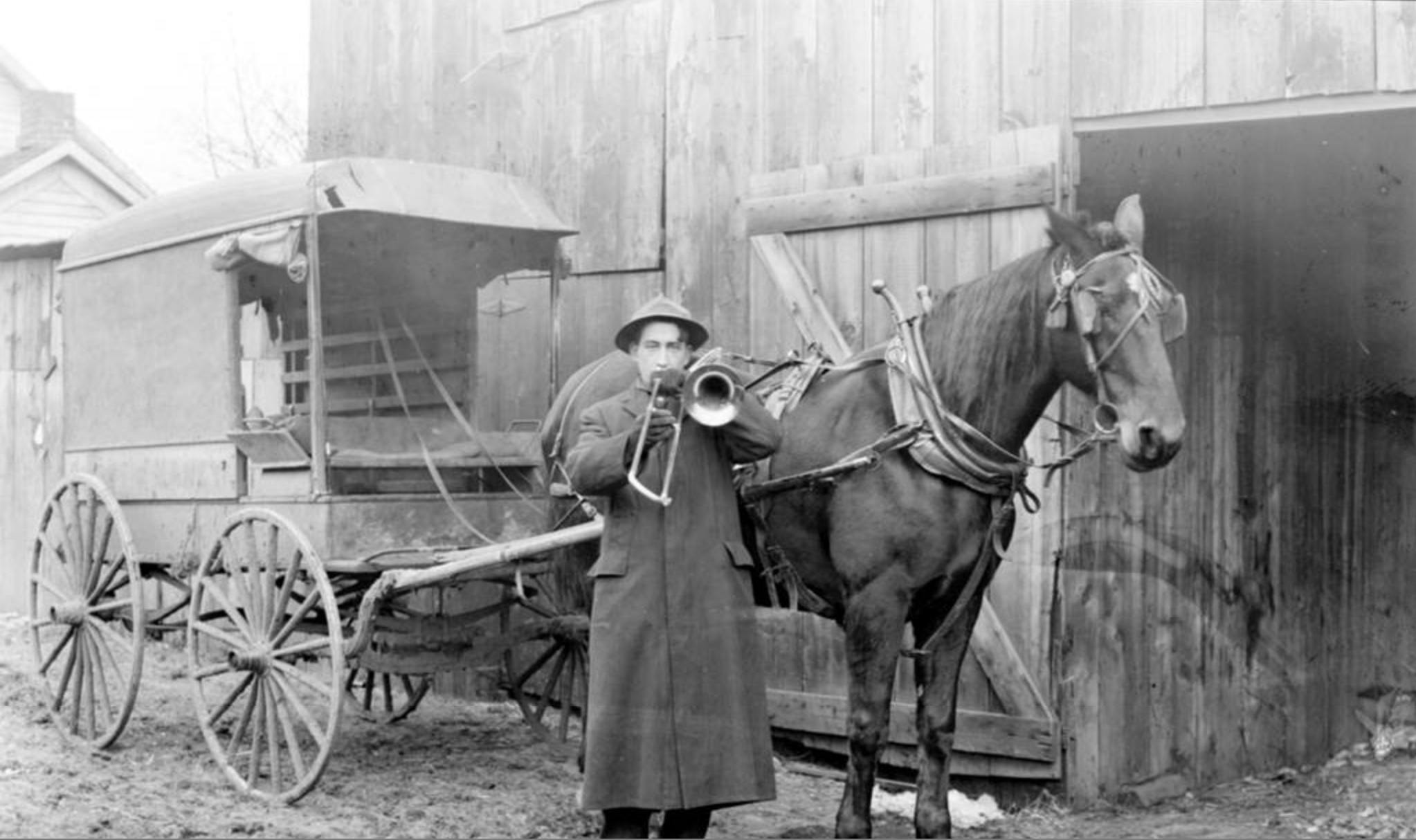
1901-1910—England: A postcard features a trombonist wearing a uniform emblazoned with the cipher of Edward VII (see below image; public domain).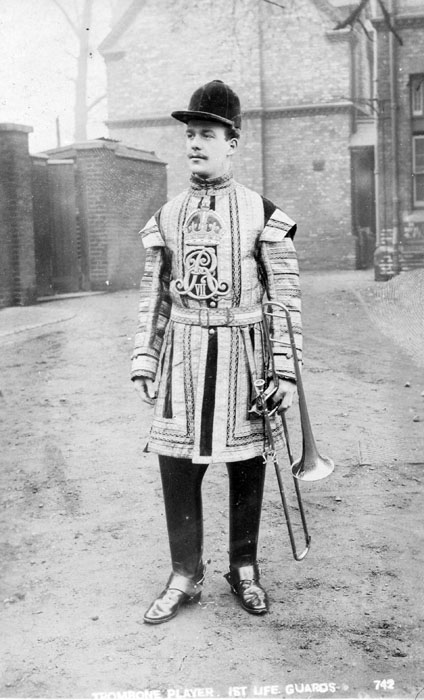
1902—Eugen Reiche, Concert Piece [Concerto] No. 2. Dedicated to Paul Weschke, a well-known Berlin trombonist. Important early solo in the Russian military band tradition (Lenthe).
1902—Vienna, Austria: Gustav Mahler writes the following about his 3rd Symphony in a letter to Richard Strauss: “A motley collection [of players] that is not up to standard could not cope with my work; that I know! Just have a look at the score! At any rate, the first trombone must be outstanding, with a colossal tone and mighty breath! Would not your first trombonist in Berlin, whom I have heard highly praised, be best for this?” (Mahler Correspondence 70).
1902—Geneva, Switzerland: H. Kling, orchestration professor at the Geneva Conservatory, apparently influenced by Berlioz, writes the following about trombone: “The tone of this fine instrument possesses qualities may be described as both noble, heroic, emotional and majestic. Employed ‘fortissimo’ in its middle and lower registers, it can be used to advantage in expressing energy and brutality; in sustained cantabile passages performed ‘piano,’ it is expressive of earnest religious feelings. It is also well-adapted for dramatic scenes or situations demanding expressions of a dismal, demoniacal or terror-awakening nature” (Kling 150).
1902—The Klein Family, a famous unicycle circus troupe, includes a trombonist. A 1902 poster advertising “Troupe Klein” is one of several showing a member of the group playing trombone. Two additional Klein Family posters, probably from somewhat later, also show a trombonist on unicycle (see below 3 images; public domain). 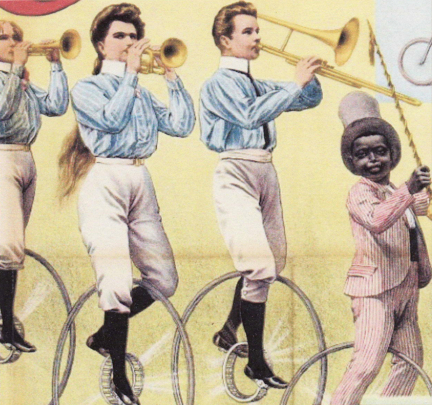
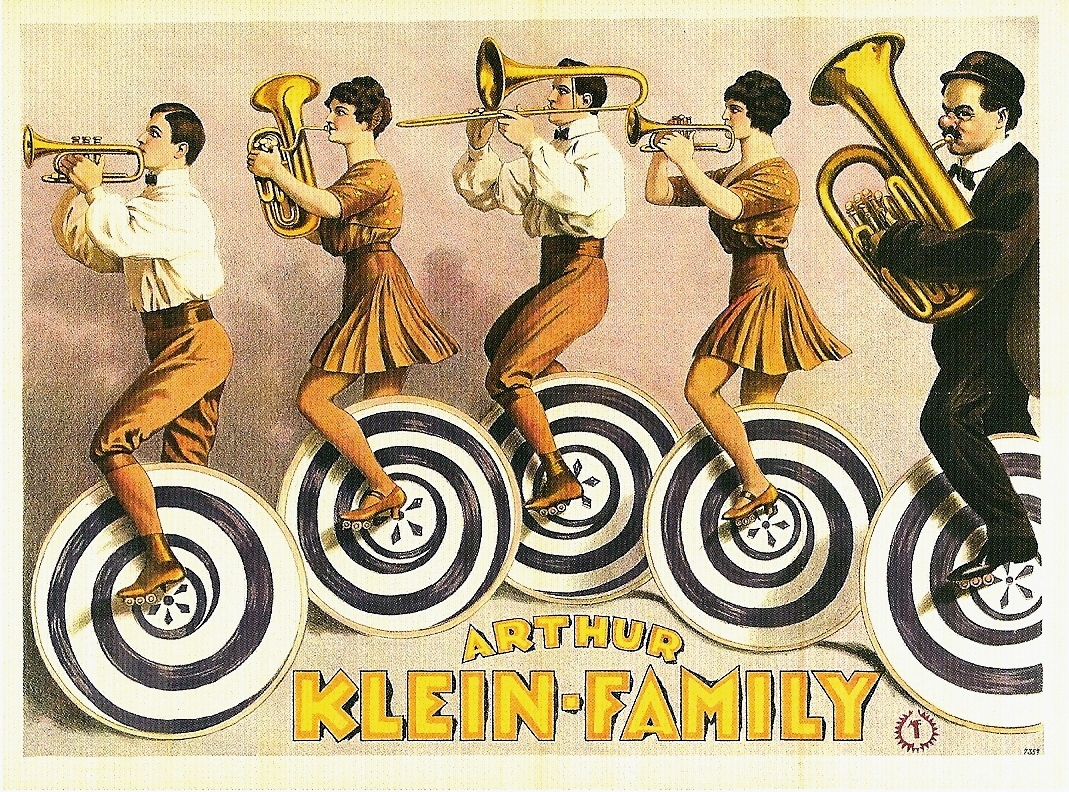
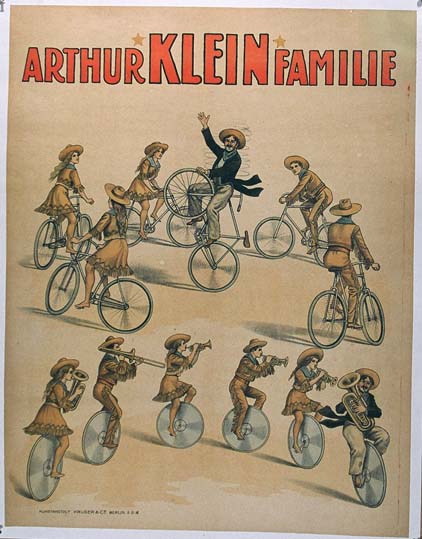
1902—London, England: Boosey & Co. offer valve alto trombones in F and E-flat, valve tenors in C and B-flat, and valve basses in A-flat, G, F, and E-flat. By 1923, the only valve trombones they offer are tenors in B-flat and basses in E-flat, F, and G (Baines, Brass 64).
1902—Paris Conservatory morceau de concours: Alexandre Guilmant, Morceau Symphonique.
1902—Arthur Elson, in his orchestration textbook, says, “The use of the slide renders the trombone more perfect in tone than any of the instruments except the violin family. Not only can the slide be used in correcting those harmonics that are out of tune with our scale, but it also enables the performer to produce varied effects by sharping or flatting his tones at will, as the violinist does also in certain progressions. Trills are practicable on all the upper notes of the instrument, though they are not effective on the bass trombone. Rapid passages are unsuited to its character, and are usually difficult, except for those few phrases that lie entirely in one harmonic series and can be blown without change of position. Such quick execution is never demanded in orchestral works, though allowable in solo pieces. A trombone concerto by Ferdinand David, for instance, abounds in florid passages” (Elson, Orchestral 239).
1902—Arthur Elson, apparently influenced by Berlioz, says in his orchestration textbook, “The trombone is chief of those wind instruments that depict heroic emotions. It possesses in a superlative degree the qualities of nobility and grandeur. Its deep and powerful tones speak in the most poetic accents, and may reflect anything from sacred religious calm to the liveliest acclamations of martial glory. It is especially effective in somber passages, and has a forbidding, almost threatening quality of tone. Its loud tones are unusually menacing…” (Elson, Orchestral 242).
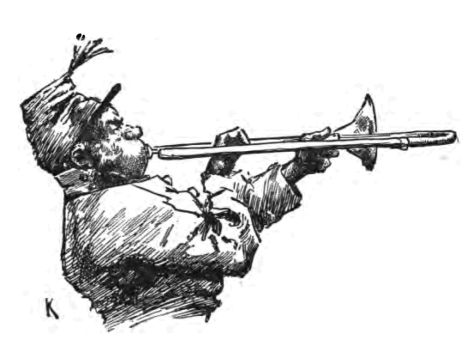 1902—Joseph Lincoln includes “The Ballad of McCarty’s Trombone” in his Cape Cod Ballads and Other Verse. Accompanying the ballad is the facing illustration by Edward W. Kemble (see facing image; public domain).
1902—Joseph Lincoln includes “The Ballad of McCarty’s Trombone” in his Cape Cod Ballads and Other Verse. Accompanying the ballad is the facing illustration by Edward W. Kemble (see facing image; public domain).
1902-03—Arnold Schoenberg, Pelléas und Mélisande, op. 5 calls for 5 trombones. Schoenberg indicates glissando for trombones—one of the earliest such indications in Western music (the earliest is probably Rimsky-Korsakov’s Mlada (1892). Schoenberg feels it necessary to add the following explanatory footnote: “The glissando on the trombone is executed as follows: the note E is established by the lips as the lowest partial of the sixth draw [7th position] and then the slide is shifted through all the positions in such a way that the chromatic intervals, as well as the quarter-tone, eighth-tone and smaller intervals in between, are clearly heard, as in the glissando of string instruments” (Gregory 67).
1903—Bethlehem, Pennsylvania: Harper’s Weekly publishes an engraving depicting a trombone ensemble performing from a church tower at the beginning of the city’s famous Bach festival. The caption reads, “The Trombone Choir: Announcing the beginning of the performances from the belfry” (see below image; public domain) (Harper’s Weekly, 1903, Issue 5/16, p. 800).
1903—Paris Conservatory morceau de concours: Bernard Crocé-Spinelli, Solo de Concours.
1903—Claude Debussy gives the following advice in a letter: “And above all remember that the brass are very delicate and not instruments of carnage! Only in the most extreme circumstances should a trombone blare” (Fisk 199).
1904—Lockport, Louisiana: A photograph of the Matthews Band of Lockport, Louisiana shows both a valve trombonist and a slide trombonist in the 12-member group (see below image) (public domain image; source: wikimedia commons).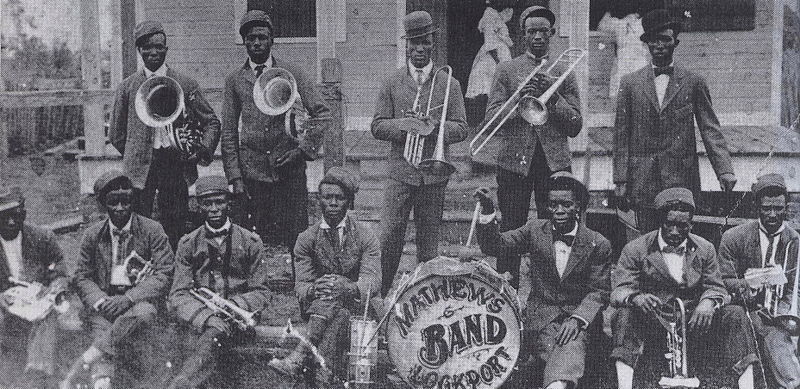
1904—Music critic C. L. Graves says, “The trombone is specially interesting as it is practically the only wind instrument now left in its natural condition, and not furnished with simplifying mechanism. To this immunity it probably owes the unimpaired splendour of the tones which commended it so peculiarly to Gluck, to Mozart, and to Schubert. Mendelssohn’s remark as to the reverence with which its solemn tones should be employed is justly admired, and on another occasion he admitted it, by implication, along with other wind instruments, into heaven, on condition that they never got behind the beat (Graves 12).
1904—Arthur Pryor, Blue Bells of Scotland, The Whistler and His Dog, and Thoughts of Love.
1904—Paris Conservatory morceau de concours: Edmond J. Missa, Morceau de Concours.
1904—England: J. E. Borland says, “First, notwithstanding the presence of the tuba, it is to be wished that the bass trombone in England were used in F more frequently than it is, or at any rate that the G trombone should always have the piston attachment to produce the eight-feet C” (Borland 476).
1904—London, England: Grinstead and Stuart apply for a patent for a “locking device for a slide trombone,” a version of which is now standard on all trombones (Herbert, Trombone 12).
1904—England: J. E. Borland says, “Then we could welcome a more extended use of the contra-trombone also, and a revival of the obsolete soprano and nearly obsolete alto-trombones. Their parts are to-day supplied by other instruments, but complete harmony in one tone-colour produces an effect attainable in no other way” (Borland 476).
1904—Wilhelm Muhlfeld, Concertstück.
1904—A New Year’s postcard image, apparently referencing the Stadpfeifer and/or Moravian trombone tradition, depicts 3 trombonists performing from what appears to be a church tower (see facing image; public domain) (New York Public Library Digital Gallery).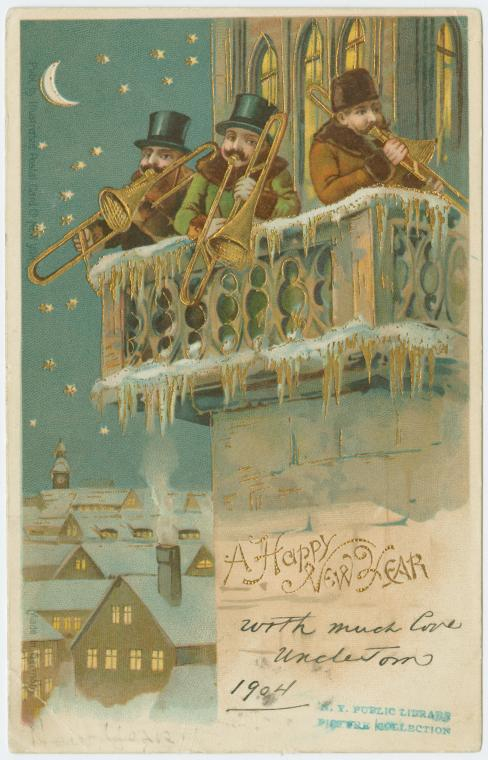
c. 1904-08—United States: A postcard shows a trombone quartet with several different sizes of trombones (see below image; public domain) (source: TempoSenzaTempo.blogspot.com).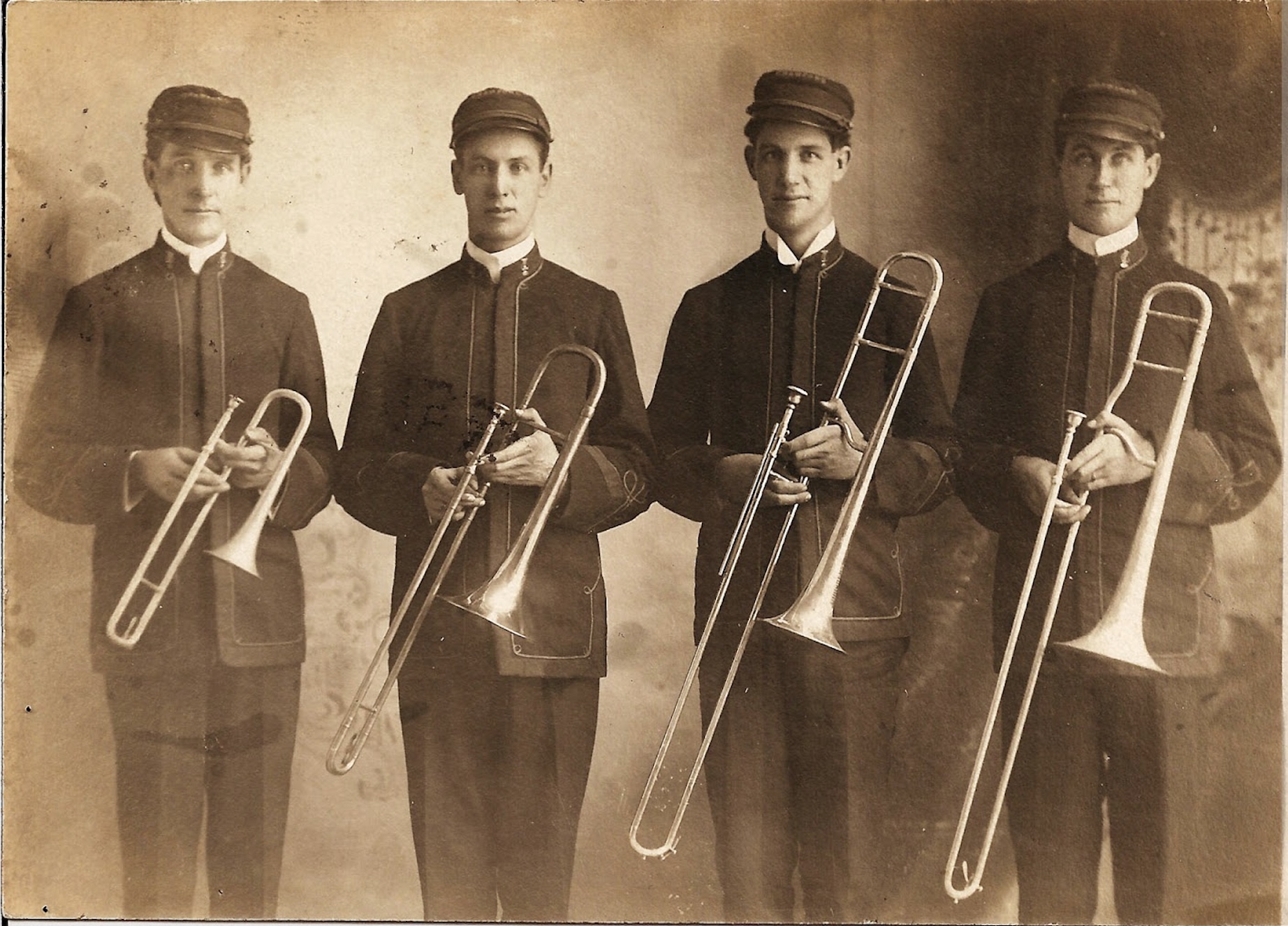
1905—Claude Kopprasch, Sixty Selected Studies for Trombone, books 1 & 2.
1905—Paris Conservatory morceau de concours: Sigismond Stojowski, Fantasie.
1905—Boston, Massachussetts: Louis C. Elson, professor of theory at New England Conservatory, publishes Elson’s Music Dictionary. In it, he comments on the valve versus slide trombone, “The trombone with keys is the easier to play, but the slide-trombone has the better tone.” He goes on to talk about pedal tones: “Each instrument [alto, tenor, and bass] can also sound the note an octave deeper than the one given as the lowest in the above schedule. This is however very difficult to do, yet good players can attain this fundamental, by protruding the lips well into the mouthpiece, and can then lower the tone by means of the slides. These deep tones are called the pedal tones and must be sparingly used….The pedal tones have a growling, unpleasant quality” (Elson, Music Dictionary 271).
1905—Paris, France: A “sudrophone trombone” in both E-flat (alto) and B-flat (tenor) is advertised in the catalog of F. Sudre (see below image; public domain).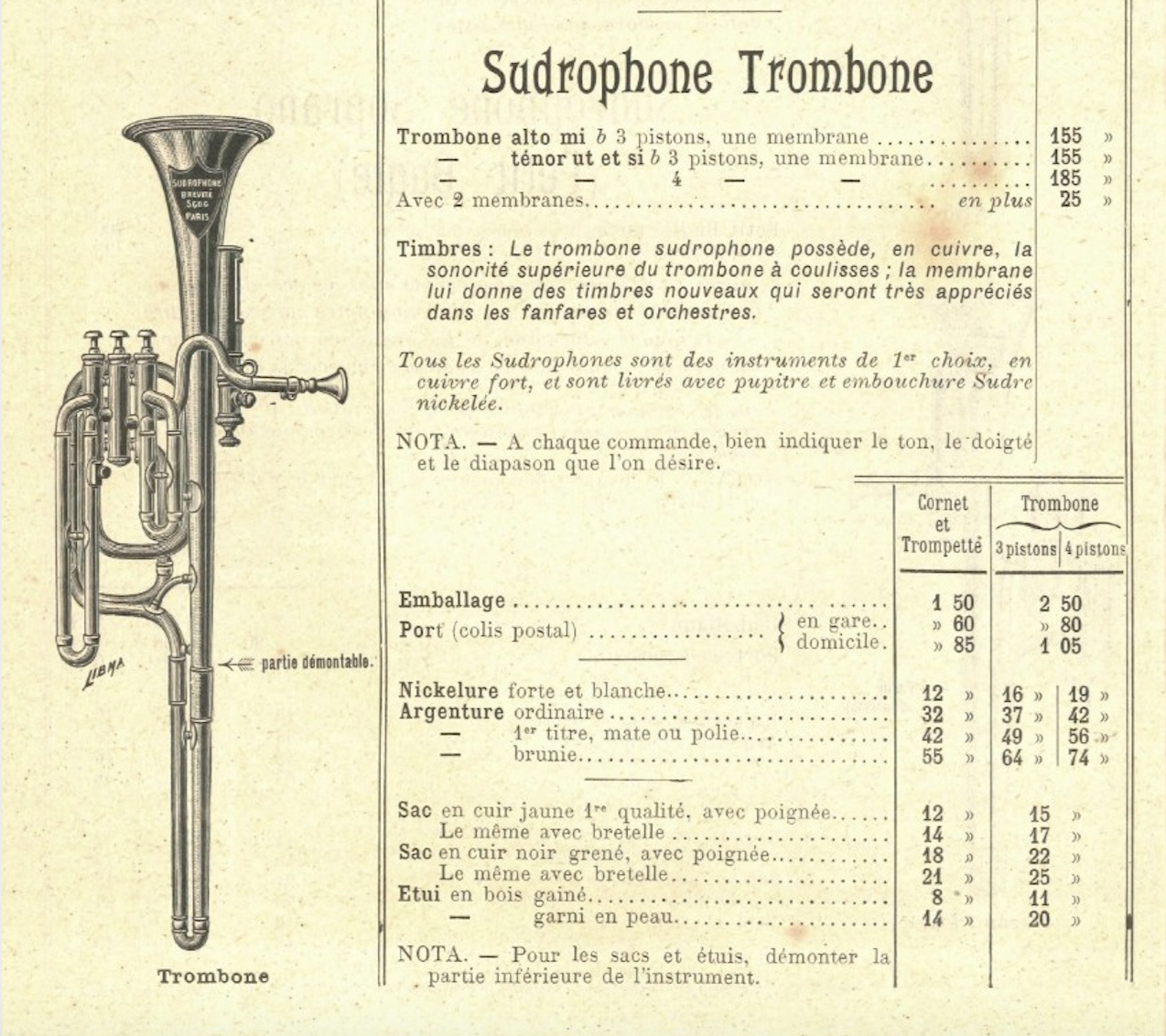
1905—South Wales: A photograph of the Cyfarthfa Band, a private brass band considered one of the finest of the 19th century, shows an ensemble of 20 players, including 3 trombones (Herbert, Cyfarthfa).
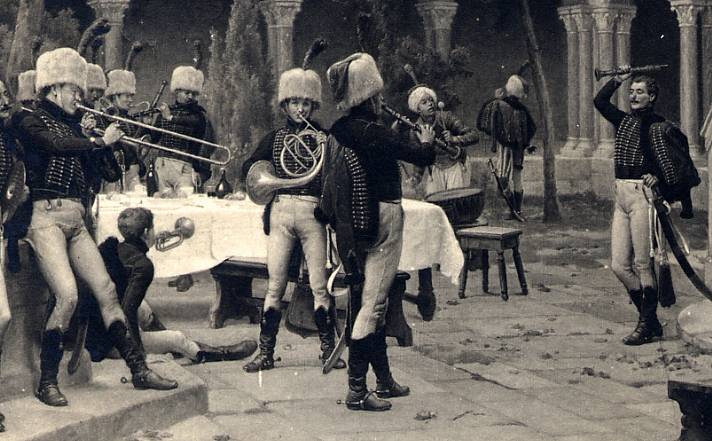 1905—France: A detail from L. Baader’s “Le quart d’heure de Rabelais” shows a number of military musicians, including a trombonist (see facing image; public domain) (source: Typologie des instruments a vent).
1905—France: A detail from L. Baader’s “Le quart d’heure de Rabelais” shows a number of military musicians, including a trombonist (see facing image; public domain) (source: Typologie des instruments a vent).
1905—England: Boosey & Hawkes continues to market its contrabass trombone. Originally introduced in 1862, the instrument is labeled “Basso Profundo” in the sales catalog (Baines, Brass 247).
1906—Russia: Vladislav Blazhevich (1886-1942) becomes 1 of the 3 trombonists at the Bolshoi Theatre, where he remains until 1928.
1906—Paris Conservatory morceau de concours: Georges Pfeifer, Solo de trombone.
1906—Historian F. W. Galpin, in his classic paper on the history of the sackbut, laments, “How Mersenne would shudder at the ordinary trombone playing of the present day…. Would it not be possible to revive in the 20th century the true sackbut playing for which England was so famous in the sixteenth century?” (Galpin, The Sackbut).
1906—London, England: A cartoon printed in Punch magazine shows a group of bandsmen not getting along (see below image; public domain) (May 30, 1906, p. 388).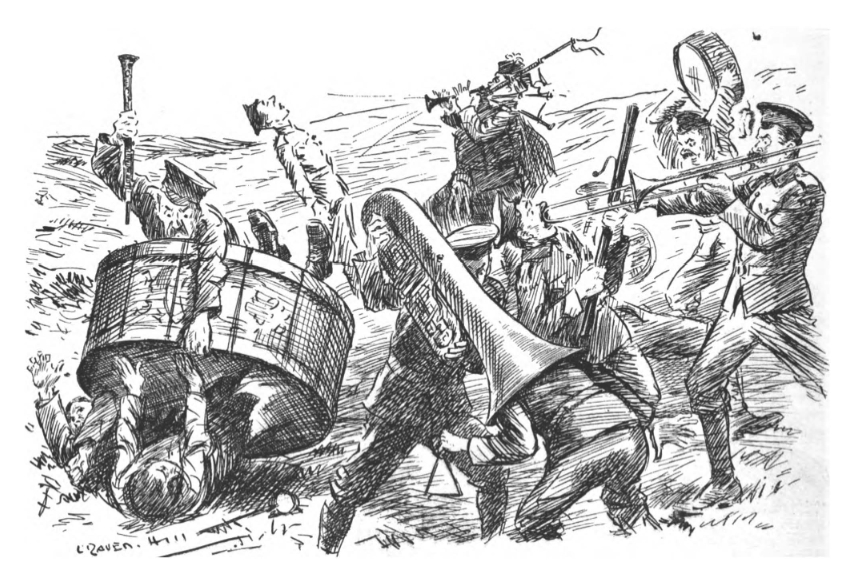
1906—Charles Widor, in his text, The Technique of Modern Orchestration, says the following about alto trombone: “Despite its admirable timbre, akin to that of the Trumpet in F, the Alto Trombone has now become more or less obsolete, because its compass being much the same, it is almost a duplicate of that magnificent instrument…If the Alto Trombone was necessary in the orchestras of yore, which never had more than two Trumpets, it is not so indispensable now that we have three or four Trumpets….It was a characteristic German custom, on Sundays and Church holidays, to have the Choral for the day played by a band of Cornet and Trombone players, standing in the tower of the principal church. Bach introduced this effect into his Cantatas, the brass instrument group playing alone or doubling in unison each of the vocal parts. So, the Cornetto and the Trombones were grouped together, and the Alto became an indispensable voice in this robust quartet” (Widor 78).
1906—London, England: The Graphic, an illustrated weekly newspaper, publishes a drawing by Lucas of 5 wind musicians playing from a balcony. Two of the five appear to be valve trombones (see below image; public domain).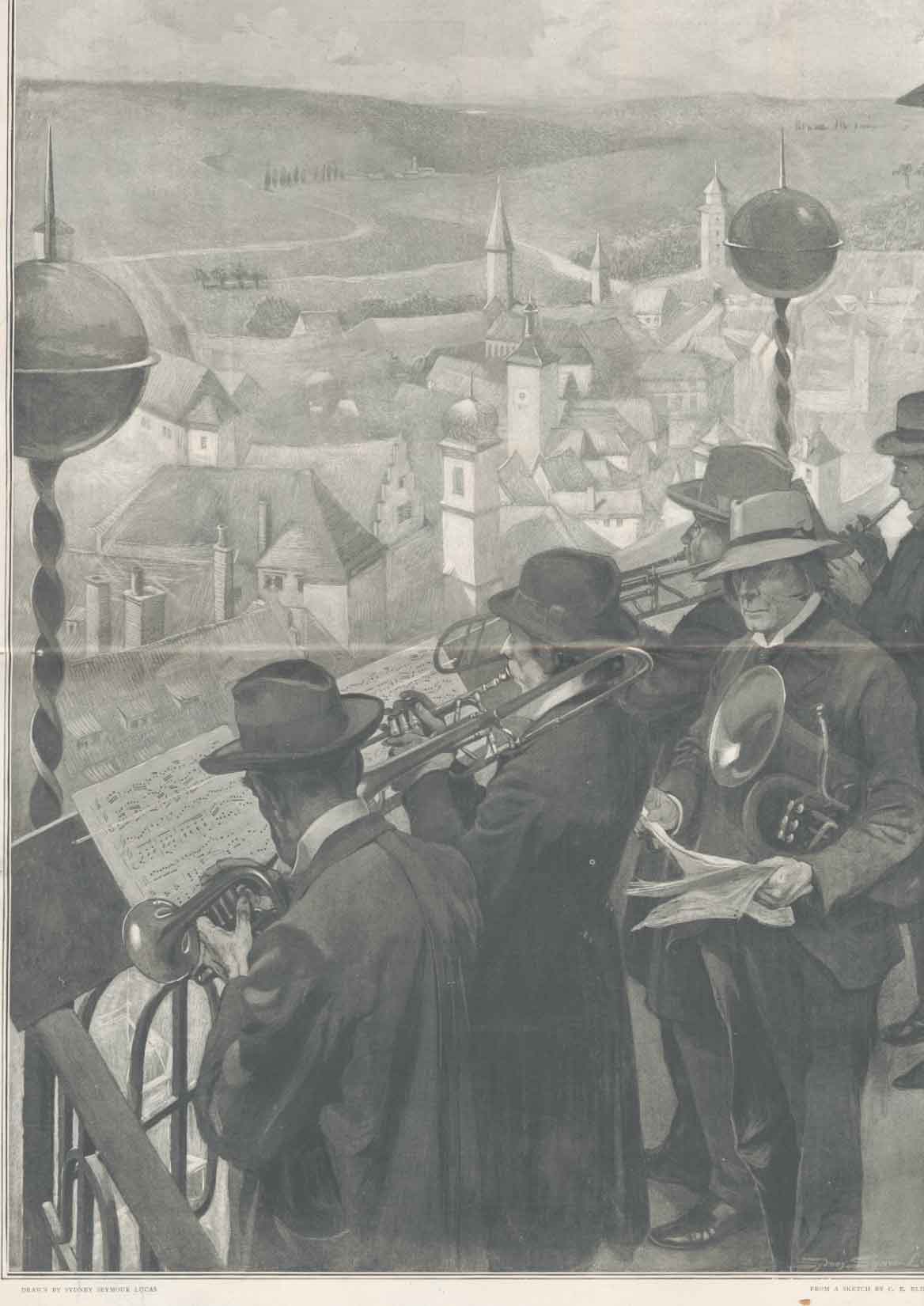
1906/07—Gustave Mahler, Symphony No. 8, calls for 7 trombones.
1907—London, England: George Case, Professor of Trombone at the Royal College of Music, says the following in response to F. W. Galpin’s famous article on the sackbut: “I am afraid that nowadays there is no chance of a return to what Mr. Galpin supposes was the tone of the sackbut in the 16th century, as, in the last hundred years, although the orchestras have doubled, the number of trombones remaining the same, the players are expected to blow loud enough to dominate the whole orchestra. I wish to point out that nothing is more unfair, or betrays ignorance of the facts in a greater degree, than the custom that obtains in this country of blaming the trombone-players, when the real offenders are to be found among the conductors or composers” (Case, Correspondence).
1907—England: Author George Bernard Shaw writes, “Many a sinner has played himself into heaven on the trombone, thanks to the Salvation Army.”
1907—Paris Conservatory morceau de concours: Henri Büsser, Piece in E-flat Minor.
1908—Salt Lake City, UT: The “Great Rose” window by F. X. Zettler of the House of Littler, Royal Bavarian Institute in Munich, Germany, is installed in the Cathedral of the Madeleine. Located behind the organ, the window features St. Cecilia surrounded by angel-musicians, including an angel-trombonist (see detail and full image below).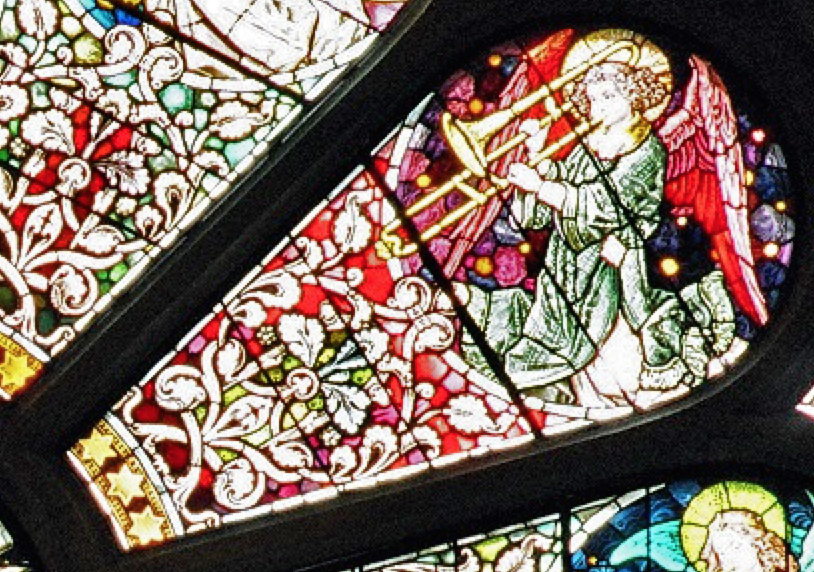
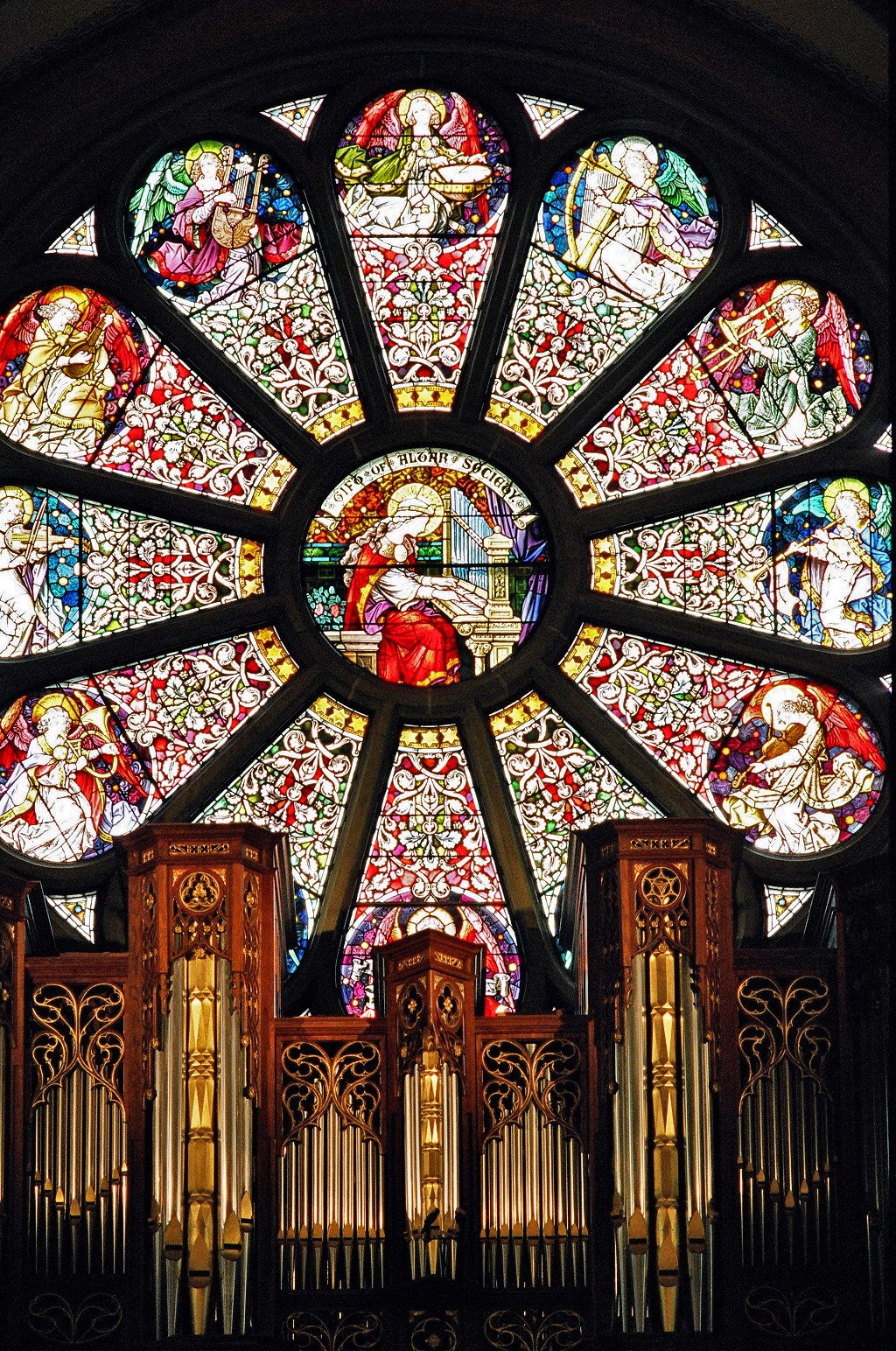
1908—France: A postcard with the caption “Carnaval de NICE. 1908 Char de la Musique” features a clown-trombonist (see below image; public domain) (musée des Civilisations de l’Europe et de la Méditerranée).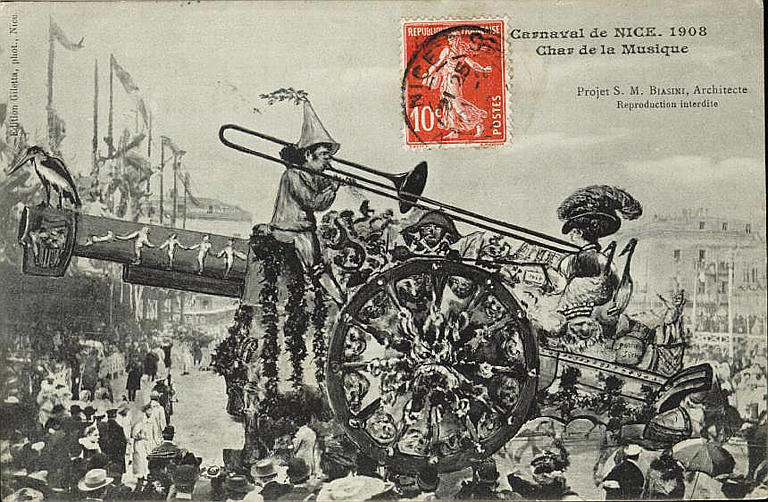
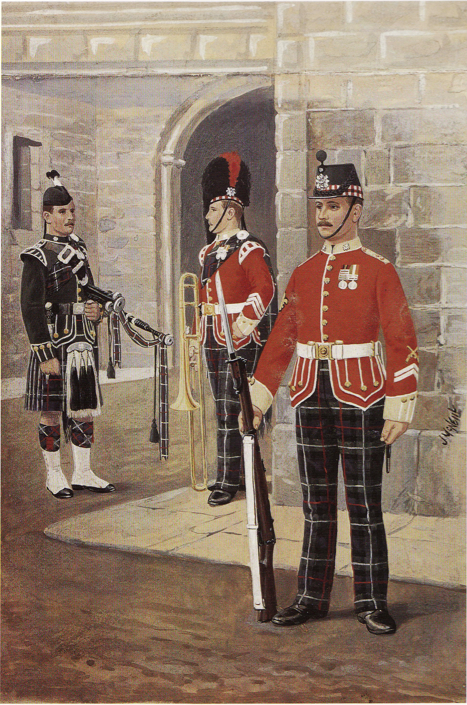
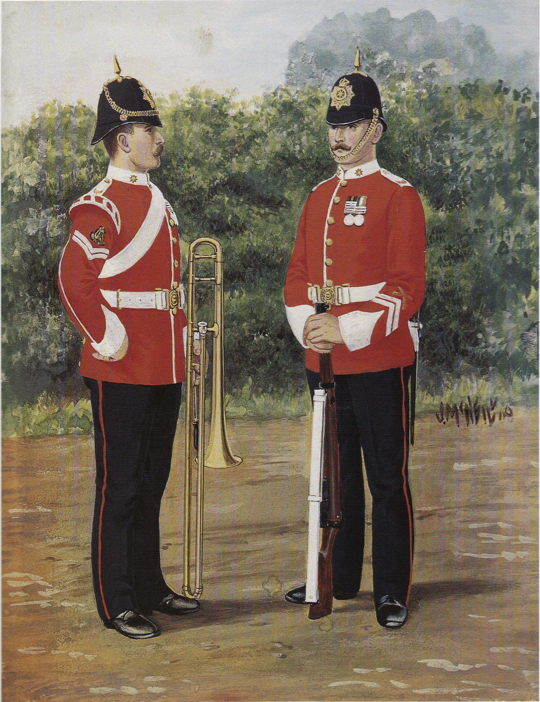 1908—England: Military illustrator John McNeil (b. 1872) paints numerous military watercolors for Gale & Polden, including two that feature trombone: Highland Light Infantry (see facing image; Harrington 10) and Worcester Regiment (see facing lower; Harrington 39) (images public domain). For a similar image, see c. 1885 in the 19th century timeline (2nd half).
1908—England: Military illustrator John McNeil (b. 1872) paints numerous military watercolors for Gale & Polden, including two that feature trombone: Highland Light Infantry (see facing image; Harrington 10) and Worcester Regiment (see facing lower; Harrington 39) (images public domain). For a similar image, see c. 1885 in the 19th century timeline (2nd half).
1908—Daniel Mason, in his book The Orchestral Instruments and What They Do: A Primer for Concert-Goers, first published in The New Music Review, says the following about trombone: “As the slide is capable of the most minute adjustments, the trombone need never be even slightly out of tune, as are certain notes of the horn and trumpet. Moreover, owing to its straight tube, free from those sharp corners introduced by valves, its air column vibrates more evenly and regularly, giving it a sonority incomparably rich. For pure four-part harmony in simple chords there is no medium like the quartet of trombones” (Mason 78). He also remarks, “The three trombones and tuba, forming what we may call for convenience the trombone choir, constitute the most powerfully sonorous group of the entire orchestra, capable of dominating everything else. It must be confessed that this choir is often used vulgarly in modern scores, for the sake of mere noise; Prout cleverly remarks of it that ‘like charity, it covers a multitude of sins.’ Properly used, nevertheless, it is incomparably noble and moving. It ‘suggests to the imagination,’ says M. Gevaert, ‘the idea of a power strange to man, superior to man: a power sometimes benign, sometimes sinister, but always redoubtable’” (Mason 80).
1908—Paris Conservatory morceau de concours: Guy J. Ropartz, Piece in E-flat Minor.
1908—L. J. DeBekker, in Stokes’ Encyclopedia of Music and Musicians, says, “Capable of such gradations of tone as can be otherwise obtained only from viol instruments or the human voice, the trombone is among the oldest of musical instruments in the world….The trombone has seven positions, defined by elongations of the tube, each with its series of open tube harmonics, and in the hands of a good performer produces very beautiful and absolutely true tones” (DeBekker).
1909—Altengrabow, Germany: A photograph of musicians posing in remembrance of the military training ground in Altengrabow includes three trombones (see below image; public domain).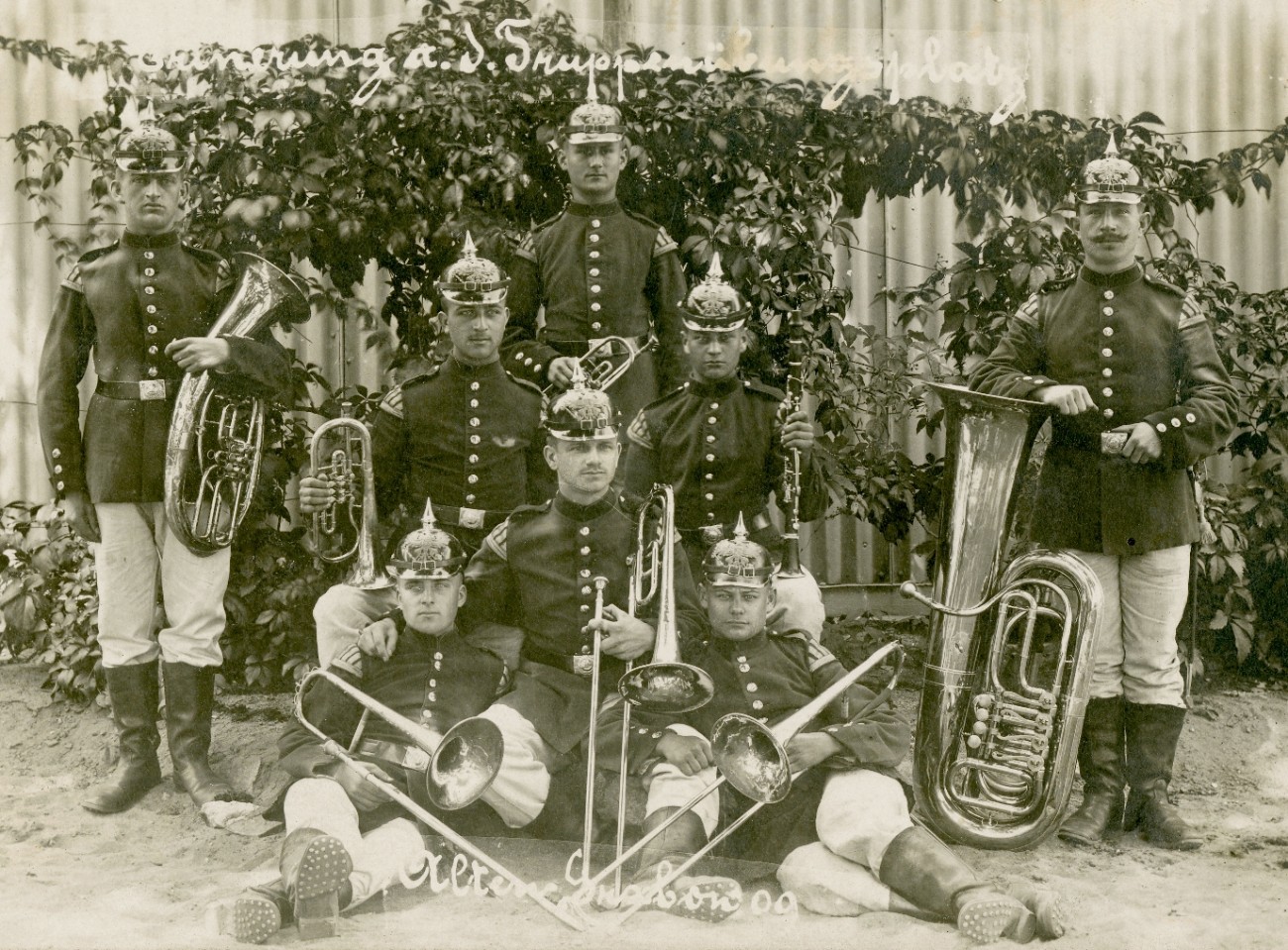
1909—Anton Webern’s 1909 version of Six Pieces calls for 6 trombones.
1909—Paris Conservatory morceau de concours: Théodore Dubois, Solo de Concert.
1909—Seattle, Washington: A postcard features a clown band at Luna Park, an amusement park in Seattle from 1907 to 1913. The postcard is labeled “LA. SOUSA CLOWN BAND/SEATTLE, WASH/SEASON—1909” (see below image; public domain) (Seattle Municipal Archives).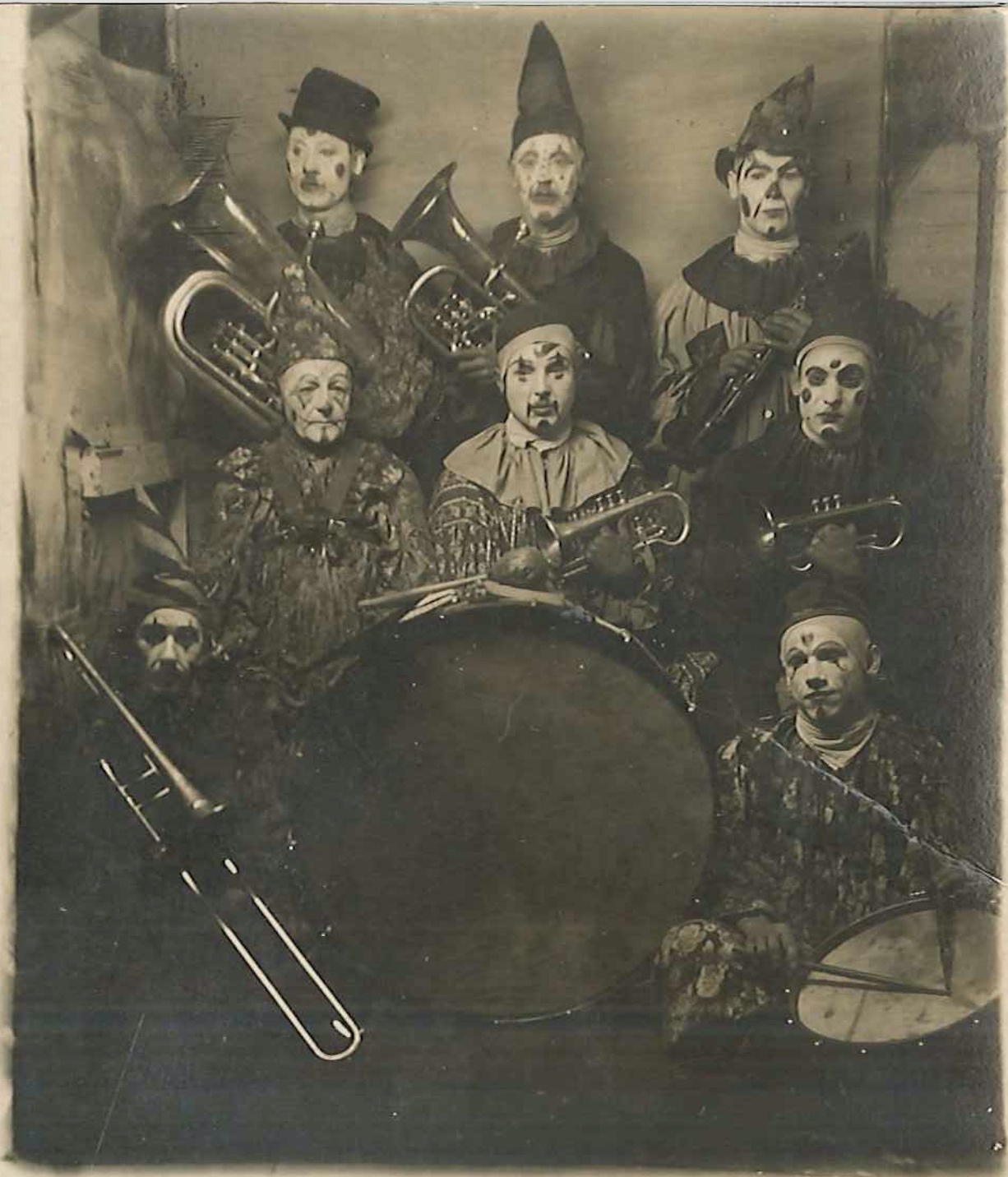
1909-12—Maurice Ravel’s Daphnis et Chloé requires a lip slur across the harmonics of nearly the full range of the trombone.
c. 1905—Harry Payne (1858-1927), an English military artist, includes trombone in a number of military band paintings. The images, depicting the Coldstream Guards, Royal Scots Greys (2nd Dragoons), Irish Guards, 17th Lancers, and 1st Royal Dragoons, are marketed as a series of oilette postcards (see below 5 images; public domain).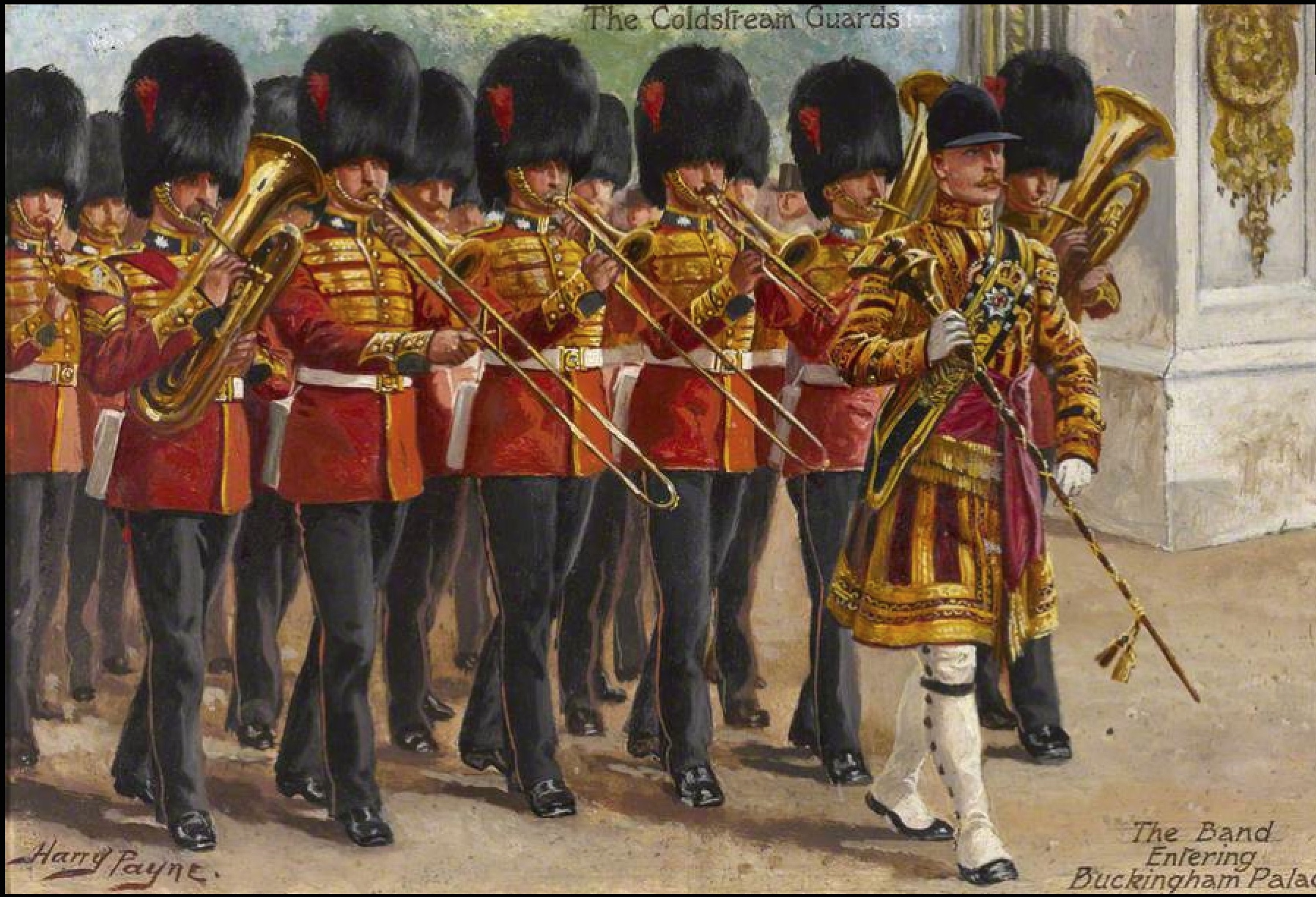
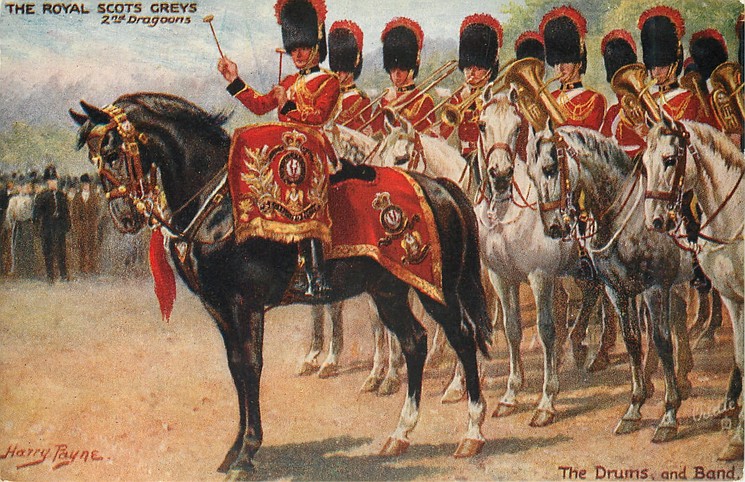
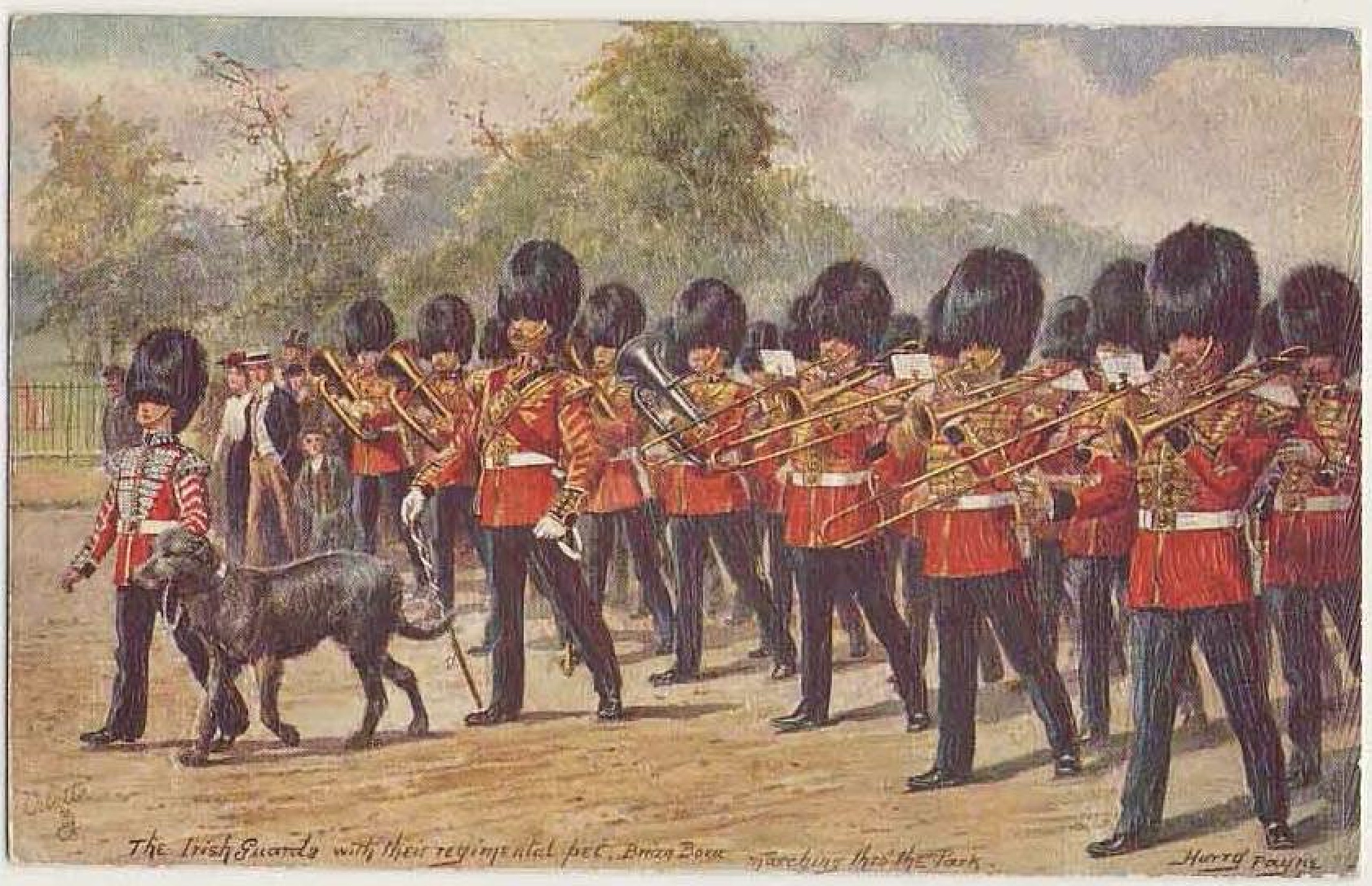

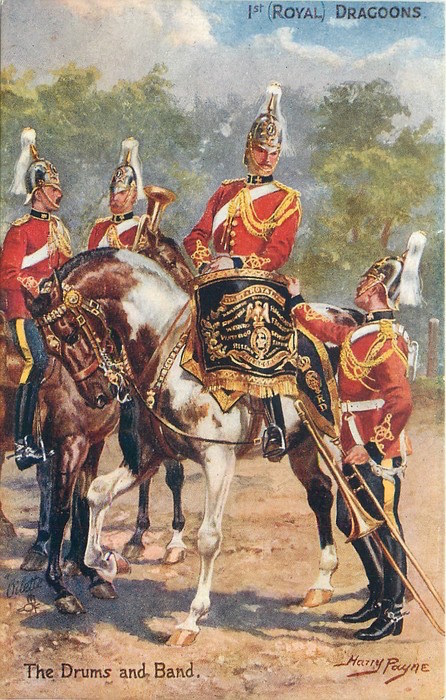
c. 1910—Germany: A New Year’s postcard by illustrator Alfred Mailick (1869-1946) depicts brass musicians playing from a balcony—probably a church tower (see below image; public domain). For a similar postcard, see 1904 (above).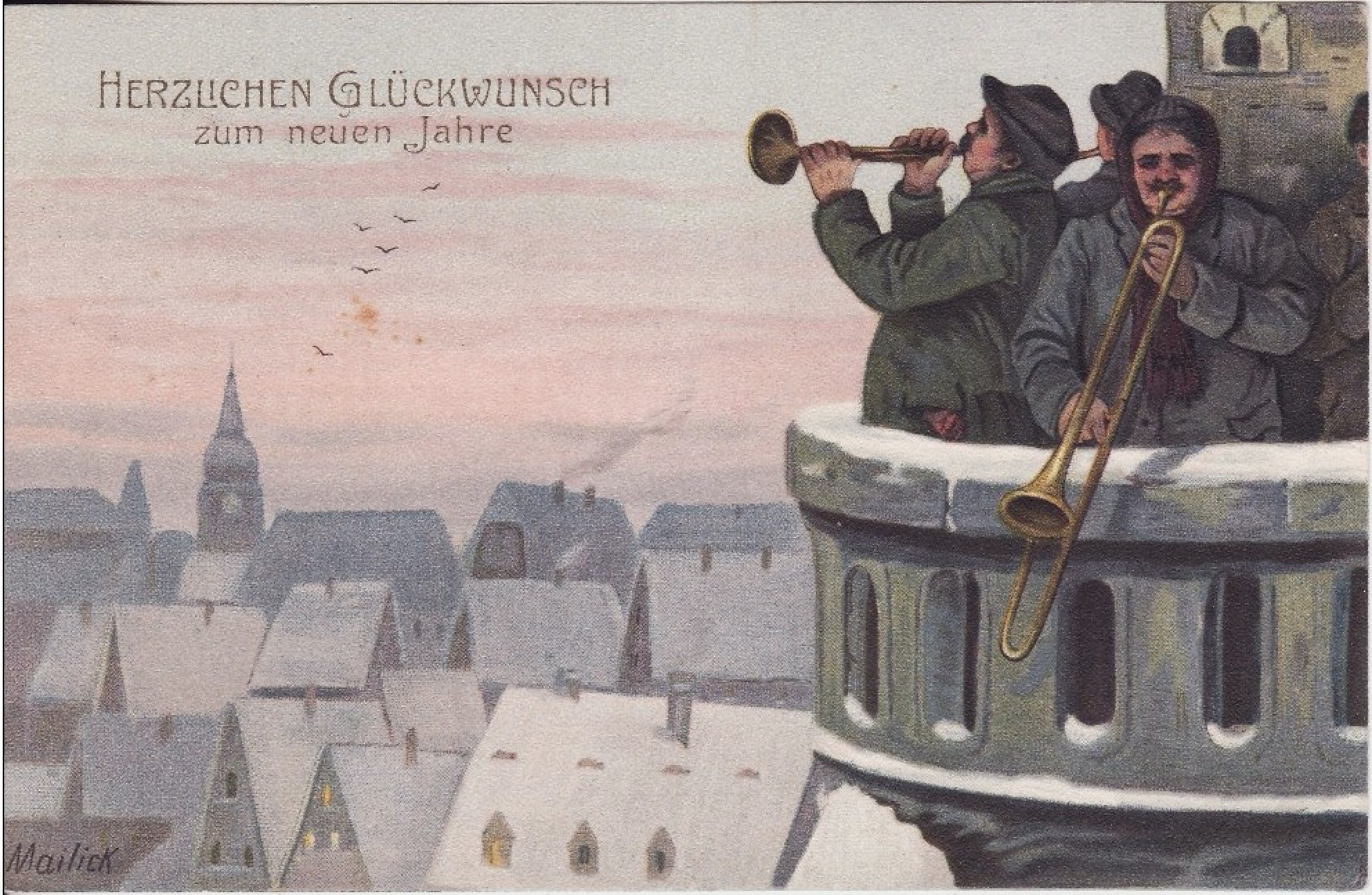
c. 1910—Landskrona, Sweden: A photograph of Salvation Army musicians includes a pair of valve trombones (see below image; public domain) (Landskrona Museum).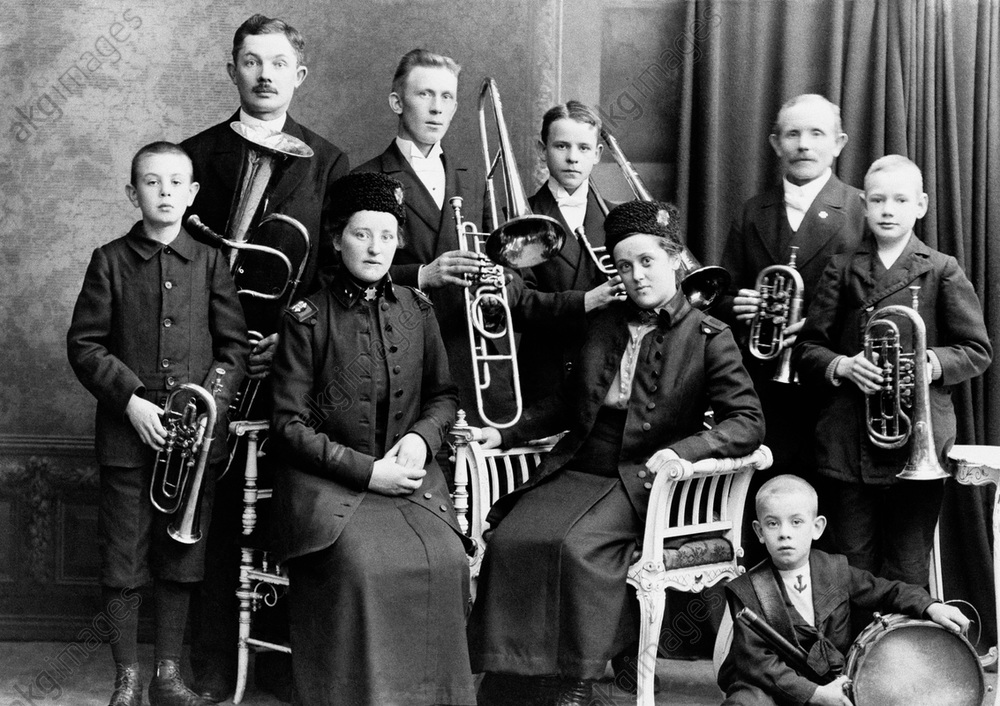
c. 1910—Reutlingen (Baden-Württemberg), Germany: Trombones continue to announce the death of a citizen with a death chorale from the church tower until well into the 20th century (Carter, Trombone Ensembles of the Moravian).
c. 1910—C. Alvin “Zue” Robertson, a New Orleans native, tours with the band that accompanies the famous Kit Carson Wild West Show. He becomes a member of the well-known Olympia Brass Band by the mid-1910s, later joining the jazz migration to Chicago. He performs in Chicago with jazz legends Jelly Roll Morton, King Oliver, and W.C. Handy. One of the few fellow trombonists to draw praise from Kid Ory, Robertson is described by Ory as “a smooth trombone–he was good…He lived a block from me. We practiced together…He was a good piano player and a good bass, too, studied piano, read music” (Dietrich 16).
c. 1910—Josef Serafin Alschausky (1879-1947 or 48), Konzert No. 1. Alschausky, a German trombonist, publishes at least 15 compositions for trombone. He plays principal trombone with Gewandhaus orchestra, emigrates to US, then plays with Cincinnati Symphony before moving to Los Angeles.
c. 1910—A 6-valve trombone is designed by Lebrun of Brussels in an attempt to correct intonation faults of the ordinary valve trombone (Gregory 123).
1910—Geißlingen (Baden-Württemberg, Germany: A group of brass players, gathered to play a wedding, poses for a portrait (see below image; public domain).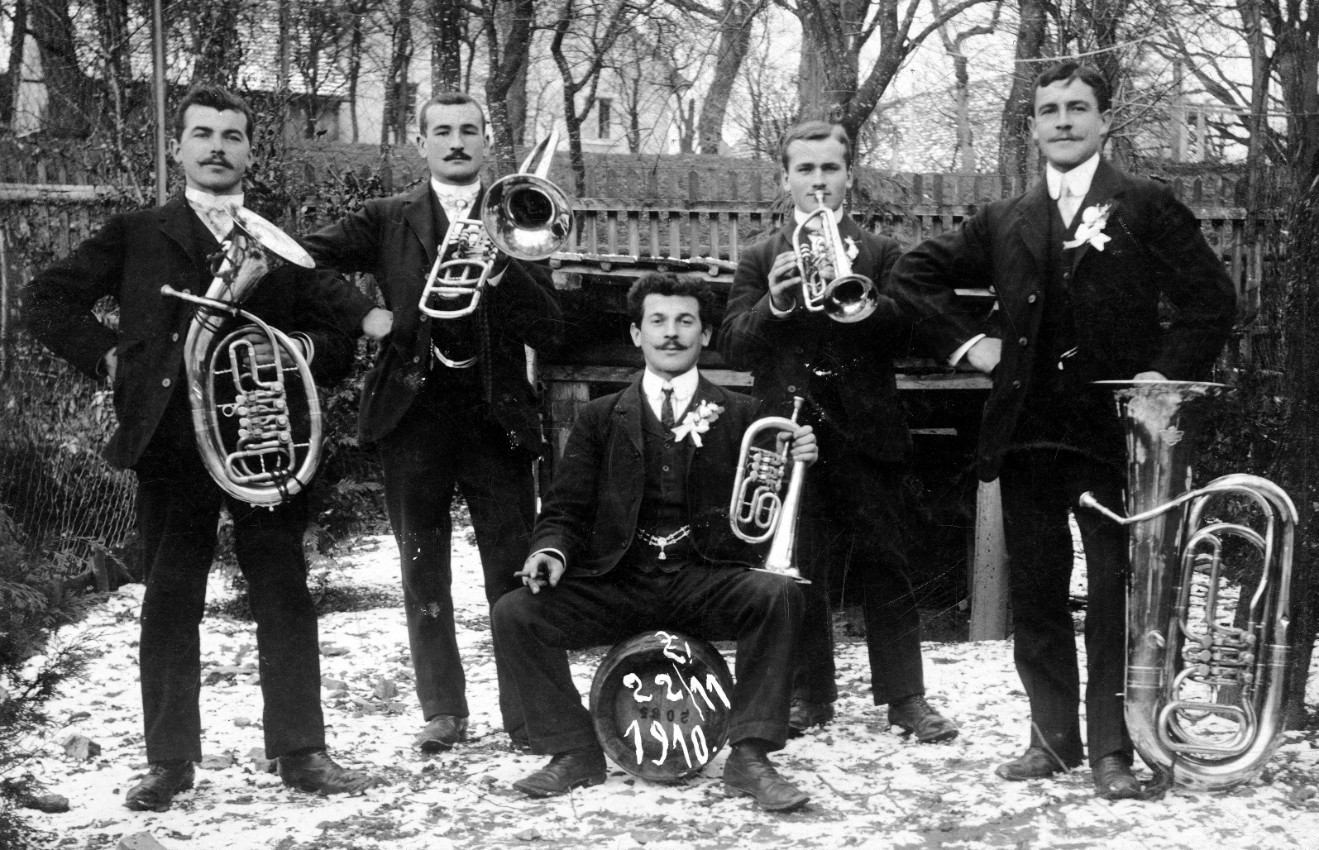
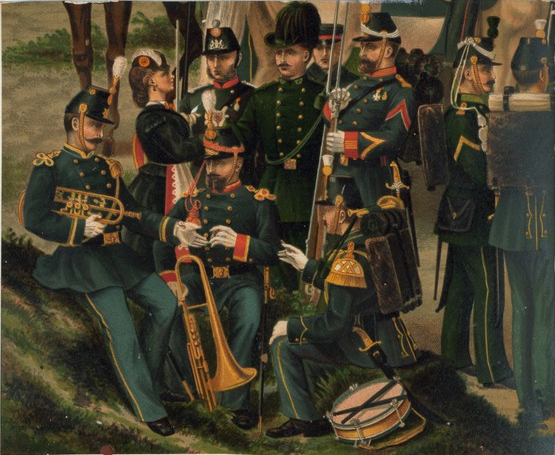 1910—Netherlands: A painting portraying a Dutch infantry band of 1864-90 includes a valve trombone (see facing image; public domain) (New York Public Library Digital Gallery, Vinkhuijzen collection of military uniforms).
1910—Netherlands: A painting portraying a Dutch infantry band of 1864-90 includes a valve trombone (see facing image; public domain) (New York Public Library Digital Gallery, Vinkhuijzen collection of military uniforms).
1910—England: According to Mansfield, Beethoven’s Equali are performed at the funeral of King Edward VII (Mansfield).
1910—George Andrews, writing about the state of orchestral trombone playing, says “The former style of playing was quiet and smooth, but gradually the mannerisms of band players have crept into the orchestra, until the present tone would doubtless be a blatant blare to Beethoven, Mozart or Schubert” (Andrews 226).
1910—Kathleen Schlesinger, in Instruments of the Modern Orchestra, says the following about trombone playing: “The legato style of playing is now dying out and giving place to the blare which is greatly to be regretted” (Schlesinger 79).
1910—Paris Conservatory morceau de concours: Carlos Salzedo, Piece de Concertante.
1910—Igor Stravinsky, Firebird.
1910—Spencer Frederick Gore includes trombones in the pit orchestra of his painting, Ballet Scenes from “On the Sands” (see below image; click to expand; public domain) (Yale Center for British Art).
1911—Klausenburg (now Cluj, Romania): A small theater orchestra made up of musicians of the Hungarian Infantry Regiment No. 51, with theater bandmaster Franz Lamberth, includes a valve trombone (see detail below; public domain) (Brixel, Österreichs Militär Musik).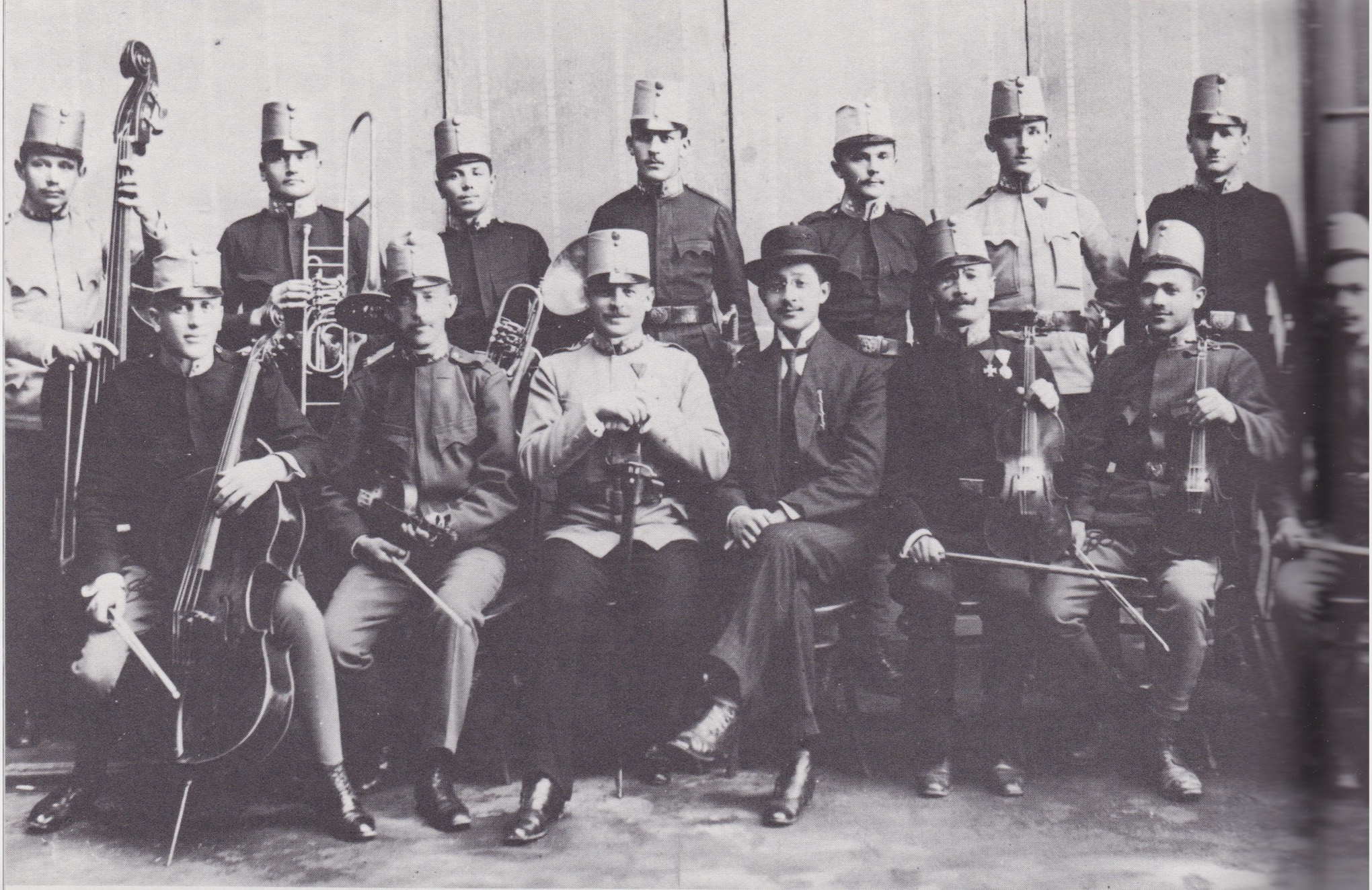
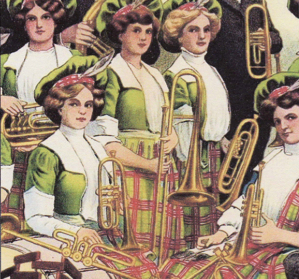
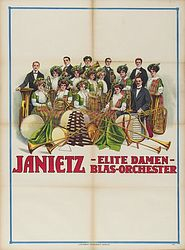 1911—Germany: A poster advertising “Janietz, Elite Damen Blas-Orchester,” a female brass band, includes 2 trombonists (see detail, far left, and full image, adjacent; public domain).
1911—Germany: A poster advertising “Janietz, Elite Damen Blas-Orchester,” a female brass band, includes 2 trombonists (see detail, far left, and full image, adjacent; public domain).
1911—Paris Conservatory morceau de concours: Eugene Cools, Allegro de Concert, op. 81.
1911/12—Paris, France: Paul Dukas, La Peri. The ballet begins with an extended brass fanfare.

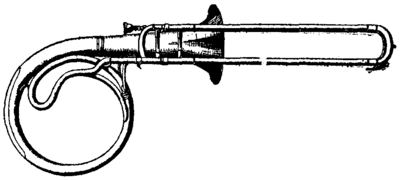 1911—Edinburgh, Scotland:Encyclopedia Britannica, in one of its most renowned editions, discusses several types of trombones, claiming there are six currently in use: “At present six trombones are more or less in use, viz. the alto trombone in F, the alto in E♭ (formerly in D), the tenor in B♭ (formerly in A), the bass in G, the bass in F (formerly in E), the bass in E♭ (formerly in D), and the contrabass in B♭.” The article also shows engravings of two somewhat unusual instruments: what it labels a double slide trombone (see upper image; public domain) and a contrabass trombone by Boosey & Co. (see lower image; public domain).
1911—Edinburgh, Scotland:Encyclopedia Britannica, in one of its most renowned editions, discusses several types of trombones, claiming there are six currently in use: “At present six trombones are more or less in use, viz. the alto trombone in F, the alto in E♭ (formerly in D), the tenor in B♭ (formerly in A), the bass in G, the bass in F (formerly in E), the bass in E♭ (formerly in D), and the contrabass in B♭.” The article also shows engravings of two somewhat unusual instruments: what it labels a double slide trombone (see upper image; public domain) and a contrabass trombone by Boosey & Co. (see lower image; public domain).
1911/13—Arnold Schoenberg, Gurre-Lieder, calls for 7 trombones, including alto and contrabass.
 1912—Milan, Italy: Rotary valve trombone by Giovan Battista Cazzani is manufactured sometime before this date (see above image; used by permission of Brass Players Museum: www.neillins.com/brass.htm).
1912—Milan, Italy: Rotary valve trombone by Giovan Battista Cazzani is manufactured sometime before this date (see above image; used by permission of Brass Players Museum: www.neillins.com/brass.htm).
1912—Milan, Italy: In Ettore Panizza’s 2nd revised and updated Italian edition of Berlioz’s orchestration treatise, Panizza discusses contrabass trombone: “Berlioz does not mention the contrabass trombone. Its pitch corresponds to an octave below that of the tenor trombone. In Italy the introduction of a new instrument of this type was due to Giuseppe Verdi, and it adopted the name of this great musician. I refer to the ‘trombone basso Verdi’ in B flat. Its tone is fine, mellow and homogeneous, especially in its middle range, while being slightly weak in the bottom and high register. It is notated at concert pitch, that is the written note is the actual note sounded, in spite of the instrument being pitched in B flat. Verdi, who, as we have seen, had been its inspiration, wrote an important part for it in his Otello and later in Falstaff. Today this trombone has become very common in Italian orchestras, and almost all the parts for ophicleide or for tuba are played on the trombone Verdi” (Meucci).
1912—Paris Conservatory morceau de concours: Philippe Gaubert, Morceau Symphonique.
1913—New York: Humorist-author Irvin S. Cobb writes, “I am also partial to band music. When John Philip Sousa comes to town you can find me down in the very front row….And three or four of the trombonists pull the slides way out and let go full steam right in my face, with a blast that blows my hair out by the roots, and all hands join in and make so much noise that you can’t hear the music. And I enjoy it more than words can tell!” The above image accompanies Cobb’s commentary (illustrations by Peter Newel and James Preston) (see below image; public domain) (Cobb 65).
1912—Kaikorai, New Zealand: A trio of trombonists poses in military uniform (see below image; public domain) (Hocken Collection, University of Otago Library).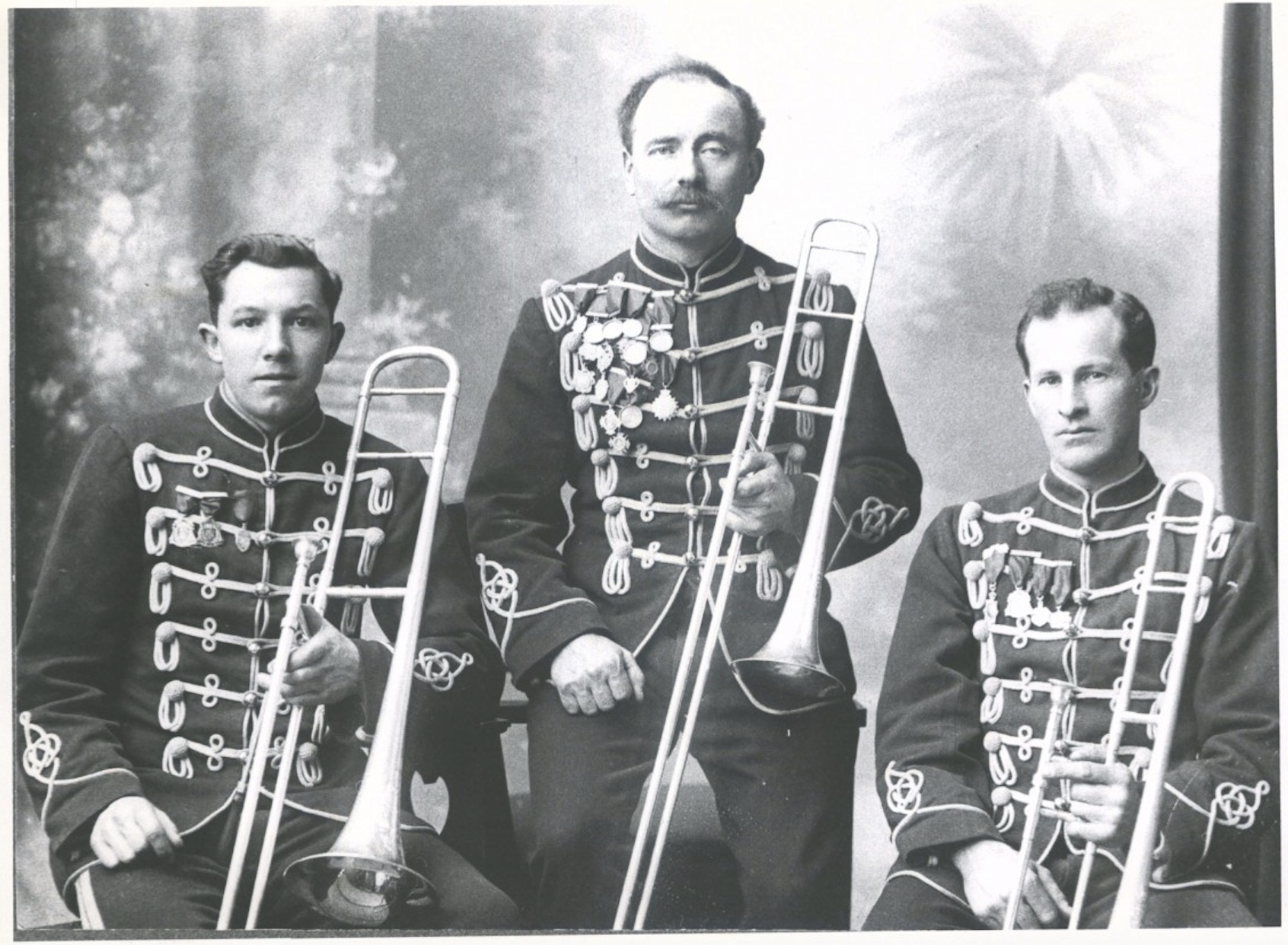
1913—Paris Conservatory morceau de concours: Henri Büsser, Cantabile et Scherzando.
1913—Dresden, Germany: A quartet of brass players poses for a portrait (see below image; public domain).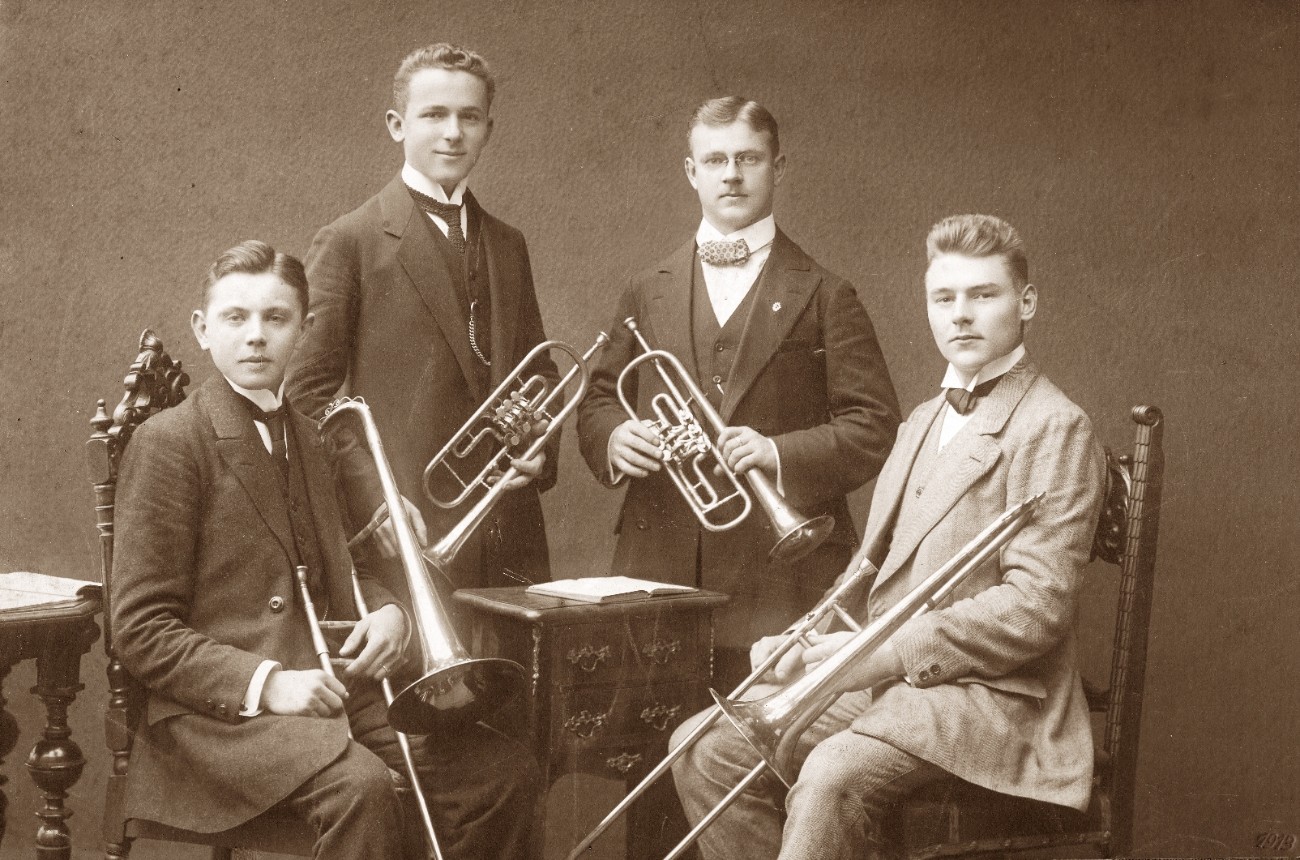
1913—A poster advertising the silent movie comedy, Zeb’s Musical Career, shows a group of people observing a trombone player. The caption reads, in part, “There may have been music in Zeb’s soul, but there was none in his trombone” (see facing image; public domain).
1914—New Orleans, Louisiana: A band led by trombonist Tom Brown is hired to accompany a New Orleans vaudeville act. According to historians, the band creates so much interest that the “music almost overwhelmed the two vaudevillians.” The band is later invited to perform in Chicago (where it bills itself as “Brown’s New Orleans Jass Band”) and New York, eventually changing its name to the Five Rubies (Dietrich 16).
1914—Paris Conservatory morceau de concours: Sigismond Stojowski, Fantaisie.
1914—England: Cecil Forsyth, in his book Orchestration, says, “It is worth noting that the Trombone player depends solely on his ear for his correct intonation….He makes his notes just as the String-player makes his. Thus he has the opportunity of a nice accuracy in judgment, and it is only necessary to hear four clever Trombone-players exercising this judgment by playing an ‘equale’ in the pure untempered scale to be made aware how delightfully musical is the essential character of the instrument” (Forsyth 139).
1914—England: An illustration shows a trombonist from the British Royal Artillery in full military uniform (see below image; public domain).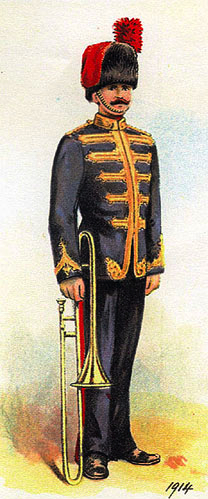 1914—England: Cecil Forsyth says the following about bass trombone and contrabass trombone in his orchestration text: “…our G-instrument—already, perhaps, the most tiring instrument to play in the orchestra—is much more manageable than the continental F-Trombone. This somewhat counterbalances its obvious disadvantages when required to ‘cry out from the depths’” (Forsyth 140). ”With regard to the Double-Bass-Trombone, it may be questioned whether in its manufacture the limits of human lungs and lips have not been overstepped. The difficulties of adequate tone-production, to say nothing of execution, are terrific” (Forsyth 143).
1914—England: Cecil Forsyth says the following about bass trombone and contrabass trombone in his orchestration text: “…our G-instrument—already, perhaps, the most tiring instrument to play in the orchestra—is much more manageable than the continental F-Trombone. This somewhat counterbalances its obvious disadvantages when required to ‘cry out from the depths’” (Forsyth 140). ”With regard to the Double-Bass-Trombone, it may be questioned whether in its manufacture the limits of human lungs and lips have not been overstepped. The difficulties of adequate tone-production, to say nothing of execution, are terrific” (Forsyth 143).
1914—Germany: A happy birthday postcard printed in Germany features a child playing trombone (see below image; public domain; Universität Osnabrück).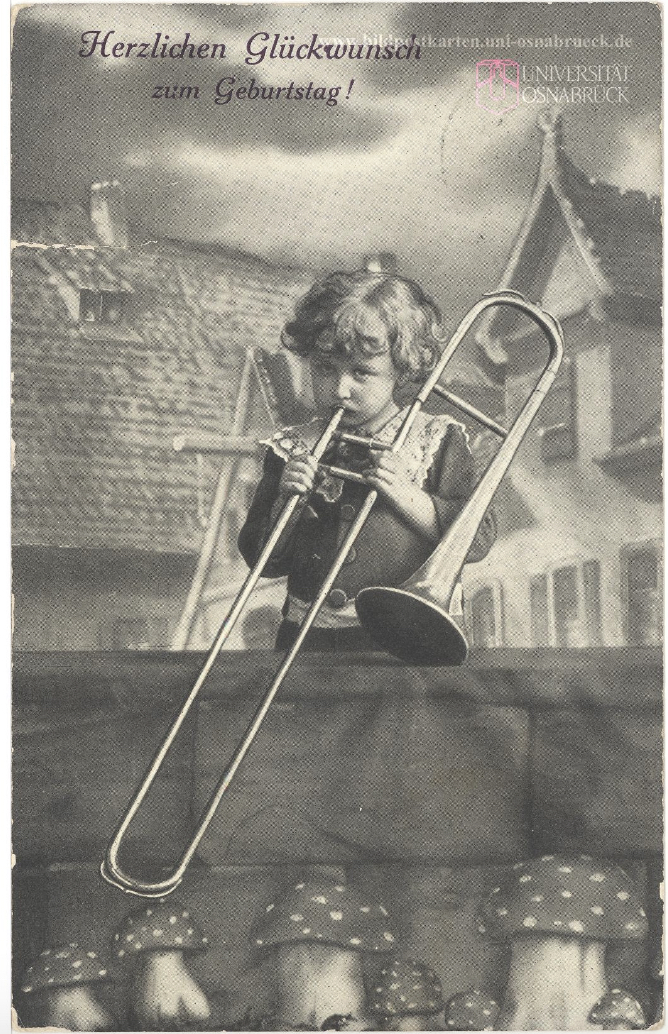
1914—Before this date, an oil painting by Alexander Pock depicts military musicians of the Hungarian Infantry Regiment No. 52 (see below image; public domain) (Brixel, Österreichs Militär Musik).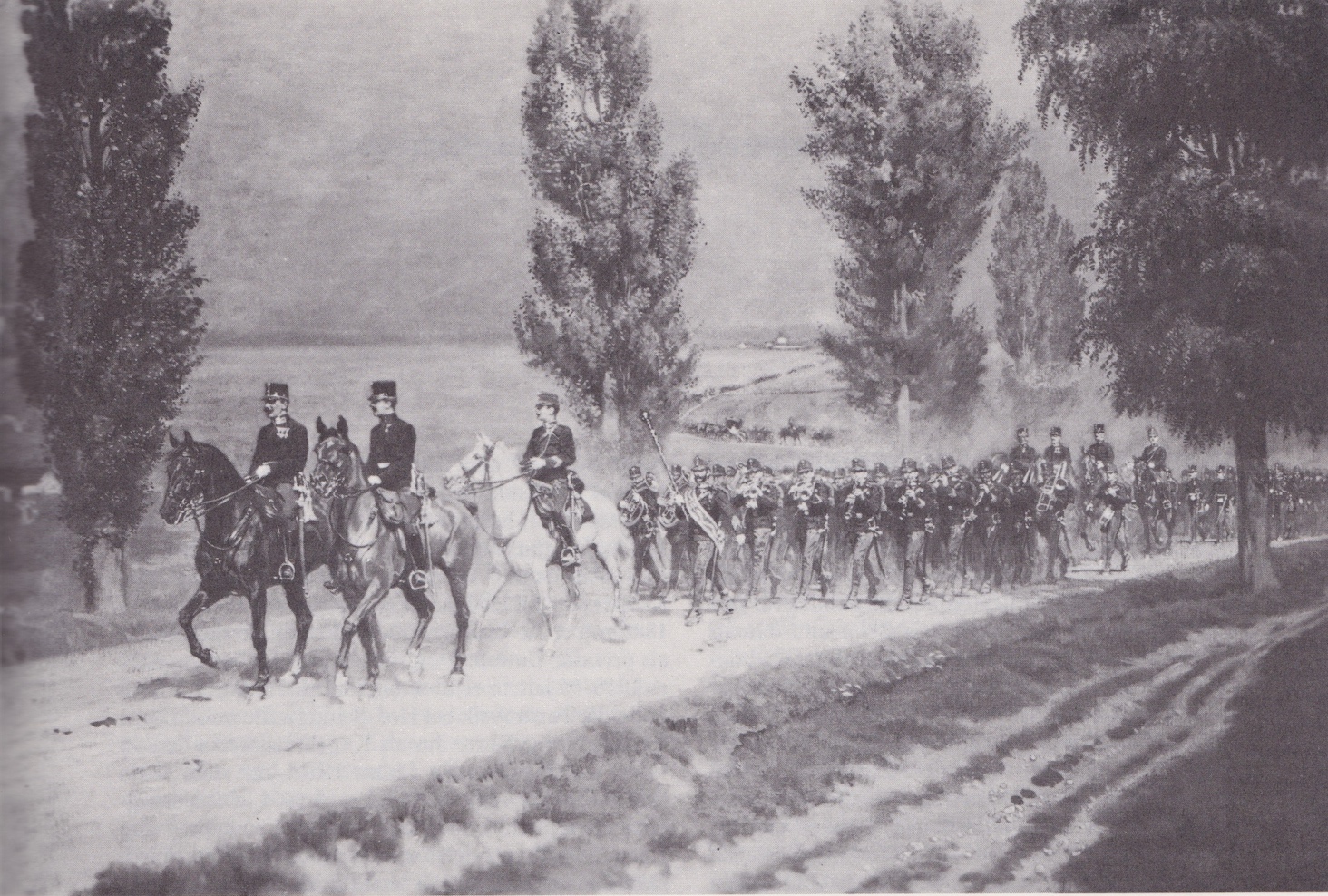
c. 1915—Thuringia, Germany: A photograph of a Thuringian military band (Thüringisches Infanterie-Regt Nr. 95) includes multiple trombones (see below image; public domain).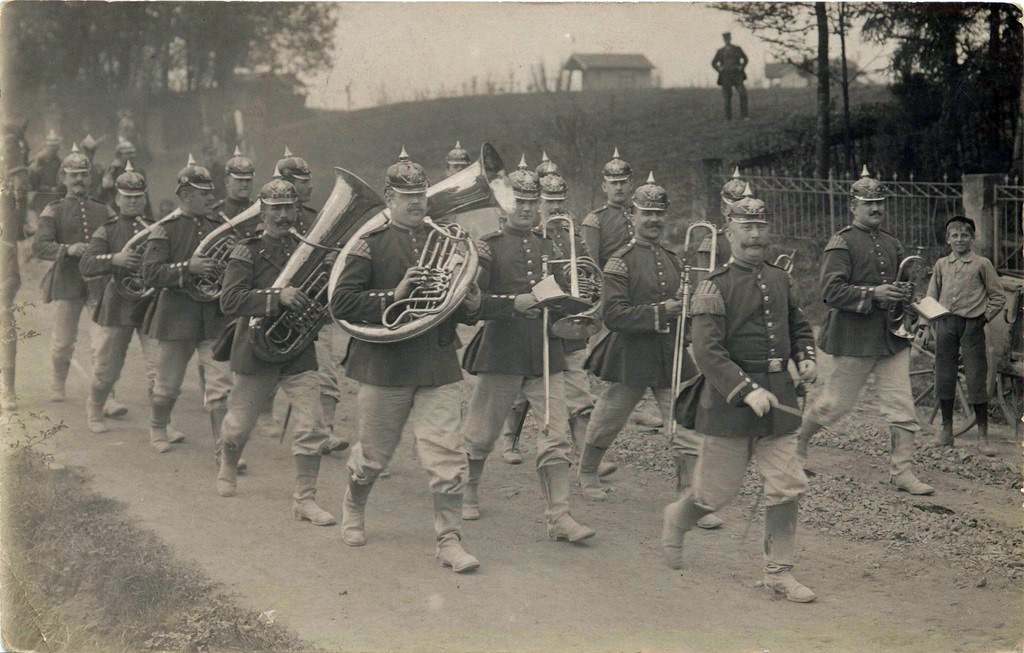
c. 1915—A photo of the trombone section of the US Marine Band shows the following players (from left): Pater Hazes, Robert E. Clark, Lee Sanford, and Louis M. Kruger (see below image; public domain) (source: US Marine Band website).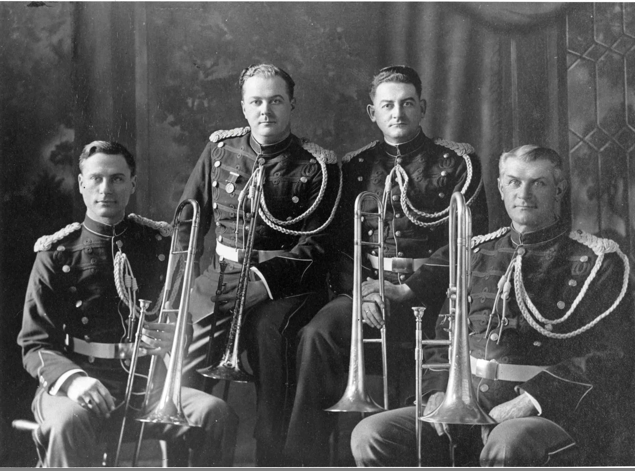 c. 1915—United States: American illustrator John Wolcott Adams (1874-1925) depicts a trombone ensemble playing from a belfry in The Trombone Players Climb the Steep Belfry Stairs to Blow Stately Chords (see below image; public domain). For a similar image, see 1903 (above); for additional images of 20th century tower-trombonists, see 1904, 1906 (above).
c. 1915—United States: American illustrator John Wolcott Adams (1874-1925) depicts a trombone ensemble playing from a belfry in The Trombone Players Climb the Steep Belfry Stairs to Blow Stately Chords (see below image; public domain). For a similar image, see 1903 (above); for additional images of 20th century tower-trombonists, see 1904, 1906 (above).
1915—Paris Conservatory morceau de concours: Camille Saint-Saëns, Cavatine. 1915—Trombonist Gardell Simons joins the Philadelphia Orchestra, where he remains until 1930 (Kupfurberg 226). 1915—Alban Berg’s Three Pieces for Orchestra utilizes trombone extensively, particularly in the 3rd piece.
c. 1916—Chicago, Illinois: A photograph of Chicago Salvation Army Band members shows tuba, trombone, horns, trumpets, and cornet (see below image; public domain) (Chicago Daily News negatives collection, DN-0066937. Courtesy of the Chicago Historical Society). The related quote by George Bernard Shaw, from only a few years earlier, is “Many a sinner has played himself into heaven on the trombone, thanks to the Salvation Army” (1907).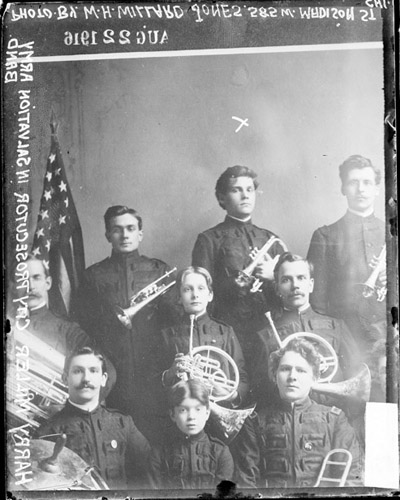
1916—Orlando Mansfield, speaking of activities of the London Trombone Quartet, says, “Their employment at state funeral ceremonies seems now to be fairly well established” (Mansfield).
1916—Orlando Mansfield reports, “To-day the German choral is often given out, or strengthened, by a trio or quartet of trombones, or even played by a ‘Posaunenchor’ from a church tower on the mornings of great festivals” (Mansfield).
1916—Orlando Mansfield relates the experience of a “Dr. Stone” with an apparently unusual ensemble: “That noted English musical scientist, the late Dr. Stone, relates that being ‘requested to lead the singing in the open air at the laying of the foundation stone of a church’ he used a quartet consisting of a slide trumpet, alto and tenor trombones, with euphonium and contrafagotto in octaves for the positive bass.’ He declares that ‘with good playing’ the result was ‘striking and, perhaps, deserving of imitation’” (Mansfield).
1916—Illinois: A circus poster from the Interscholastic Circus features a clown playing valve trombone (see below image; public domain).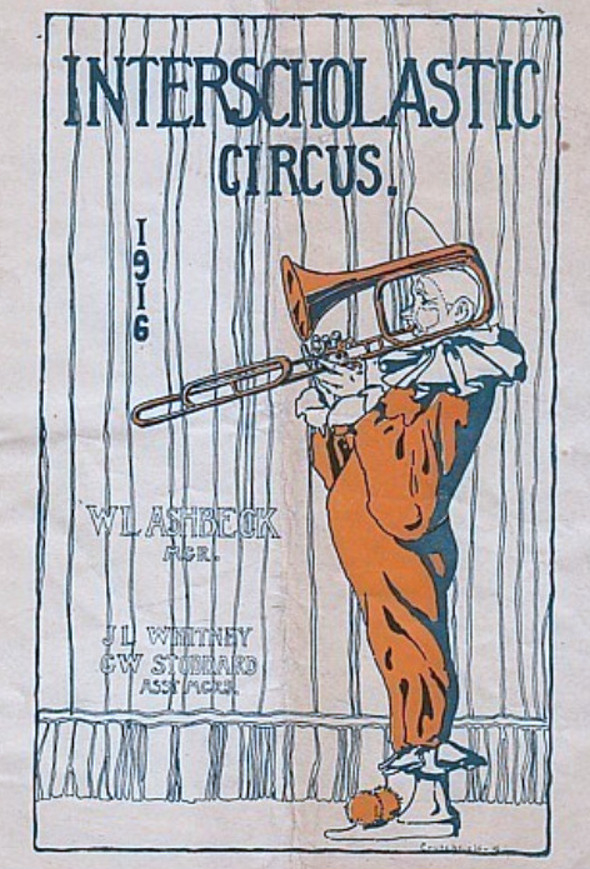
1916-1918—Znaim (Znojmo), Czech Republic: A photograph shows musicians of the Imperial & Royal Moravian Infantry Regiment No. 99, holding “Ventilposaune, Waldhorn, Armeeposaune” (see below image; public domain) (Brixel, Österreichs Militär Musik).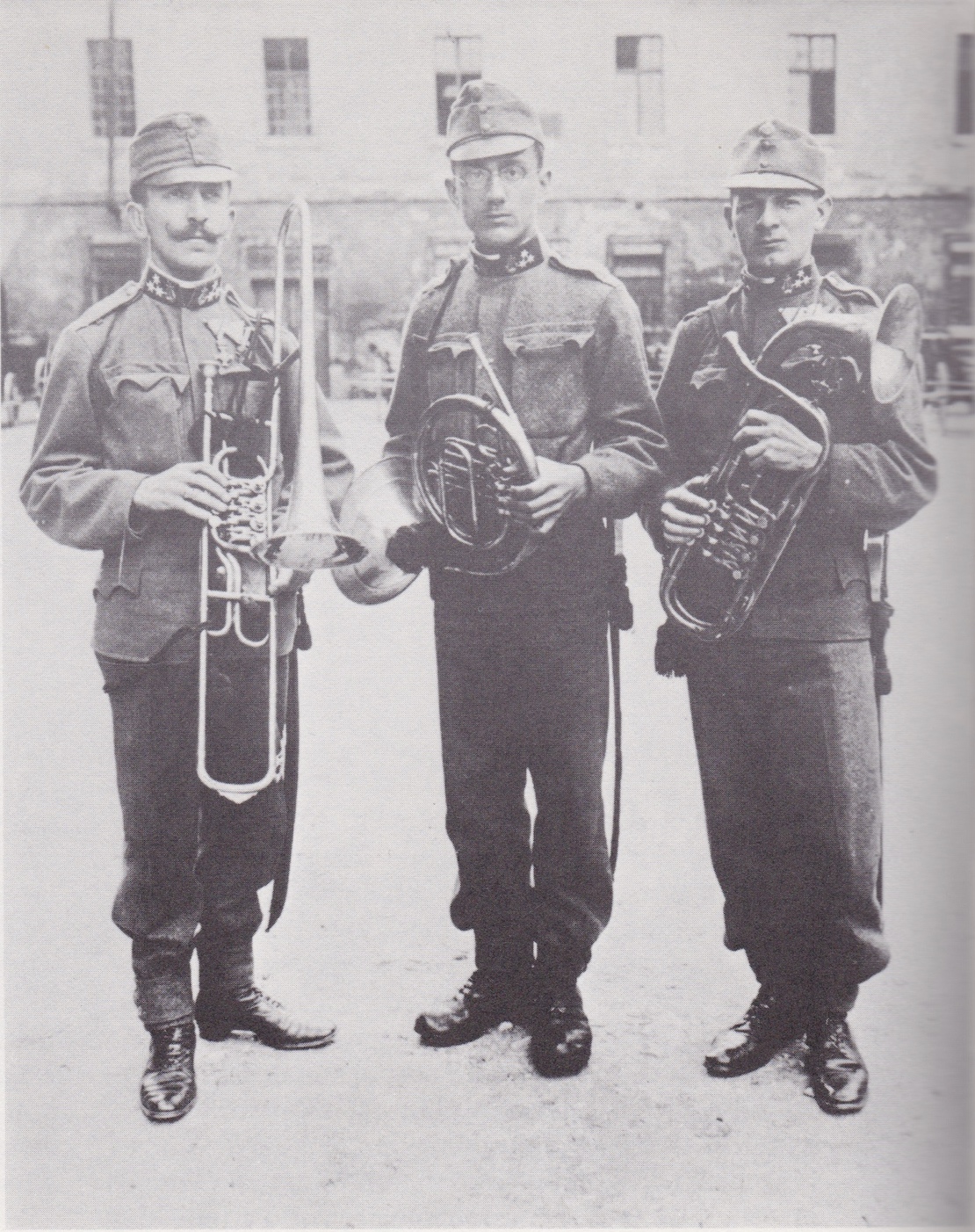
c. 1917—A photo postcard features an elaborately-uniformed trombone player, probably from the Municipal Band of Harrisburg, Pennsylvania (see below image; public domain) (source: temposenzatempo).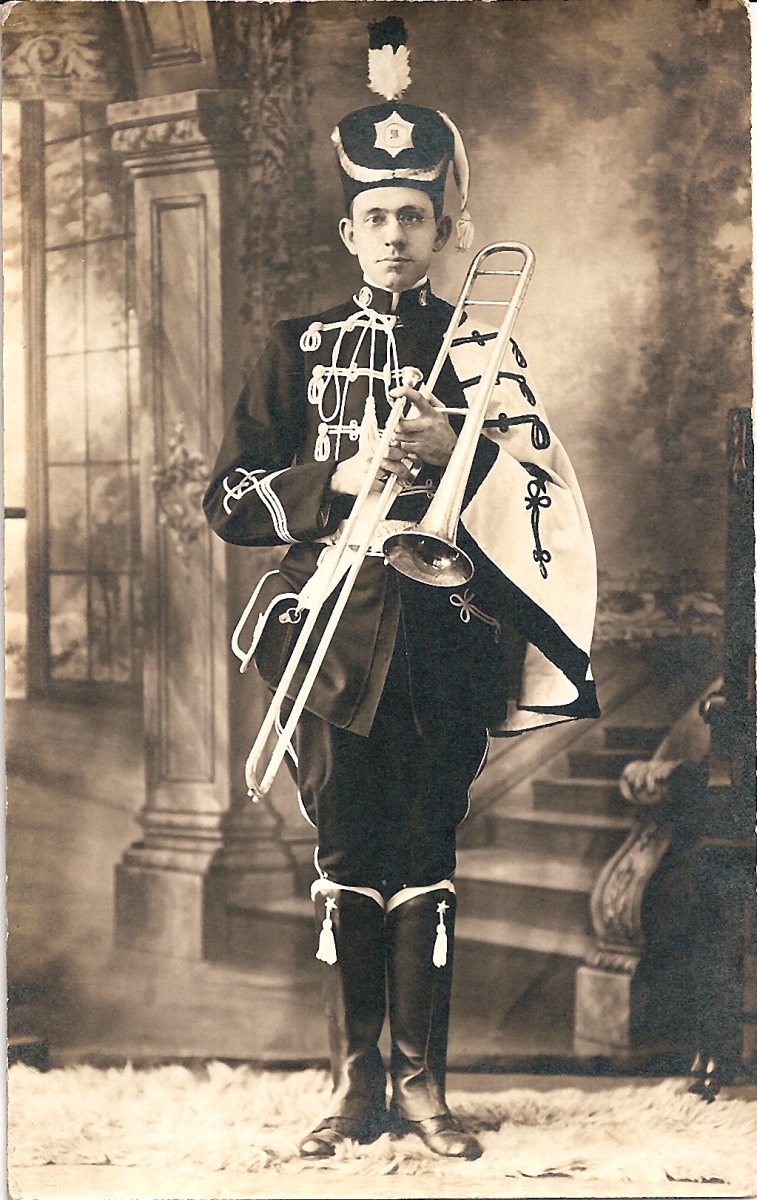
1917—Ottorino Respighi, Pines of Rome.
1917—New Orleans, Louisiana: Trombonist Eddy Edwards, performing as a member of the Original Dixieland Jazz Band, participates in the first commercial recordings of what is advertised as jazz. Edwards is considered by some to be the first jazz trombonist to gain national fame (Dietrich 17).
1917—Herb Flemming, one of the few early jazz trombonists not from New Orleans (he was born in Montana but moved to New York as a youth), goes to France with James Reese Europe’s 369th US Infantry Band (the “Hell Fighters’). One of the most internationally active early jazz trombonists, Flemming later tours throughout Europe, South America, and even China. During his time spent in the US, Flemming records with Ethel Waters and trumpeter Johnny Dunn, as well as performing with such legendary band leaders as Earl Hines, Fats Waller, Benny Carter, and Tommy Dorsey (Dietrich 17).
c. 1918—Memphis, Tennessee: A photograph of W. C. Handy’s Memphis Orchestra shows 8 instruments, including slide trombone (see below image; public domain; source: wikimedia commons).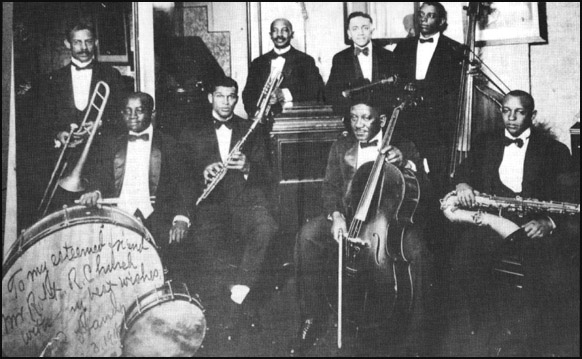
1918—A photograph of Charlie Chaplin shows him trying to play the trombone in his studios as two bystanders plug their ears (see detail and full image below; public domain). Special thanks to Ken Shifrin.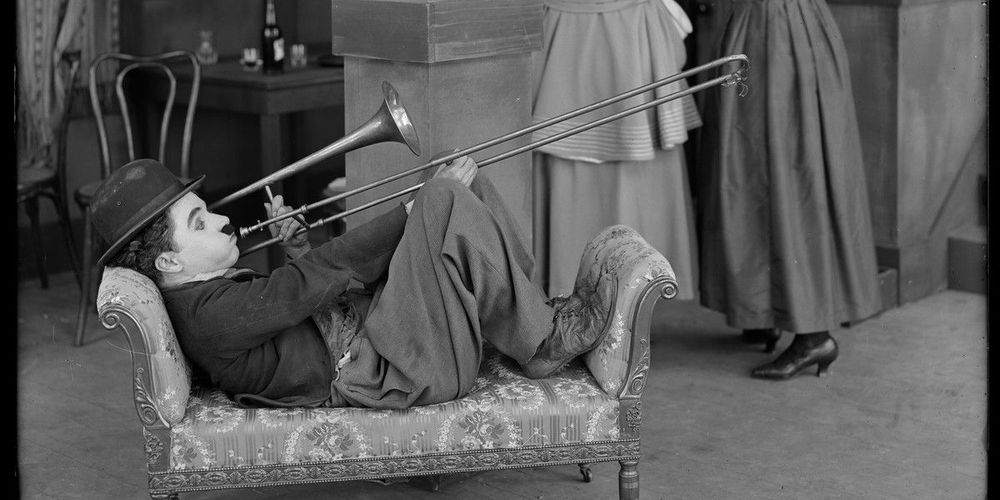
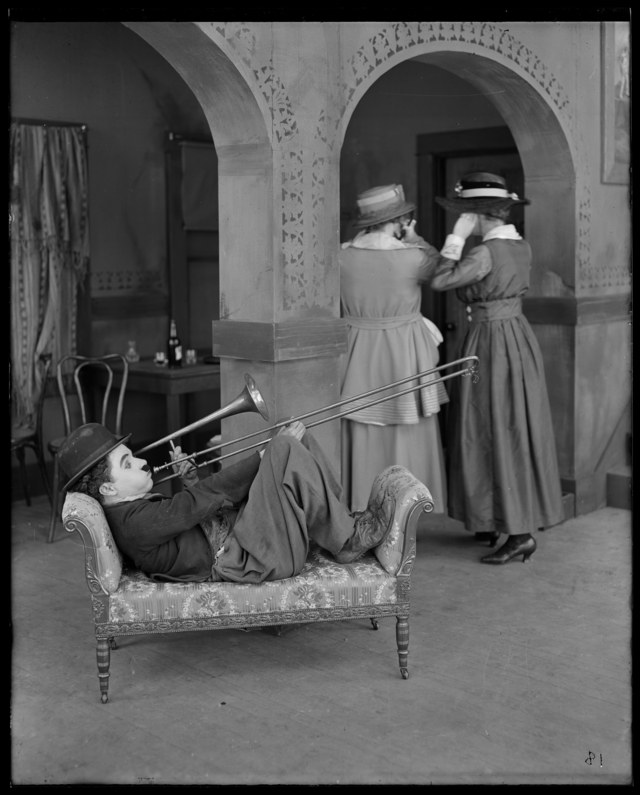
1918—Igor Stravinsky’s septet, The Soldier’s Tale, makes extensive soloistic use of trombone. The performance in the below YouTube clip begins at 11:40.
1918—Paris Conservatory morceau de concours: Samuel Alexandre Rousseau, Piece Concertante.
1919—Béla Bartok, Miraculous Mandarin. The piece uses trombones heavily and, according to Simon Wills, “contains more trombone glissandos than are found in any other orchestral work in existence” (Wills, Frontiers 174).
1919—Paris Conservatory morceau de concours: Pierre de la Nux, Solo de Concours.
1919—Henry Fillmore writes what is probably the earliest jazz trombone method book, Jazz Trombonist for Slide Trombone, Bass Clef…a Unique Treatise Showing How to Play Practical Jazzes, and How and Where to Insert them in Plain Trombone Parts (Dudgeon 197).
1919—New York: George F. Briegel’s “Slide, Kelly, Slide” is recorded. Subsequent published sheet music includes a trombone image (see below image; public domain).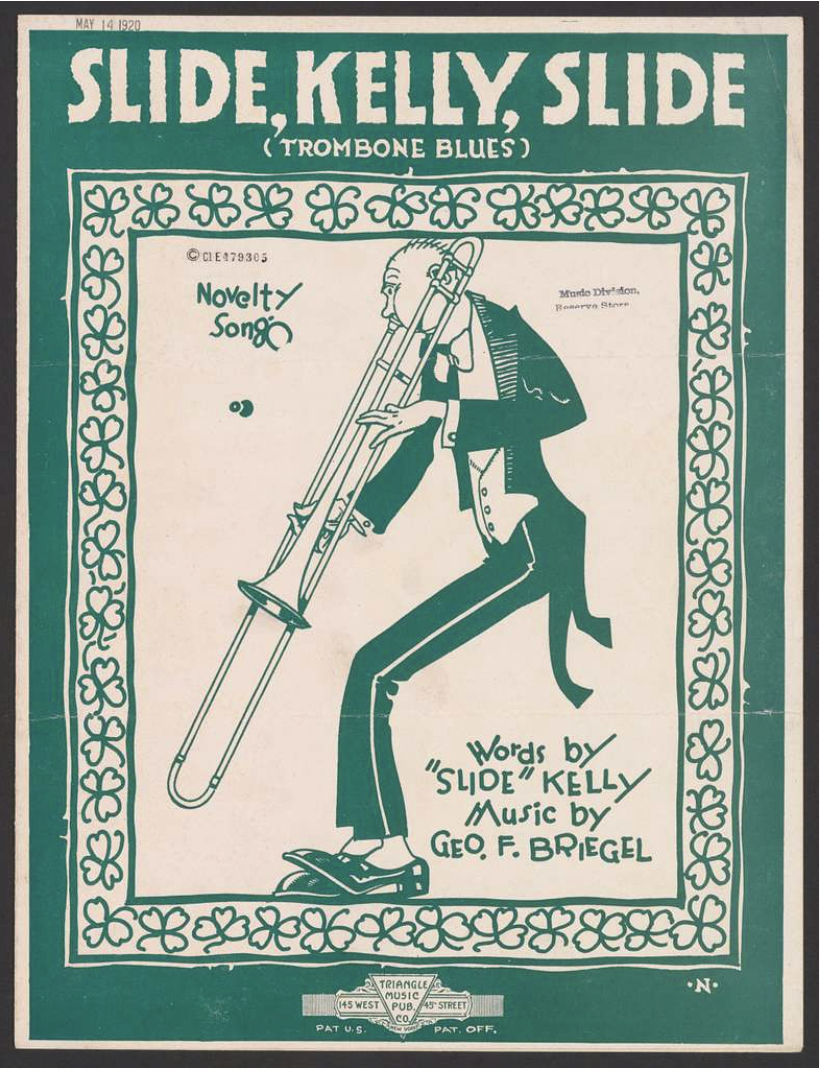
1920—Igor Stravinsky, Pulcinella. (See especially 1:05 in below clip.)
1920—London, England: Darius Milhaud visits London, where he hears live jazz—Billy Arnold and his band from New York—and is impressed with the “extremely subtle…use of timbre,” including “the lyrical use of the trombone, glancing slidingly over quartertones in crescendos of volume and pitch, thus intensifying the feeling” (Fisk 310).
1920—According to the memoirs of trombonist Anton Hansen (1877-1947), principal trombonist of the Tivoli Symphony (Denmark), Jean Sibelius promises to write him a trombone solo on 2 different occasions, once in person (1920) and again in a letter (1922). The piece was either lost or never written.
1920—Mendelssohn’s popular but difficult-to-trace quote appears in slightly modified form in Daubeny’s book, Orchestral Wind Instruments: “Mendelssohn may be said to have established for the trombone its present position in the orchestra, but personally he was rather inclined to hold it in reserve, for, said he, ‘it is too solemn an instrument to use except on very special occasions’” (Daubeny 96).
1920—Daubeny, in his book, Orchestral Wind Instruments, makes the following observation about the trombone: “The trombone is undoubtedly the most versatile wind instrument of the orchestra as far as quality of tone is concerned. When played pianissimo, in minor and broken chords, it can express the most hopeless gloom and sadness—no better example of such use could be quoted than a passage for three trombones and tuba at the end of Tchaikovsky’s Sixth Symphony. When used in unison or harmony in a slow mezzo-forte movement, the tone of the trombone assumes a deeply religious character, while in double forte passages, especially in the middle register, it is superbly noble and arresting. It is with this tone of proclamation and lofty grandeur that one realizes the inner truth of the name trombone—a big trumpet. When played fortissimo the tone is fearful and menacing: it speaks with an air of wild and passionate tragedy quite unobtainable on any other instrument save the human voice (Daubeny 98).
1920—Daubeny, in his book, Orchestral Wind Instruments, offers his opinion on the valve trombone: “The slide trombone, the only wind instrument that is equally capable with the violin of the most exact accuracy of intonation, was unsafe from desecrating hands and fell a ready victim to the valve mania….The characteristic trombone timbre seems to be in some way lost by the addition of valves, and intonation can never more than approximate to the degree of accuracy obtainable with the slide” (Daubeny 96).
1920—Daubeny, in his book, Orchestral Wind Instruments, comments on the current use of alto trombone and contrabass trombone: “…during recent years the alto has almost entirely dropped out of use, the parts being played on the tenor instrument, while the contrabass is very rarely met with” (Daubeny 97).
1920—Daubeny, in his book, Orchestral Wind Instruments, comments on current playing styles and equipment (at least in England): “After the periods of transition both in structural design and in playing through which the trombone has passed, it is interesting to observe the return to ancient standards that has come about during recent years. Tenor trombones are no longer made with large bores and wide, clumsy bells such as were often met with a few years ago, and which gave a tone quite foreign to the trumpet quality proper to the instrument; we have instead the small-bored, narrow-belled sixteenth century prototype up to date, and consequently that pure and refined timbre which makes us realize that the trombone is of the trumpet and not the cornet family (Daubeny 98).
1920—Paris Conservatory morceau de concours: Henri Büsser, Piece in E-flat Minor.
1920—Fortunato Sordillo writes an early trombone method book, Art of Jazzing for the Trombone; a Complete Treatise upon the Possibilities of the Slide (Dudgeon 197).
1920s—Kid Ory (1890-1973), one of the first bonafide jazz trombonists, is a member of Louis Armstrong’s famous Hot Five and helps define the role of trombone in Dixieland playing. In the words of Leonard Feather, “Ory is the most famous of the original ‘tailgate’ trombone men, using the instrument for rhythm effect, fills and glissandi, but also playing solos in a rough, forceful style” (Feather 373).
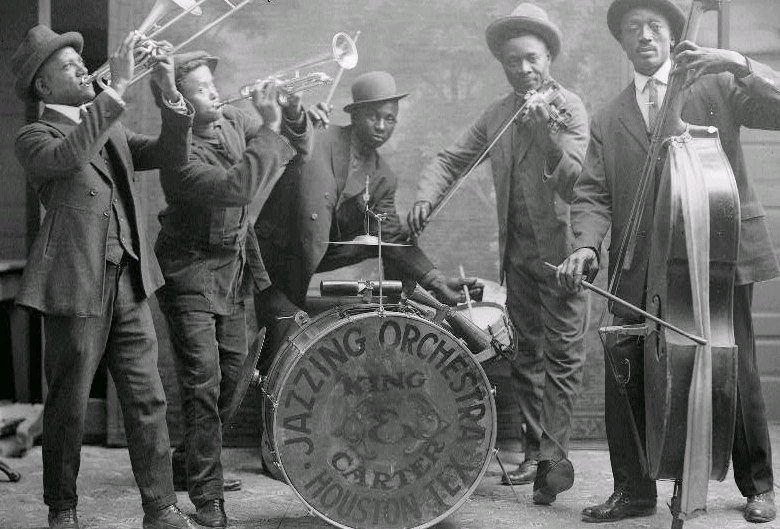 1920—Houston, Texas: A photograph of Houston’s “King & Carter Jazzing Orchestra” shows a valve trombone, trumpet, drums, violin, and bass (see facing image; public domain; source: wikimedia commons).
1920—Houston, Texas: A photograph of Houston’s “King & Carter Jazzing Orchestra” shows a valve trombone, trumpet, drums, violin, and bass (see facing image; public domain; source: wikimedia commons).
1920—Milan, Italy: Vittorio Ricci mentions bass trombone in connection with the term cimbasso in his orchestration text: “In Aida Verdi uses cimbasso (a kind of contrabass trombone) as the bass of the trombones” (Meucci).
1921—Laporte, Indiana: Ernst Couturier receives a patent for a trombone, “whereby, to the greatest extent possible, the bore of the instrument is continuously and gradually increased in diameter in the direction of travel of the sound vibrations; in other words, I aim to reduce to a minimum the length of cylindrical tubing in the instrument…” (Couturier) (see below image; public domain).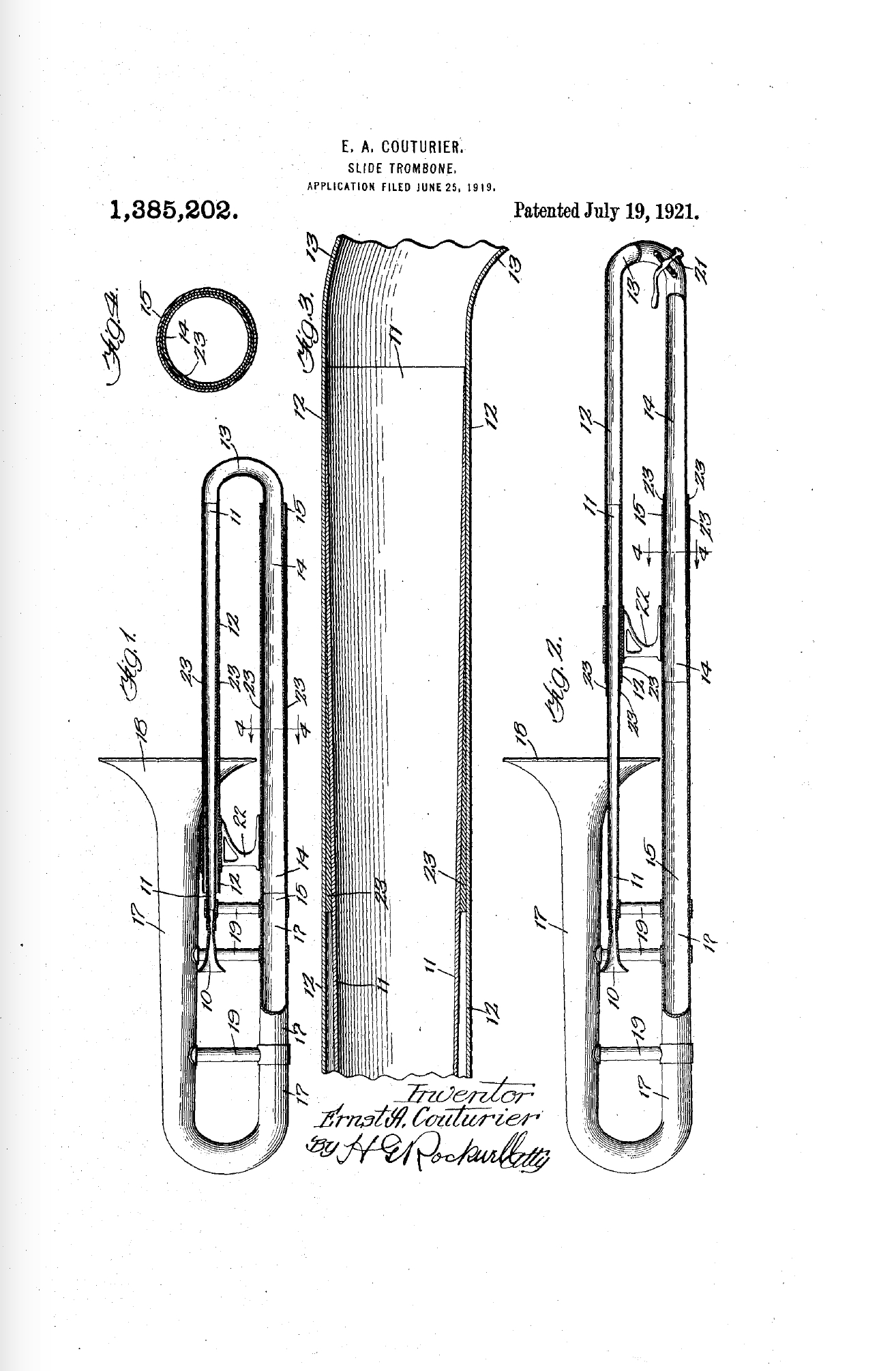
1921—London, England: Gustav Holst, in the London Daily News, says, “But when I was twenty-one a misfortune overtook me. I began to have trouble with my right arm, due to overwork. Eventually I had to abandon the piano and the organ, and had to earn my livelihood as a trombone player in the theatres and opera orchestras, like the Carl Rosa and the Scottish Orchestra.”
1921—Paris Conservatory morceau de concours: Philippe Gaubert, Morceau Symphonique.
1922—Russia: Vladislav Blazhevich, Russian trombonist and pedagogue, is 1st trombonist and a founding member of the “Persymfans.” (The name is an acronym, in Russian, for First Symphony Ensemble of the Moscow City Soviet, a socialist ideal of a conductorless orchestra, flourishing in Moscow from 1922 to 1932.)
1922—Richard Strauss, in his Recollections and Reflections, writes his “Ten Golden Rules for the Album of a Young Conductor.” They include the following: “4. Never look encouragingly at the brass, except with a short glance to give an important cue” and “6. If you think that the brass is not blowing hard enough, tone it down another shade or two” (Kolodin, The Composer as Listener 218).
1922—Igor Stravinsky’s Octet uses trombone prominently and soloistically.
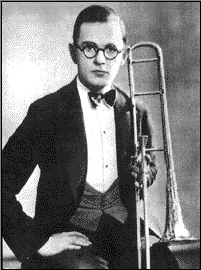 1922—New York trombonist Miff Mole records with the Original Memphis Five, of which he is an early member. He later becomes one of the most active freelancers in New York City, eventually joining the NBC Orchestra and performing under Toscanini. His continued activity in jazz leads to extensive recording with Red Nichols, in addition to performances with such jazz notables as Paul Whiteman, Benny Goodman, and Bix Beiderbecke. Credited with the expansion of technique in early jazz trombone playing, he develops a cleaner, more technical approach than the New Orleans “gut bucket” style (see facing image; public domain) (Dietrich 30).
1922—New York trombonist Miff Mole records with the Original Memphis Five, of which he is an early member. He later becomes one of the most active freelancers in New York City, eventually joining the NBC Orchestra and performing under Toscanini. His continued activity in jazz leads to extensive recording with Red Nichols, in addition to performances with such jazz notables as Paul Whiteman, Benny Goodman, and Bix Beiderbecke. Credited with the expansion of technique in early jazz trombone playing, he develops a cleaner, more technical approach than the New Orleans “gut bucket” style (see facing image; public domain) (Dietrich 30).
1922—Anton Slama, 66 Etudes in all Major and Minor Keys for Trombone, Tuba, Bassoon, String Bass.
1922—Paris Conservatory morceau de concours: Camille Saint-Saëns, Cavatine.
1922—Poulenc, Sonata for Horn, Trumpet, and Trombone.
1922—A photo of the New Orleans Rhythm Kings, an influential band in the 1920s, includes trombonist George Brunies (see below; public domain) (photo source: Wikimedia).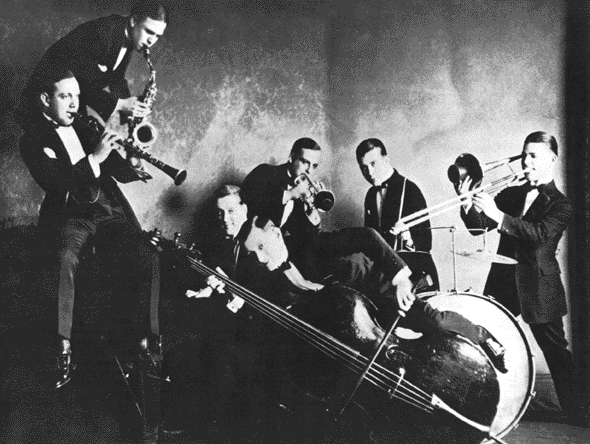
1922—Rochester, New York: Emory Remington (1891-1971) joins Eastman School of Music faculty. Known as “The Chief,” he plays a major role in shaping American trombone playing (Reynolds).
1922—The Creole Kid Ory Band—first black jazz musicians to record and have their recording issued (“Ory’s Creole Trombone,” recorded in Los Angeles).
1922—Alban Berg, Wozzeck.
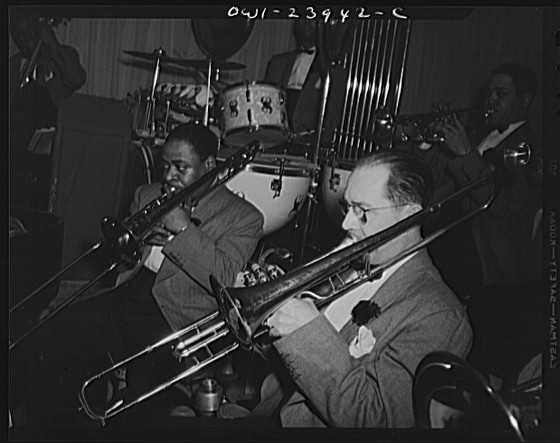 1923—A photo shows valve trombone player Juan Tizol with Duke Ellington’s orchestra (see facing image; public domain; source: wikipedia commons). A Puerto Rican native, Tizol becomes a longstanding member of Ellington’s orchestra, performing with the group from 1929 to 1944. He also evolves into a well-respected composer, writing such Ellington standards as “Perdido” and “Caravan.”
1923—A photo shows valve trombone player Juan Tizol with Duke Ellington’s orchestra (see facing image; public domain; source: wikipedia commons). A Puerto Rican native, Tizol becomes a longstanding member of Ellington’s orchestra, performing with the group from 1929 to 1944. He also evolves into a well-respected composer, writing such Ellington standards as “Perdido” and “Caravan.”
1923—Paris Conservatory morceau de concours: J. Ed. Barat, Piece in E-flat Minor.
1923—Cincinnati, Ohio: German trombonist Josef Serafin Alschausky (1879-1947 or 48), a member of the Cincinnati Symphony, performs the David Concertino with the orchestra under conductor Fritz Reiner.
1923—Theo. Baker, in his music dictionary, comments on valve versus slide trombone: “The valve-trombone possesses greater agility than the slide-trombone, but is apt to be inferior to it in purity of tone” (Baker 211).
1924—Philadelphia, PA: Gardell Simons, principal trombonist of the Philadelphia Orchestra, solos with the orchestra (Wister 226).
1924—Paris Conservatory morceau de concours: Henri Büsser, Cantabile et Scherzando.
1924—Maurice Ravel makes acquaintance with trombonist Leo Vauchant, who is known for his high register, jazz playing, and (later) Hollywood film arrangements. Ravel and Vauchant meet regularly for 4 years, discussing jazz at length. Ravel comments specifically on Vauchant’s unique high register. Vauchant is thought to have influenced Ravel’s subsequent writing for trombone, particularly the solos in Bolero and L’Enfant et les Sortileges.
c. 1925—Richard Strauss, in his “Ten Golden Rules for Young Conductors,” says, “4. Never encourage the brass, except with a curt glance, in order to give an important entrance cue….6. If you think that the brass is not blowing loud enough, mute it by a couple of degrees” (Fisk 208).
1925—Boston: A newspaper story in the Boston Sunday Post on trombonist Joannes Rochut and his family includes a photograph of Rochut and his children, along with the caption, “Joannes Rochut, new first trombone of Boston Symphony Orchestra, and his daughter and son. This charming family snapshot was made before the war, but Mr. Rochut prefers it to more pretentious photos made since” (see below image; Boston Symphony Orchestra Archives).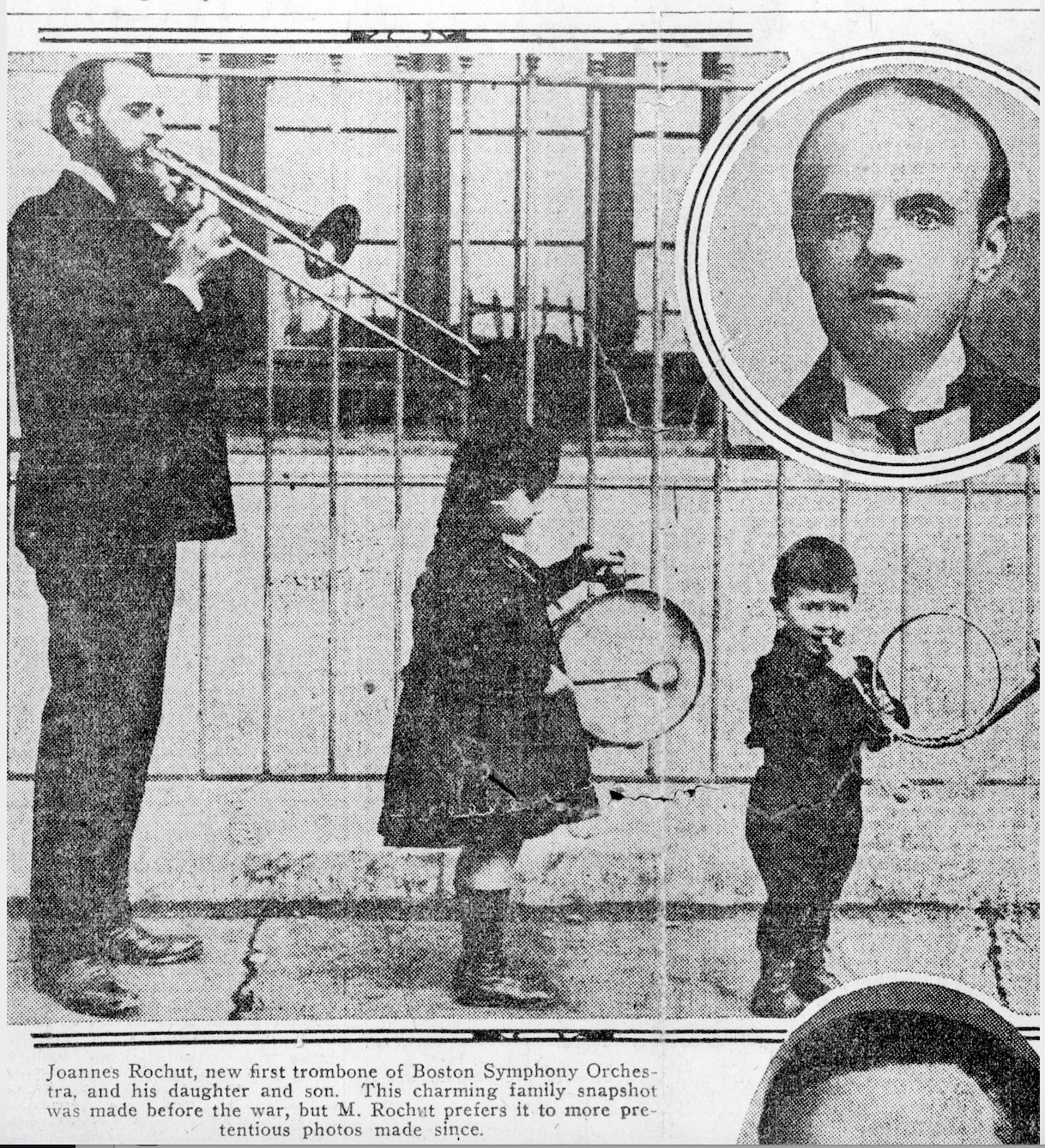
1925—Edgar Kelley, in his text on musical instruments, says the following about trombone: “This noble instrument…was the only brass instrument capable of producing all the tones of the chromatic scale. But the classical composers rarely took advantage of this fact, and not until Schubert’s time were its manifold possibilities exploited….The trombone has a vast dynamic range from the pianissimo in the scene where Siegfried climbs the rocks to find Brünnhilde to the glorious fortissimo outburst (combined with Trumpets) when Tannhäuser tells of the pardoning of sinners by the Pope (Kelley 190).
1925—Paris Conservatory morceau de concours: Alfred Bachelet, Morceau de Concours.
1925—Alban Berg’s Kammerkonzert for violin, piano, and thirteen winds, features a very difficult trombone part.
1925—In The Musical Times, under the title, “The Misuse of the Trombone,” J. A. Westrup writes the following: “We live in an irreverent age. There is no respecting of persons in the world, nor of instruments in the orchestra. The aristocracy which was the strong pillar of our forefathers is now compelled to cut capers worthy only of the clarinet. The noble sackbut that once lifted up its jubilant voice in simple four-part harmony is now condemned to dance, a monarch become puppet, to any inconsequent strains that may be forced upon it. To be plain, modern composers have misused the trombone, and if present tendencies continue, it will become a plaything instead of an instrument, subject rather to the caprice than to the intelligence of the composer. No one will deny that the trombone’s chief assets are tone and dynamic range. Its crescendo can be the most powerful in the orchestra; its tone is equally the most noble and dignified of any brass instrument now in use. It would seem then an elementary point of orchestral technique to assign to this instrument passages in which it is permitted to produce this characteristic tone….But composers have become so fascinated by the acrobatic possibilities of what is in reality a very dignified instrument that they must keep it ever on the move” (Westrup).
1925-48—Henri Couillaud runs the trombone studio at the Paris Conservatory (Dudgeon 195).
1926—“Tricky Sam” (Joe) Nanton joins Duke Ellington band. Specializing in use of plunger mute and “wa-wa” solos, he remains with Ellington until his death in 1948 (Feather 347). In the clip below from 1943, Nanton’s solo starts at :54.
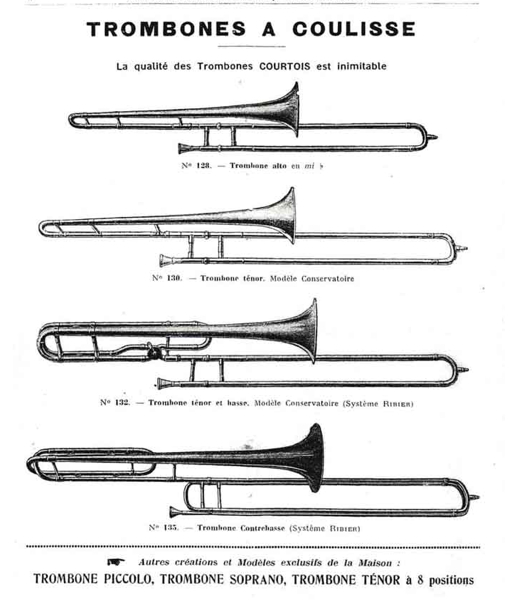 1926—Paris, France: Instrument manufacturer Courtois pictures, in their catalog, 4 different trombones: trombone alto in e-flat, trombone tenor “Modele Conservatoire,” trombone tenor and bass “Modele Conservatoire,” and trombone contrabass (see facing image, click for larger version; public domain).
1926—Paris, France: Instrument manufacturer Courtois pictures, in their catalog, 4 different trombones: trombone alto in e-flat, trombone tenor “Modele Conservatoire,” trombone tenor and bass “Modele Conservatoire,” and trombone contrabass (see facing image, click for larger version; public domain).
1926—Darius Milhaud complains about the various ways jazz is being taught (“analyzed—I might even say dissected”) and popularized, adding the following about trombone methods: “You could also find instructions on playing the trombone, including the principal types of glissando and the way to make the sound quiver by a rapid little to-and-fro movement of the slide” (Fisk 311).
1926—Darius Milhaud complains about the various ways jazz is being taught (“analyzed—I might even say dissected”) and popularized, adding the following about trombone methods: “You could also find instructions on playing the trombone, including the principal types of glissando and the way to make the sound quiver by a rapid little to-and-fro movement of the slide” (Fisk 311).
1926—Janacek’s Capriccio is scored for flute/piccolo, 2 trumpets, 3 trombones, tenor tuba, and piano.
1926—Paris Conservatory morceau de concours: Samuel Alexandre Rousseau, Piece Concertante.
1927—Maurice Ravel, Bolero.
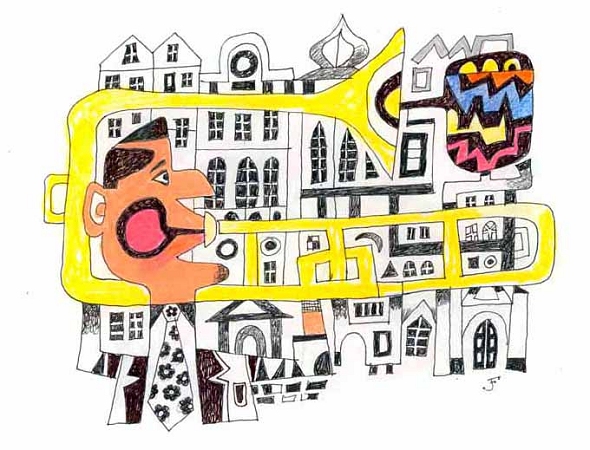 1927—Bessie Smith, often called “Empress of the Blues,” celebrates her favorite trombonist, Charlie Green, in in her tune, “Trombone Cholly.” The song’s lyrics are, “I know a fool that blows a horn, He came from way down south, I ain’t heard such blowin’ since I was born When that trombone’s in his mouth! He wails and moans, He grunts and groans, he moans just like a cow! Nobody else can do his stuff, For he won’t teach them how! Oh Cholly, blow that thing, That slide trombone; Make it talk, make it sing, Lawdy, where did you get that tone? If Gabriel knows how you could blow, He’ll let you lead his band, I know! Oh Cholly, blow that thing, Play that slide trombone. Oh Cholly, make it sing, That slide trombone, You’ll even make a king Get down off his throne; And he would breaka leg, I know, A-doin’ the charleston while you blow! Oh Cholly Green, play that thing, I mean that slide trombone!” Jim Flora, who later designs many album covers for Columbia Records in the 1950s, features Green in his whimsical drawing, “Trombone Cholly” (see above image; used by permission of www.JimFlora.com; © The Heirs of James Flora).
1927—Bessie Smith, often called “Empress of the Blues,” celebrates her favorite trombonist, Charlie Green, in in her tune, “Trombone Cholly.” The song’s lyrics are, “I know a fool that blows a horn, He came from way down south, I ain’t heard such blowin’ since I was born When that trombone’s in his mouth! He wails and moans, He grunts and groans, he moans just like a cow! Nobody else can do his stuff, For he won’t teach them how! Oh Cholly, blow that thing, That slide trombone; Make it talk, make it sing, Lawdy, where did you get that tone? If Gabriel knows how you could blow, He’ll let you lead his band, I know! Oh Cholly, blow that thing, Play that slide trombone. Oh Cholly, make it sing, That slide trombone, You’ll even make a king Get down off his throne; And he would breaka leg, I know, A-doin’ the charleston while you blow! Oh Cholly Green, play that thing, I mean that slide trombone!” Jim Flora, who later designs many album covers for Columbia Records in the 1950s, features Green in his whimsical drawing, “Trombone Cholly” (see above image; used by permission of www.JimFlora.com; © The Heirs of James Flora).
1927—African-American poet James Weldon Johnson, in his collection, God’s Trombones: Seven Negro Sermons in Verse, compares black preachers of his youth to trombones because the trombone is “the instrument possessing above all others the power to express the wide and varied range of emotions encompassed by the human voice—and with greater amplitude.”
1927—Paris Conservatory morceau de concours: Henri Büsser, Etude de Concert.
1927—The trombone entry in Who’s Who in the Orchestra (Fundamentals of Musical Art, vol. XI) says, “Slide trombones are known, along with fiddles, as the only perfect instruments of the orchestra, because they alone may always be played mathematically in tune at any pitch. The trombone is a truly noble horn. It is also one of the most versatile. While usually sounding like a majestic tenor or bass trumpet, it has courtly, mystic, and religious sides to its nature, unknown to the smaller instrument. A trombone quartet (three trombones and a tuba), like the one at Bethlehem, Pennsylvania, when well played in a high place such as a church steeple, is a memorable delight. Mendelssohn declared that this instrument is ‘too sacred to use often.’ But it has many other effects up its sleeve as well. It can sound tearful, menacing or terrible, mocking, severely mournful, or pompously heroic. Mozart obtained some weird, unearthly effects from the trombone in ‘Don Giovanni,’ when the statue of the murdered Don Pedro speaks in response to Don Giovanni’s mocking invitation to supper. Schubert obtains some soft, beautiful effects from the trombones in his great ‘C-Major Symphony,’ especially in the coda of the first movement. Berlioz, as usual, in his ‘Messe des Morts’ went to the extreme and called for sixteen trombones to help in imitating Gabriel’s trump.”
1927—H.W. Tyrell, 40 Progressive Studies for Trombone.
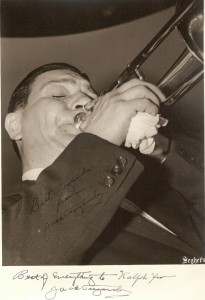 1928—Jazz trombonist Jack Teagarden (1905-64) becomes the first white musician to record with a black band (Louis Armstrong, “Knockin’ a Jug”). On Teagarden’s influence at this time, Leonard Feather later says, “The advent of Jack Teagarden on the jazz scene in the late 1920s brought a new style to the annals of both jazz singing and trombone: a style that defies classification and has moved musicians of every school to the expression of unqualified enthusiasm” (Feather 438) (see facing image; public domain; source: wikimedia commons).
1928—Jazz trombonist Jack Teagarden (1905-64) becomes the first white musician to record with a black band (Louis Armstrong, “Knockin’ a Jug”). On Teagarden’s influence at this time, Leonard Feather later says, “The advent of Jack Teagarden on the jazz scene in the late 1920s brought a new style to the annals of both jazz singing and trombone: a style that defies classification and has moved musicians of every school to the expression of unqualified enthusiasm” (Feather 438) (see facing image; public domain; source: wikimedia commons).
1928—Boston, Massachussetts: Johannes Rochut, principal trombonist of Boston Symphony, publishes Bordogni vocalises for trombone: Melodious Etudes for Trombone, books 1-3.
1928—Paris Conservatory morceau de concours: Alexandre Guilmant, Morceau Symphonique.
1928—Arthur Heacox of Oberlin Conservatory of Music writes in his orchestration text, “The trombone has remarkable dynamic versatility, ranging from a thrilling ff to a pp that can be made mysterious, plaintive, or even sinister. Though a good melodic instrument, it is not very flexible in tone production. The trill, and rapid scale passages should be avoided….It is in the symphony orchestra that the trombones come into their full glory, where it is customary to use three, with or without a tuba. Here a melody is seldom given to a trombone alone, but rather to all three of them in unison. In broad sustained chords—where trombones are at their best—the composer has an astonishing resource—a high light in his picture, and one requiring artistic handling” (Heacox 138).
1929—Dresden, Germany: The Dresden State Opera contains 6 trombones (Herbert, Trombone 336).
1929—Kurt Weill composes the jazz-inspired duo, Kleine Dreigroschenmusik, for trumpet and trombone.
1929—Dmitri Shostakovich parodies a political speech through an extended recitative for 3 trombones in his Symphony No. 3.
1929—Paris Conservatory morceau de concours: J. Ed. Barat, Piece in E-flat Minor.
1929-30—A photo of the trombone class at Paris Conservatory, 1929-30, features Henri Couillaud, trombone professor (see below image; public domain).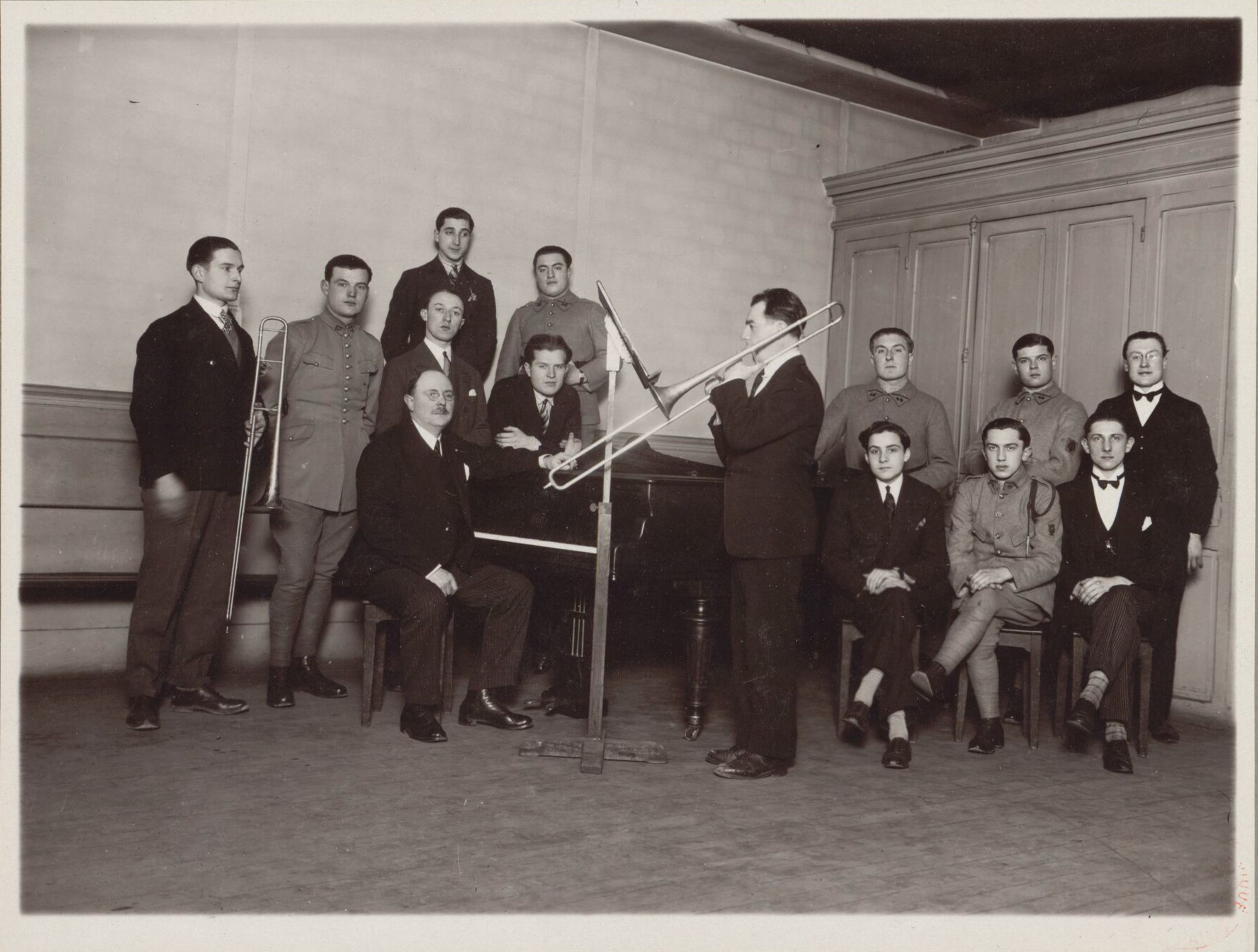
c. 1930—London, England: John Cooper, an artist of the East London Group, paints Hark to Trombone and Trumpet (see below image; public domain).
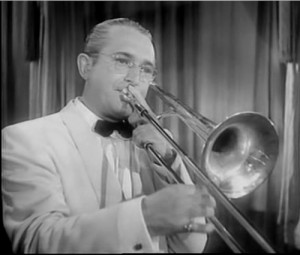 1930s and 40s—Bandleader-trombonists Tommy Dorsey (see facing image) and Glenn Miller popularize trombone as a solo instrument before huge audiences. Dorsey is especially known for his remarkable control and smooth legato. Leonard Feather later says, in reference to Dorsey, “By ’30 he was one of the most successful free-lance radio and recording artists on trombone, recognized both for his exceptional tone and legato style on ballads and for his fine solos on faster tempi” (Feather 185) (Dorsey photo public domain: wikimedia commons).
1930s and 40s—Bandleader-trombonists Tommy Dorsey (see facing image) and Glenn Miller popularize trombone as a solo instrument before huge audiences. Dorsey is especially known for his remarkable control and smooth legato. Leonard Feather later says, in reference to Dorsey, “By ’30 he was one of the most successful free-lance radio and recording artists on trombone, recognized both for his exceptional tone and legato style on ballads and for his fine solos on faster tempi” (Feather 185) (Dorsey photo public domain: wikimedia commons).
1930s—Jazz trombonist Dicky Wells an important part of Count Basie’s band.
1930s—Postcard of Jack Teagarden (see below image; public domain).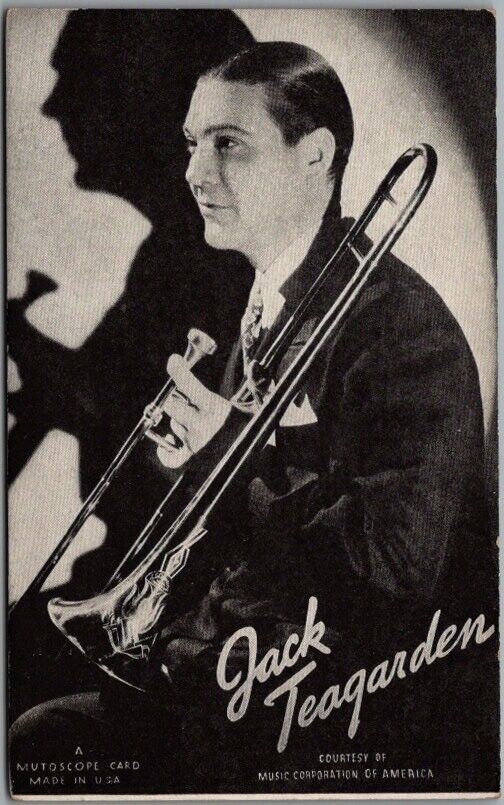
1930—Paris Conservatory morceau de concours: Charles Tournemire, Légende.
1931—Paris Conservatory morceau de concours: Eugene Bigot, Impromptu.
1932—Paul Hindemith, Morgenmusik.
1932—Paris Conservatory morceau de concours: Yvonne Desportes, Fantaisie.
1933—Paris Conservatory morceau de concours: Henri Büsser, Phoebus Variations, op. 87.
1933—Sigmund Spaeth, in The Art of Enjoying Music, says, “The trombones have a definite blaring sound, easily distinguished by ear, in addition to the dramatic action of their sliding technique. Comedy effects, such as the hyena laugh, etc., have been introduced into modern popular music for the trombone” (Spaeth 91).
1934—Paris Conservatory morceau de concours: Jules Mazellier, Solo de Concours.
1935—In Deutsche-Militär-Musiker-Zeitung, Karl Storck is quoted as saying, “In concerts in Sonderhausen and Berlin, I was able to hear for myself Professor Weschke’s exceptional tonal range. He plays up to double high b-flat and c on his tenor trombone beautifully and with unparalleled ease. To my amazement, he plays chromatically down to contra E-flat, d, and c (with no F-attachment) in both slow and fast tempo. These facts amaze me that much more when I consider that Professor Weschke is 69 years old. He is a truly exceptional appearance in the line of old masters Belcke, Queisser, Nabich and Bruns (Sr.). The Trombone Era, which hails back to Belcke in 1815, has reached its culmination in Paul Weschke” (Lenthe).
1935—In Deutsche-Militär-Musiker-Zeitung, trombonist Paul Weschke is quoted as saying, “Since an absolutely clean technique is more difficult to achieve on the trombone than on the other orchestra instruments, the trombonist should concentrate primarily on tonal beauty. To achieve this, the trombonist must constantly practice scales and tone studies, and then mainly operatic arias and songs, of course with the text written in” (Lenthe).
1935—Paris Conservatory morceau de concours: J. Ed Barat, Andante et Allegro.
1936—Joseph Jean Baptist Arban, Arban’s Famous Method for Slide and Valve Trombone and Baritone, adapted for trombone by Charles L. Randall and Simone Mantia. 1936—Paris Conservatory morceau de concours: Henri Büsser, Cantabile et Scherzando.
1937—Donald Francis Tovey, speaking of Haydn’s use of bass trombone in The Creation, says, “By the way, Haydn does not seem to know the modern or late-Victorian rule that ‘you must never use the bass trombone without the others.’ His rule appears to be that you may do so by all means, but need neither presuppose that he will play like a pig nor compel him to play thus by writing so low as to give him constant rapid changes of his slide from the first position to the seventh” (Tovey 142).
1937—Russian trombonist and pedagogue Vladislav Blazhevich organizes and becomes conductor of the State Brass Band of the USSR (in Moscow).
1937—Alban Berg’s Lulu, unfinished at the composer’s death in 1935, is first produced.
1937—Paris Conservatory morceau de concours: Philippe Gaubert, Morceau Symphonique.
1937-38—In an optional passage of his second Violin Concerto, Bartok makes extensive use of cross-harmonic lip glissandos in all the brass, including trombone (Wills, Frontiers 258).
1938—New Bedford, Massachussetts: First documented use of trombones in United House of Prayer for All People. Church founded outside New Bedford, MA (1919), then spreads to cities up and down the Southern Railway. Trombones become an integral part of this religious tradition, forming “shout bands,” typically consisting of a lead trombone, 3 to 5 “row” trombones, baritone horn, sousaphone, and trap set. They play primarily by ear, with trombone-dominated music based on the unique “shout” tradition, as well as elements of jazz, gospel, blues, and Dixieland. In the 21st century, shout bands continue to be active in churches in Georgia, North Carolina, South Carolina, Virginia, Washington, DC, and New York City (Hafar).
1938—Trombonist Tommy Dorsey records Boogie Woogie, reputed to have sold 4 million copies (Feather 1938).
1938—Paris Conservatory morceau de concours: Jean Clergue, Impromptu.
1938—H.W. Schwartz, in his book on the instruments of the orchestra, says, “It is this glissando or ‘smear’ effect which makes the trombone the Dr. Jekyll and Mr. Hyde of the musical world. Contrary to popular opinion, the distinction of being the jazziest instrument in the orchestra or band goes, not to the saxophone, but to the trombone. Known and admitted to be the most noble of all musical instruments, it is at the same time the jazziest of the whole lot. It depends on the player. When played as a ‘slip horn,’ nothing can equal it as a means of expressing jazz…Its slide gives it unmatched resources for slurring, portamento and glissando, in which are all the suggestiveness, smirk and sensuousness for which jazz is noted. Modern muting and ‘wow-wowing’ were early used on the ‘slip horn.’ It can moan, it can scream, it can seduce, it can laugh like a hyena. It is the most gifted of all instruments called upon to give expression to the worst type of jazz mania. But when Mr. Hyde steps forward, all is noble, sacred, grand. Whenever composers wish to depict religious solemnity, or martial glory, they call upon the noble trombone. Wagner used it often in his allegorical and religious ‘Nebelungen.’ When Berlioz wished to portray Gabriel’s awful trumpet announcing the Day of Judgment in ‘Requiem,’ he called for sixteen trombones! The trombone is like a great and gifted person whose talents may be turned to good or to bad, but in either case great achievement is assured through unusual capabilities” (Schwartz 223-24).
1939—Aaron Copland writes, “The tone of the trombone is allied in quality to that of the French horn. It also possesses a noble and majestic sound, one that is even larger and rounder than the horn’s tone. But it also partly belongs with the trumpet, because of its brilliance of timbre in fortissimo. Moments of grandeur and solemnity are often due to a judicious use of the trombone section of the orchestra” (Copland 75-76).
1939—Paris Conservatory morceau de concours: René Duclos, Doubles sur un Choral.
1939—Philadelphia, Pennsylvania: Gordon Pulis joins the Philadelphia Orchestra, where he remains until 1942, then rejoins the orchestra from 1945 to 1946 (Kupfurberg 225).
1939—Pitch standard of a’=440 is adopted as international pitch standard.
1939—Historian Adam Carse writes the following about contemporary trends in trombone performance: “More than the instrument, it is the style of playing that has changed most. There is every reason to believe that the overwhelming forte or fortissimo of the trombones in a modern orchestra was a thing quite unknown before last century, and that if such sounds had been produced, they would have been condemned as intolerably coarse and inartistic” (Carse, Musical 261). 1940—Paris Conservatory morceau de concours: J. Ed Barat, Andante et Allegro.
1940—Benjamin Britten writes his Sinfonia da Requiem, dedicated to the memory of his parents, which calls for 3 trombones. 1941—Paul Hindemith, Sonata for Trombone and Piano.
1941—Dmitri Shostakovich, Symphony No. 7, op. 60, calls for 6 trombones.
1941—Nicholas Bessaraboff, writing about European musical instruments for the Museum of Fine Arts in Boston, says, “The trombone, if played in good taste, is a serious, powerful, and solemn instrument. It can express some of the deepest emotions, dramatize a situation, or discourse epically like a bard. The fact that it is put nowadays to certain ignoble uses does not affect in the least its true stature. The trombone is fine as a solo instrument, but it is more temperamentally fitted for group work with members of its own family or with instruments in tonal affinity with its spirit. Although asked sometimes to display the agility of a youth, the trombone prefers a more dignified mode of expression. The trombone is like a man who has reached an age of discretions and concentrated power. Its utterances have weight, and it cannot engage in five-o’clock-tea talk. The trombone is primarily a masculine instrument and should not be made to sound like a frivolous dandy. The trombone of this discourse is, indeed, the slide trombone, the simplest yet almost ideal ‘brass’ instrument” (Bessaraboff 184).
1941—Nicholas Bessaraboff, writing about European musical instruments for the Museum of Fine Arts in Boston, remarks on alto trombone: “The alto trombone has a small but distinctive voice of its own, and if the instrument were to be experimented with as much as the modern tenor trombone, no doubt fine alto trombones could be built. Its disappearance from the orchestra was mainly due to the fact that when valves were applied to the trumpet, there were two trumpets, in F and in E-flat, which could substitute for it. In some orchestras the alto trombone parts were played on these trumpets. After both the alto trombone and the low-pitched valve trumpets disappeared from the orchestra, the first tenor trombone player was required to play the alto trombone parts. The composers wrote higher and higher for brass instruments, a tendency deplored by Widor. This had one unpleasant consequence: trombonists began to ask for instruments which would produce the tones of the upper register with greater ease. This meant a smaller bore and smaller bell, a development which eventually resulted in the ‘pea shooter,’ a miserably sounding effeminate caricature” (Bessaraboff 189).
1941—Nicholas Bessaraboff, writing about European musical instruments for the Museum of Fine Arts in Boston, comments on bass trombone: “The modern instrument used in the orchestra is a practical compromise forced on players by the wide range of the bass trombone parts. Essentially it is the large bore tenorbass trombone with the Quartventil conveniently located for operation by the left-hand thumb. Although this type of instrument is easier to manipulate than the bass trombone with the swivel handle, the latter type is better in tone, since its proportions can be better chosen than those of the compromise type with the valve. In any case the bass trombone is very fatiguing for the player” (Bessaraboff 191).
1941—Nicholas Bessaraboff, writing about European musical instruments for the Museum of Fine Arts in Boston, comments on tenor trombone with valve: “Addition of the valve is not necessary on the tenor trombone. The standard instrument is convenient even for players with small reach. The slide trombone is the simplest functional form adequately meeting the severe requirements of modern orchestration. This is the reason why any complication, unless absolutely necessary as in the case of the bass trombone, proves impracticable” (Bessaraboff 191).
1942—Photograph, held in Köln, Germany, of “virtuoso” Paul Kaiser-Reka, playing a “buccin” valve trombone with a dragon-head bell (Kölnisches Stadtmuseum 302).
1943—Conductor Leopold Stokowski, in Music for All of Us, says, “One of the next steps forward in the modern orchestra is to make good valve trombones. They should have seven valves instead of three, because then each valve can be separately tuned.”
1943—Paris Conservatory morceau de concours: Eugene Bigot, Impromptu.
1943—In The Music Lover’s Handbook, Lawrence Abbott says, “The one brass instrument which has no valves is the trombone, the ‘cello of the brass choir. It is a direct descendant of an ancient instrument which the Moors called a sackbut (Moorish for ‘pump’) and which was played in the same picturesque way as a trombone, by moving a sliding section of U-shaped tubing back and forth. The trombone is about an octave lower in pitch than the trumpet. Its tone is impressively powerful; it has the trumpet’s bold, ringing quality, but being deeper has also a sonorous nobility which no other instrument can quite equal” (Abbot 87).
1943—Paul Hindemith, Symphonic Metamorphosis.
1943—New York, New York: A number of photos of Duke Ellington and his orchestra are taken at the Hurricane Club ballroom, including the facing image of a trio of players from the group. The images are now found in the American Memory Collection of the Library of Congress (see below image; public domain; source: wikimedia commons).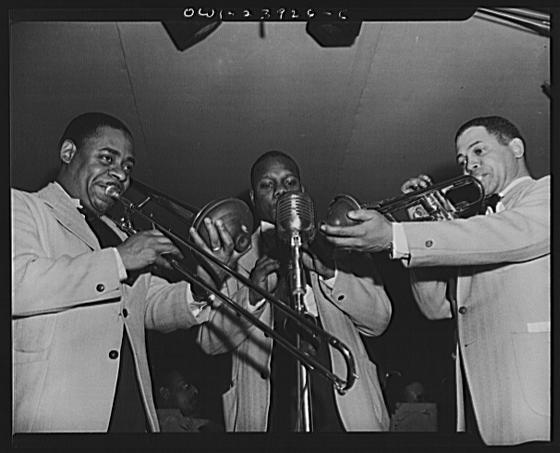
1944—St. Louis, Missouri: Dorothy Ziegler, one of the first female trombonists to be hired by a major symphony orchestra, becomes principal trombonist in the St. Louis Symphony, a post she holds until 1958.
1944—Kansas City, Missouri: Betty Glover, one of the first female trombonists to be hired by a major symphony orchestra, becomes principal trombonist of the Kansas City Orchestra. In 1952 she joins the Cincinnati Symphony, where she performs as bass trombonist for 33 years, as well as teaching at Cincinnati Conservatory of Music.
1944—Paris Conservatory morceau de concours: Eugene Bozza, Ballade.
1944—Bela Bartok, Concerto for Orchestra.
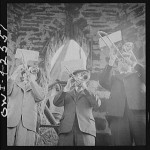
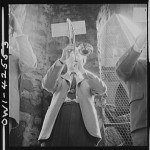
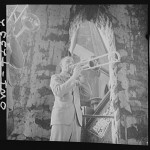 1944—Bethlehem, PA: Three photos showing soprano, alto, and tenor trombones document a Moravian trombone choir performance. The photographs, taken by Howard R. Hollem, bear the title “The Moravian trombone choir which plays chorales before the opening of each performance of the Bach choir.” They are part of the American Memory collection of the Library of Congress (see above 3 images; public domain).
1944—Bethlehem, PA: Three photos showing soprano, alto, and tenor trombones document a Moravian trombone choir performance. The photographs, taken by Howard R. Hollem, bear the title “The Moravian trombone choir which plays chorales before the opening of each performance of the Bach choir.” They are part of the American Memory collection of the Library of Congress (see above 3 images; public domain).
1945—Paris Conservatory morceau de concours: Rene Duclos, Doubles sur un Choral.
1945—Newbridge, England: Frank Howes writes an orchestration text that says the following about orchestral trombone solos: “…solos are rarely satisfactory, as may be ascertained in any performance of Mozart’s Requiem, where a tenor trombone obbligato in the ‘Tuba Mirum’ sounds like a bad cornet player outside a public house round the corner” (Howes 56).
late 1940s—J. J. Johnson (1924- ) is one of very few trombonists invited into exclusive jazz bebop circles. He plays with nearly all the major bebop pioneers (Charlie Parker, Dizzy Gillespie, Kenny Clarke, Miles Davis, etc.).
1946-1975—New York, New York: Allen Ostrander serves as bass trombonist with New York Philharmonic.
1946—Philadelphia, Pennsylvania: Robert Lambert joins the Philadelphia Orchestra, where he remains until 1955 (Kupfurberg 223).
1946—Kai Winding (1922-83), a Danish musician and one of the first bebop trombonists, joins the Kenton band (Feather 57).
1946—Paris Conservatory morceau de concours: Paul Bonneau, Capriccio.
1946—In Listening to the Orchestra, Kitty Barne writes, “The trombone is associated in our minds with the oom-pah of the bass of marching songs like ‘Onward, Christian Soldiers,’ or the blaring out of tunes in a way that drowns everything else, and we are apt to think of it as a vulgarian” (Barne).
1947—According to legendary anthropologist Claude Levi-Strauss, “Returning by ship from the United States in 1947, I sometimes conversed on the promenade deck with a French orchestra conductor who had just given a series of concerts in New York. One day he told me that in the course of his career he had observed that the personality of a musician is often in harmony with the one evoked by the timbre and technique of his instrument; to get along well with his orchestra, a conductor has to take that into account. Thus, he added, in whatever country he might be, he could expect the oboist to be prim and touchy, the trombonist to be expansive, jovial, and good-natured.” Levi-Strauss refers to this phenomenon as the “homology between the two systems of professional occupations and of temperaments” (The Jealous Potter 3). 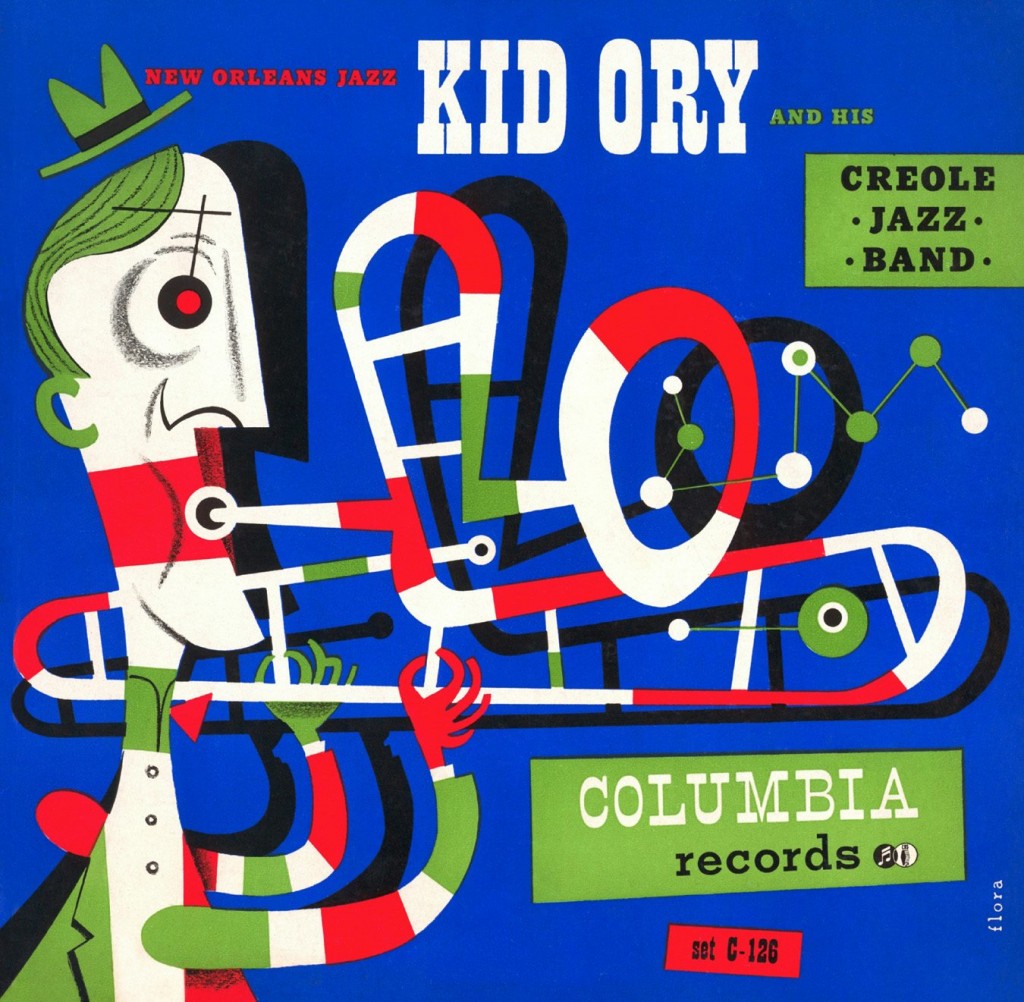
1947—Kid Ory records the album, “Kid Ory and His Creole Jazz Band.” The artwork for the album cover is done by artist Jim Flora, designer of many jazz album covers for Columbia Records (see facing image; used by permission of www.JimFlora.com; © The Heirs of James Flora).
1947—Davis Schuman presents the first known full-length trombone recital (Guion, Short History).
1947—Igor Stravinsky uses trombones to suggest the underworld in his Orphée (Spitzer 31).
1947—New York, New York: Beethoven’s Drei Equali is performed on a New York Philharmonic concert by Lewis Van Haney, Allen Ostrander, Gordon Pulis, and an unnamed player (Shanet 532).
1947—Paris Conservatory morceau de concours: Raymond Loucheur, Hialmar. 1947—Max Schlossberg, Daily Drills and Technical Studies for Trombone. ed. C.K. Schlossberg.
1948-1966—New York, New York: Davis Schuman teaches trombone at Juilliard School. After studying with Jacob Raichman (Boston Symphony), Fred Robbins, and Ernest Clarke, not only does he teach at Juilliard, but he commissions several important solos and is a founding member of Leopold Stokowski’s American Symphony Orchestra.
1948—Paris Conservatory morceau de concours: René Duclos, Sa Majesté le Trombone.
1948—Maurice Gardner, in The Orchestrator’s Handbook, says, “The trombone is an instrument of many uses. In the symphony and band, its bold, powerful and at times majestic tone is of great value. In radio and the dance band (in the hands of competent performers), the trombone’s lyrical ‘cello-like quality comes to the fore. Today, its ability to play glissando between tones has become a commonplace resource” (Gardner 43).
1948—Kauko Kahila, Advanced Studies (in Tenor and Alto Clefs) for Trombone.
1948-60—André Lafosse runs the trombone studio at the Paris Conservatory (Dudgeon 195).
1949—Andre Lafosse, School of Sight Reading and Style for Tenor Trombone.
1949—Paris Conservatory morceau de concours: Eugene Bigot, Variations.
1949—Dmitri Shostakovich’s oratorio, Song of the Forests, op. 81, calls for 9 trombones (6 of which appear in a brass choir in the last movement).
1949—Jazz trombonist Melba Liston, whom Leonard Feather calls “A fine musician, the only outstanding feminine trombonist in jazz,” tours with Billie Holiday. She later teams with numerous leading jazz figures, including Dizzy Gillespie and Quincy Jones (Feather 314).
1949—Ingolf Dahl, Music for Brass Instruments.
1950s—Bob Brookmeyer (1929-2011) becomes one of the leading advocates of the valve trombone. Generally associated with West Coast jazz, he replaces Chet Baker in the Gerry Mulligan Quartet (Dean 234).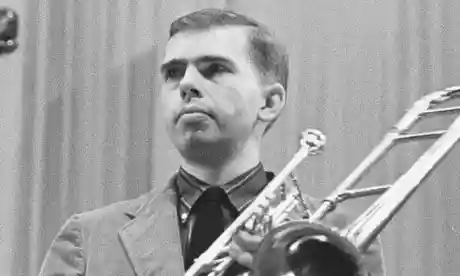
1950—Brooklyn, New York: Trombonist Davis Shuman files a patent for a trombone in which he “inclin[es] the telescopic sections and the slide of the trombone at an angle to the axis of the bell and mouthpiece so that the slide can be moved at an angle to avoid striking a person in front of the trombonist without the necessity of directing the bell away from the audience. Inclining the slide also improves the balance of the instrument since, in normal playing position, the horizontal extension of the slide is not as great as in the conventional trombone and the arm movement is easier and more natural” (Shuman) (see below image; public domain).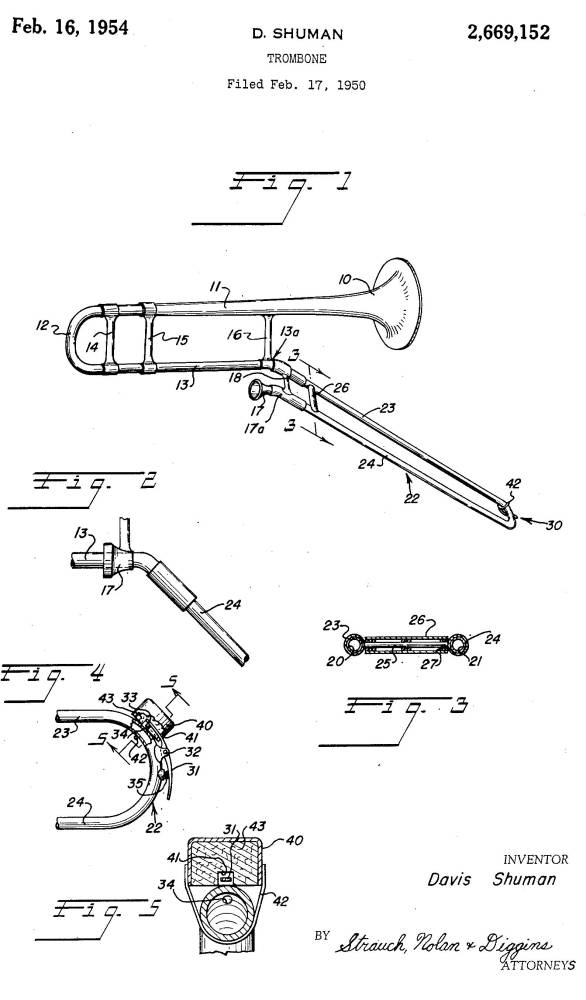
1950—Milan, Italy: Casella and Mortari’s Italian orchestration text, La tecnica dell’ orchestra contemporanea, says trombone often has “grandiose, majestic, solemn, dramatic, violent and even ferocious moments (see Verdi’s Otello).” The authors also observe that the instrument is given a serious role in Mozart’s Don Giovanni and Wagner’s Ring des Nibelungen, although the authors seem taken aback that in only a short time, jazz musicians have forced the trombone to take on “an unthinkably lively and joyful virtuosity” (Dalmonte, Towards a Semiology).
1950—Leonard Bernstein, Elegy for Mippy II.
1950—Vincent Persichett, Serenade No. 6, op. 44.
1950—Paris Conservatory solo: Henri Dutilleux, Choral, Cadence et Fugato.
c. 1950—American-type orchestral trombones become standardized throughout the world, in some cases (as in England) displacing traditional small-bore instruments. In Germany and Austria, trombones continue their independent line of development.
1951—Rochester, New York: Bernard Rogers, professor at the Eastman School of Music, says the following about trombone in his orchestration text: “The trombone’s role is that of power, dignity, weight, and brilliance. Its tone is at once massive and pure, and despite its primitive slide principle, the instrument commands a subtle legato…. While it is possible to produce the tones above high B-flat as far as E-flat (as in Schumann’s Third Symphony), these notes are difficult technically and dynamically. [Footnote:] Jazz players display no fear of extremely high notes, but they often employ a special mouthpiece for trumpet and trombone…. In the top octave the trombone’s tone is clear and dazzling. High chords, in close position, have a fiery glow. This is the region in which the trombone excels in bold proclamation and vivid color. Open position also carries through with magnificent effect in simple chord forms. Dissonances, played forte, have savage power. United trombones lend immense impact to passages of stern nature. Deliberate movement suits them well; yet the instruments can move with astonishing speed in the upper half of their range. (During the time it took to reach the radio dial, we have heard a good part of the Flight of the Bumble Bee warbled by solo trombone!)… The instrument has a remarkable dynamic scale, and adds immeasurably to growing sonorities. Even greater than the horns and trumpets is its power of forte piano (fp) or of making suddenly swelling or decreasing dynamics” (Rogers 62).
1951—New York, New York: Gordon Pulis is soloist with New York Philharmonic Dec. 28, 29, and 30 (specific solo not indicated in records) (Shanet 566).
1951—George Frederick McKay, Sonata.
1951—Paris Conservatory morceau de concours: Michel Spisak, Concertino.
1951—Dmitri Shostakovich, music for the film “The Unforgettable Year 1919,” op. 89 (Sometimes titled The Memorable Year 1919) calls for 6 trombones.
1951—Paul Creston, Fantasy for Trombone and Orchestra.
1951—Max Winkler, speaking of his arrangements of existing art music for silent films (several decades earlier), says, “Any piece using a trombone prominently would infallibly be dedicated to the home-coming of a drunk: no other instrument could hiccup with such virtuosity” (Winkler 238).
1951—Philip Jones founds the Philip Jones Brass Ensemble (Mathez, Philip Jones).
1952—Davis Schuman plays American premiere of Rimsky-Korsakov Conccerto with Goldman Band in New York’s Central Park.
1952—Paris Conservatory morceau de concours: Claude Pascal, Pastorale Héroique.
1952—Kent Kennan, in The Technique of Orchestration, says, “In its familiar role, the trombone is an instrument that excels at loud, heroic passages. But it can also play softly, either on the chief musical idea or as background; this side of its nature is too often forgotten. Rapid running passages and light, fanciful parts that skip around a great deal are obviously not well suited either to trombone technique or to trombone quality. However, the instrument can play rapid repeated notes or short figures that move quickly….Nowadays even the first and second (tenor) trombones in many orchestras are equipped with the F attachment, chiefly because it simplifies the technical problem by eliminating certain awkward changes of position” (Kennan 139).
1952—Himie Voxman, Selected Studies for Trombone.
1953—Paris Conservatory morceau de concours: Serge Baudo, Petite Suite.
1953—Eugene Bozza, Allegro et finale (bass trombone).
1953—Eugene Bozza, Prélude et allegro (bass trombone).
1953—William Newman, in Understanding Music, says, “The tenor and bass trombones, oldest of the brasses in their present state, produce a commanding, stentorian tone that can dominate the orchestra in their ranges. Efforts to replace the slide system with valves have never succeeded for long. The agility that can be achieved with the slide is astonishing” (Newman 39).
1954—Jean-Michel Defaye, Deux Danses.
1954—Paris Conservatory morceau de concours: José Berghmans, Concertino.
1954—Kazimierz Serocki, Sonatina.
1954—J. J. Johnson and Kai Winding team up to tour and record as a quintet. The duo continues to play together off and on for decades.
1955—Walter Piston, inhis orchestration textbook, says, “The trombones are by tradition group instruments rather than soloists and they are used very frequently in three-part harmony, performing a harmonic background function similar to that performed by horns….The most suitable melodies for the trombones are those having a kind of deliberate dignity and solemnity, or those of a choral type that would be sung by more than one voice” (Piston).
1955—Trombonist Henry Charles Smith joins the Philadelphia Orchestra, where he remains until 1967 (Kupfurberg 226).
1955—Paris Conservatory morceau de concours: Pierre Lepetit, Piece de Concert.
1955—Lars-Erik Larsson, Concertino.
1955—Darius Milhaud, Concertino d’Hiver.
1955—Marlon Brando practices trombone between scenes on the film set of Guys and Dolls (see below image).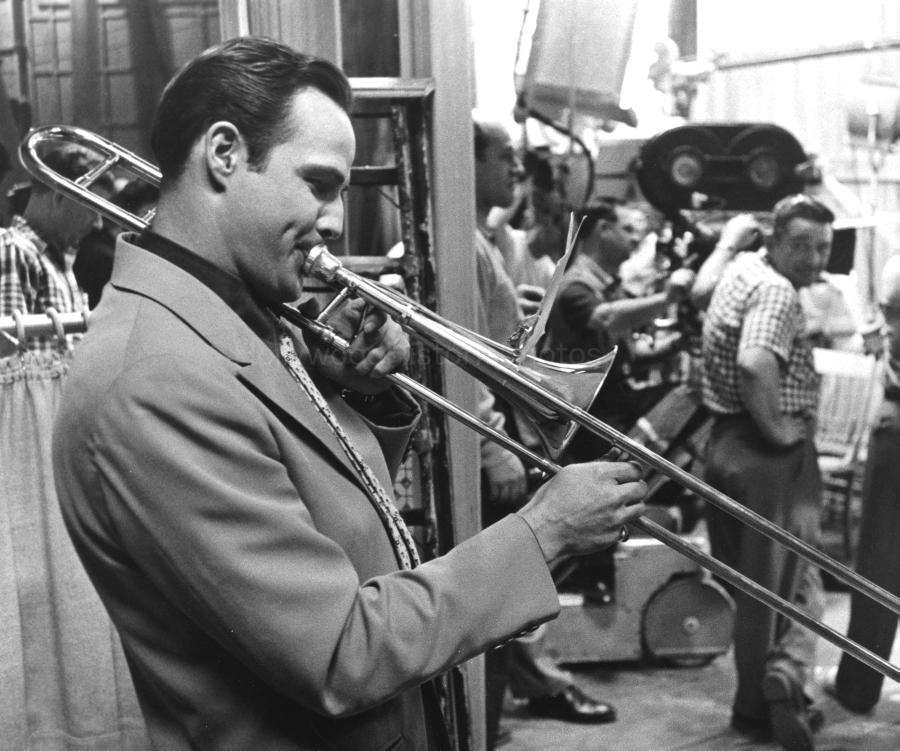
1956—Ernest Bloch, Symphony for trombone and orchestra.
1956—Carter Harman, in A Popular History of Music, says, “The trombones are the tenors and baritones of the brass section. They are sometimes found with valves, but the most familiar type is the slide trombone, known in medieval days as the ‘sackbut’…The trombone is less agile than the trumpet, partly because of the time it takes to move the slide between positions, partly because of the heavier, thicker quality of its voice. It sounds mellow and noble, occasionally martial and sometimes (because it can ‘smear’ a glissando) humorous. More than any orchestral instrument its sound resembles the human voice. Its performers, according to orchestral humor, are phlegmatic. It is not certain whether this is due to the nature of the music they are given to play or to the nature of the trombone itself” (Harman).
1956—Paris Conservatory morceau de concours: Henri Tomasi, Concerto.
1956—Eugene Bozza, Treize Etudes Caprices de Grande Difficulte pour Trombone a Coulisse.
1956—Gordon Jacob, Concerto.
1956—Marcel Bitsch, Quinze Etudes de Rhythme pour Trombone.
1956—Allen Ostrander, The F Attachment and Bass Trombone.
1957—Paris Conservatory morceau de concours: Roger Boutry, Capriccio.
1957—Vladislov Blazhevich, Studies in Clefs, ed. Ostrander.
1957—Collier Jones, Four Movements for brass quintet.
1957/8—John Cage, Solo for Sliding Trombone.
1958—Paris Conservatory morceau de concours: Casterede, Sonatine.
1958—Paris Conservatory morceau de concours: Maurice Franck, Fanfare, Andante et Allegro.
1958—Allen Ostrander, Method for Bass Trombone and F Attachment for Tenor Trombone.
1958—Paul Apel, in The Message of Music, says, “In its serious moments, the trombone is especially sonorous and capable of intoning thrillingly broad and sustained melodies. Its tones are very solemn, grand, and noble, or menacing. It may portray almost every broad emotion, from sacred calm to the wildest strains of martial glory. In addition, its somber tones are well fitted for tragic effects, having a portentous and threatening quality. The use of the slide makes fairly rapid passages possible, thus enabling a soloist to dazzle an audience; but in orchestral work the trombone is treated more slowly” (Apel 467).
1959—Joseph Wagner, in his orchestration text, says the following about trombone: “Composers since the time of Gluck have, with few exceptions, consistently written for three trombones as a unit of ‘harmony instruments’…. Hector Berlioz, in his monumental Treatise on Instrumentation, referred to the trombones as ‘group instruments.’ This distinction results from their homogeneous tonal qualities, which vary little throughout their ranges. Any variance which may occur is generally the fault of the player’s execution of range extremes” (Wagner, Orchestration 226).
1959—Joseph Wagner, in his orchestration text, says the following about bass trombone: “All tonguing styles are possible, but the more rapid ones are fatiguing and become sluggish, especially in the lowest register. The deep, full tone of the bass trombone makes it ideally suited to the bass parts of all brass ensemble passages. It is rarely used as a solo instrument unless doubled either in unison or octaves. Extremely rapid notations are less satisfactory than those for the lighter tenor instrument” (Wagner, Orchestration 227).
1959—In the context of a discussion about instrumentation, Igor Stravinsky says, “What instruments do I like? I wish there were more good players for the bass clarinet and the contra-bass clarinet, for the alto trombone (of my Threni and Berg’s Altenberg Lieder), for the guitar, the mandoline and the cymbalom. Do I dislike any instrument? Well, I am not very fond of the two most conspicuous instruments of the Lulu orchestra, the vibraphone and the alto saxophone” (Stravinsky and Craft 30). Later he remarks, “And let us not forget the fact that traditional symphonic instruments like trumpet and trombone are not the same when played by jazz musicians. The latter people demonstrate greater variety in articulation and tone colour…” (Stravinsky and Craft 31).
1959—Paris Conservatory morceau de concours: Frank Martin, Ballad.
1959—Keith Brown joins the Philadelphia Orchestra. He holds his position until 1962 (Kupferberg 220).
early 1960s—Double-valve bass trombone is developed, largely through Kleinhammer of Chicago Symphony and Kahila of Boston Symphony.
1960—Jacques Casterede, Fantaisie concertante (bass trombone).
1960—Leonard Feather, in his famous Encyclopedia of Jazz, says, “J. J. Johnson was, in effect, the founder of the modern generation of jazz trombonists, the first musician to show himself capable of adapting the rigorous demands of bop to this instrument” (Feather 272).
1960—Malcolm Arnold’s Quintet for Brass is commissioned by the New York Brass Quintet.
1960—Paul Bernard, ed., Method pour Bass Trombone.
1960—Paris Conservatory morceau de concours: Jules Sellmer-Collery, Fantaisie Lyrique.
1960—Henry Cowell, Hymn and Fuguing Tune No. 13 for trombone and piano.
1961—Gunther Schuller, Music for Brass Quintet.
1962—Barney Childs, Sonata for Solo Trombone. Early avant-garde work for trombone.
1962—Trombonist Dee Stweart joins the Philadelphia Orchestra (Kupfurberg 226).
1962—Eugene Bozza, New Orleans (bass trombone).
1962—Morley Calvert, Suite from the Monteregian Hills for brass quintet.
1962—Robert Spillman, Concerto (bass trombone).
1962—Patrick McCarty, Sonata for bass trombone and piano.
1963—Henri Tomasi, Etre ou ne pas etre! Monologue d’Hamlet for solo bass trombone with trombone trio accompaniment.
1963—Edward Kleinhammer, The Art of Trombone Playing.
1963—George Frederick McKay, in his orchestration text, says the following about trombone: “The tone of the trombone is rich, lyric and ponderous. It can be nobly melodic but, due to problems connected with the shifting of the slide, the player can never be completely at ease in legato playing. The trombone staccato cannot be very biting, rapid or pointed. Music written for trombone should, therefore, have a certain epic breadth and dignifiedly moderate pace. When played softly the trombone can produce a mellow lyric quality; when played loudly it has a full-fledged power that is very stirring. It adds nobility and depth to the brass choir.” (McKay 23).
1963-65—György Ligeti composes his Requiem, which calls for 3 trombones.
1964—Fisher Tull, Demonstration Piece for brass quintet.
1964—British manufacturers of brass band instruments (Boosey & Hawkes and Salvation Army) announce decision to cease production of high-pitch instruments, adhering instead to the a’=440 standard.
1964—J. Horovitz, Music Hall Suite for brass quintet.
1964—K. Stephanovsky, 20 Studies for Bass Trombone or Trombone with F attachment. ed. Keith Brown.
1960s and 70s—Classical music’s historical movement, as well as discovery of several important alto trombone solos (including Wagenseil Concerto, Michael Haydn Larghetto and Divertimento in D, and Albrechtsberger Concerto), leads to resurgence of alto trombone.
1960s and 70s—Trombonists Stuart Dempster (b. 1936) and Vinko Globokar (b. 1934) very actively advocate trombone as avant-garde instrument.
1965—Pierre Lantier, Introduction, romance et allegro (bass trombone).
1965—Cheetham, Scherzo for brass quintet.
1965—Lew Gillis, 20 Etudes for Bass Trombone with “F” attachment.
late 1960s—Burt Herrick and Larry Minnick develop in-line/independent valve system for bass trombone.
1966—Lew Gillis, 70 Progressive Studies for the Modern Bass Trombonist.
1966—Luciano Berio, Sequenza V.
1966—Jacob Druckman, Animus 1 for Trombone and Tape.
1966—Nino Rota, Concerto.
1966—Benjamin Britten, after lengthy correspondence with a trombone player, writes cross-harmonic lip glissandos in alto trombone and horn parts in The Burning Fiery Furnace (Wills, Frontiers 258).
1967—Reginald Fink, Studies in Legato.
1967—Reginal Fink, Studies in Legato for Bass Trombone and Tuba.
1967—Donald White, Sonata.
1967—Leslie Bassett, Sonata.
1967-68—Globokar composes Discours II for Five Trombones.
1968—Reginald Fink, Introducing the Tenor Clef for Trombone.
1968—Glenn Dodson joins the Philadelphia Orchestra (Kupferberg 221).
1968—William Lovelock, in his orchestration text, says the following about trombone: “As was noted regarding the trumpet, trombones are not exclusively noise-makers, though they can drown the rest of the orchestra easily enough and should usually be marked a degree lower then other instruments…. Owing to its construction and technique the trombone cannot get a true legato, since taking two or more notes without a fresh attack each time involves a continual glissando (i.e. slither)…. The trombone can be surprisingly agile provided his slide-shifts permit, but it is necessary to understand them and to be prepared to work them out in detail” (Lovelock 80).
1968—Walter Nallin, in The Musical Idea, says, “In general, the range of tones available to a trombone is comparable with the ‘cello or male voice, but its projective power far exceeds either. Able to speak reiterated tones with ease, it moves over rapidly paced passages with remarkable agility. But the instrument unquestionably finds its most exalted use in an utterance of dignified and strongly resonant ideas” (Nallin 91).
1969—Ernst Krenek, Five Pieces.
1969—Malcolm Arnold, Fantasy.
1969—Reginald Fink, Introducing the Alto Clef.
1969—Alan Raph, The Double Valve Bass Trombone.
1970—William Goldstein, Colloquy.
1970—Leslie Bassett, Suite for Unaccompanied Trombone.
1970—Walter Hartley, Sonata Breve.
1970—Boris Grigoriev, 24 Studies for Bass Trombone or Trombone with F Attachment. ed. Allen Ostrander.
1970—New York, New York: Times music critic Harold Schoenberg says, “Trombone players are like ministers—quiet, dull, very moral. Nobody ever heard of a rebellious trombone player.”
1971—Denis Wick, Trombone Technique.
1972—Samuel Adler, Canto II (bass trombone).
1972—Thom Ritter George, Concerto for Bass Trombone and Orchestra.
1972—Walter Ross, Prelude, Fugue, and Big Apple (bass trombone).
1972—Jan Koetsier, Allegro Maestoso (bass trombone).
1973—Robin Gregory, in his book The Trombone: The Instrument and its Music, says, “It now seems unlikely that the trombonist will ever possess a first-class full-dress concerto to match those available to the players of most other wind instruments” (Gregory 152).
1974—Robert Marsteller, Basic Routines for Trombone.
1974—Launy Grondahl, Concerto.
1974—Elliot Carter’s Brass Quintet is commissioned by the American Brass Quintet.
1974—Oscar Blume, 36 Studies for Trombone.
1974—Oscar Blume, 36 Studies for Trombone with F Attachment. ed. Reginald Fink.
1974—Tommy Pederson, Advanced Etudes for Bass Trombone.
1974—Takemitsu, Garden Rain for brass quintet, commissioned by Philip Jones.
1975—Stjepan Sulek, Sonata (vox Gabrieli).
1977—George Walker, a Pulitzer Prize-winning African American composer, writes Concerto for Trombone and Orchestra.
1977—Reginal Fink, The Trombonist’s Handbook.
1979—Quedlinburg, Saxony-Anhalt, Germany: Wolfgang Dreysse includes a trombonist among the 4 musicians in his bronze sculpture, “Münzenberger Musikanten.” This monument to Münzenberg musicians, many of whom made their living playing music for various occasions, is located in the town’s market square (see below image; used by permission of Berthold Huss).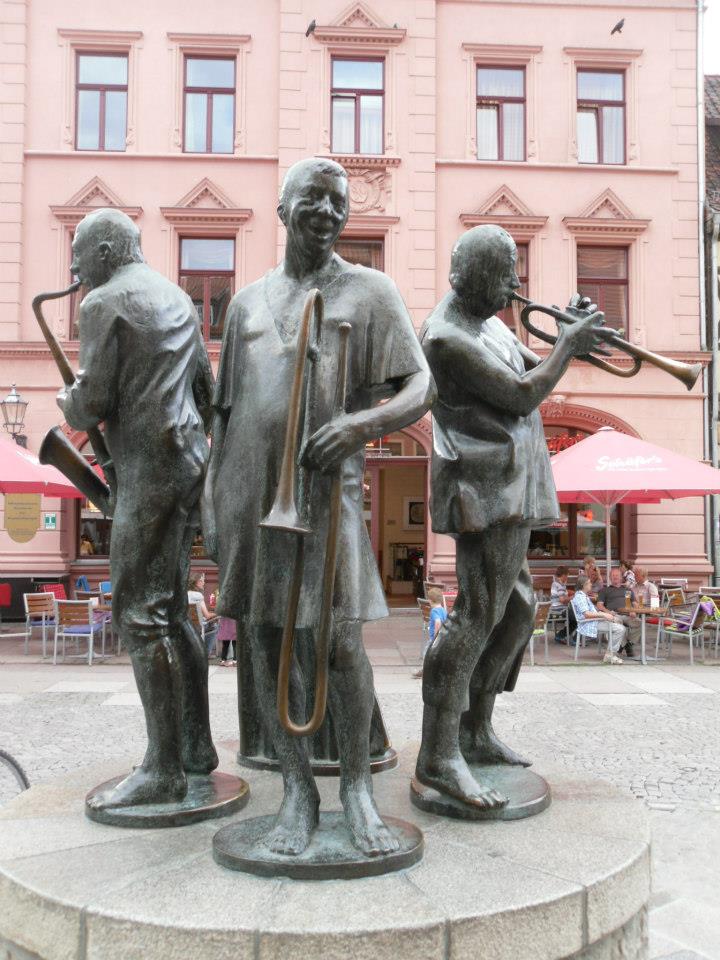
1979—Gordon Jacob, Cameos (bass trombone).
1980—Gunther Schuller, Eine Kleine Posaunenmusik for tenor trombone.
1980—Gordon Jacob, Concertino for Trombone and Wind Ensemble.
1980—Alfred Blatter summarizes the trombone’s character and tone in his orchestration textbook: “The trombone possesses a very full, rich, and sonorous tone quality. In pianissimo passages, one or more trombones can provide a soft cushion of sound. At these softer dynamics, it is almost hornlike in its mellowness. In fortissimo, either in unison, octaves, or chords, the trombone is as assertive as the trumpet, but even more massive and powerful. Trombones played loudly are capable of being heard in any context (Blatter 161).
1980—Alfred Blatter, in his orchestration textbook, mentions an alto trombone “comeback”: “Once given up for lost, the alto trombone is making a modest comeback. This rise in popularity has been due to a renewed interest in older music written specifically for the alto trombone, to the interest shown by some contemporary composers in its lighter, sweeter sound, and to the relative ease it offers in the performance of some of the high nineteenth-century orchestral parts” (Blatter 163).
1980—Alfred Blatter says the following about contrabass trombone in his orchestration textbook: “The contrabass trombone has all the response and endurance problems of the bass trombone, magnified….It is common to find tubas performing parts intended for the contrabass trombone. However, as a cylindrical brass, it is a unique bass sound, not replaceable by the tuba. Scored with care and an understanding of the performance problems, it is an effective and majestic voice not easily forgotten but not often available” (Blatter 164).
1980-84—Krzysztof Penderecki writes his Polish Requiem, which requires 4 trombones. Trombones take part in a powerful brass chorus in the “Tuba mirum” (Chase 347).
c. 1980-1990—Bach 42 the tenor trombone of choice among American professional orchestral tenor trombonists and soloists.
1981—Peter Maxwell Davies’s Brass Quintet is commissioned by the Empire Brass quintet.
1981—Rautavaara’s Playgrounds for Angels for brass quintet is commissioned by Philip Jones.
1982—Samuel Adler, in The Study of Orchestration, says, “The alto trombone was used extensively throughout the nineteenth century, especially by German and Italian composers. It was also a solo instrument during the eighteenth century. Toward the end of the nineteenth century, most composers settled on two tenors and one bass, and the alto fell into disuse. However, many first trombonists today are once again using this instrument to play especially high tessitura parts and to perform the parts originally written for it” (Adler 288).
1982—Samuel Adler, in The Study of Orchestration, says, “The contrabass trombone is much too taxing on the performer, and one is advised not to write for it anymore” (Adler 291).
1982—Stephen Burton, in his orchesration textbook, summarizes the tone and character of the trombone: “The tone of the trombone is more dignified and solemn, though less brilliant, than that of the trumpet….In the lower range, the tone is dark and rich. The tone is remarkably smooth throughout the entire range of the instrument. The trombone has the greatest dynamic range in the orchestra, from the loudest fff, in which a solo trombone can dominate the orchestral tutti, to the vibrant trombone pp. A good fff is possible throughout almost the entire range, although the lowest few notes tend to be weaker. It becomes harder to play p above f1, but a good player can play surprisingly softly in the upper register (Burton 173).
1982—Stephen Burton, in his orchestration textbook, says of valve trombone, “Valves were applied to the trombone in the nineteenth century, but because of the inferior tone of that instrument, it has not survived in the orchestra” (Burton 171).
1982—Folke Rabe, Basta.
1982—Lutoslawski’s Mini Overture for brass quintet is commissioned by Philip Jones.
1982—Frank Sinatra says, “The thing that influenced me most was the way Tommy [Dorsey] played his trombone…It was my idea to make my voice work in the same way as a trombone or violin—not sounding like them, but ‘playing’ the voice like those instrumentalists” (As quoted by Shepherd and Nancy Sinatra).
1983—Charles Vernon, A “Singing” Approach to the Trombone (and other Brass).
1984—Frigyes Hidas, Baroque Concerto for Alto Trombone and String Orchestra.
1984—Don Appert, Maskil for Alto Trombone and Piano.
1984—Commentator Carl Haas, in his book Inside Music, relates the following supposedly true story: “A rather resolute but musically poorly versed lady sat in a side gallery of a concert hall with a good view of the trombone section. With great amazement she watched the first trombonist perform a solo passage requiring a good deal of slide manipulation. Impatiently she rushed to see him right after the performance, tore the trombone from his unsuspecting hands, exclaiming, ‘Give me that thing. I’ll get it out for ye!’ And with that she tore the slide loose from the trombone” (Haas 77).
c. 1985—Christian Lindberg (b. 1958) becomes possibly the first trombonist to sustain a career exclusively as a soloist.
1986—Iannis Xanakis, Keren for solo trombone.
1986—Thom Ritter George, Sonata for Alto Trombone and Piano.
1987—Carl Heinrich Meyer Concertino (1821)is rediscovered by Gewandhaus bass trombonist Rolf Handrow in a Leipzig archive
1988—Pulitzer Prize-winning composer Ellen Taafe Zwilich writes Concerto for Trombone and Orchestra.
1988—Jazz historian Leonard Feather says, “Over the long haul, the trombone has been the most neglected of the major jazz horns.”
1989—Soest, Germany: Sculptor Kord Winter fashions a trio of musicians in honor of one of the city’s most famous residents, 16th century artist Heinrich Aldegrever. The sculpture makes reference to Aldegrever’s Die Posaunisten from the series The Great Wedding Dances of 1538 (see 16th century timeline) (see below image; public domain) (source: wikimedia commons; see also www.kordwinter.de/objekte/Brunnen/brunnen.html).
1989—Pulitzer Prize-winning composer Ellen Taafe Zwilich writes Concerto for Bass Trombone, Strings, Timpani, & Cymbals.
1989—Garrison Keillor says, “The trombonist is a humorist, sort of the brother-in-law of the orchestra. He carries a water spray gun to keep his slide moist and often uses it against his neighbors, that’s why they duck down back there. He’s nobody you’d ever want to see become artistic director; you just hope he doesn’t sit right behind you” (Keillor).
1989—Derek Bourgeois, Trombone Concerto.
1990—Jan Sandström, A Short Ride on a Motorbike.
1990—Schnittke, Dialogue.
1991—Xenakis, Troorkh.
1992—Artist Jim Flora, who had designed many jazz album covers for Columbia Records, paints “Sweets and J.J. Johnson.” Trumpeter Harry “Sweets” Edison and trombonist J.J. Johnson had collaborated in the Count Basie Orchestra, Jazz at the Philharmonic, and various other settings (see upper image). Another Jim Flora image, “Miff Mole’s Cat,” makes reference to early jazz trombonist Miff Mole (see entry for 1922, above) (see lower image). Both images used by permission of www.JimFlora.com, © The Heirs of James Flora.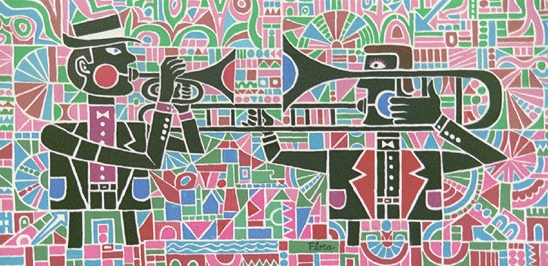
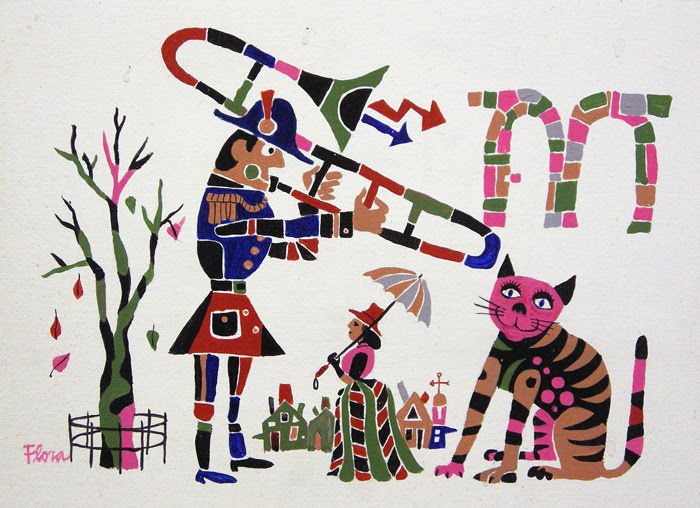
1993—Christopher Rouse’s Trombone Concerto wins Pulitzer Prize.
1993—Merton Shatzkin, in his orchestration text, says the following about trombone: “When higher notes are played loudly, the tone becomes stentorian. Played softly, the sound is more blendeing and has a granitelike smoothness….Loud, low tones can have a snarling effect, as the beginning of Sibelius’s Finlandia demonstrates. Staccatos can be very imposing (Shatzkin 85).
1993—Merton Shatzkin, in his orchestration text, says the following about alto trombone: “The instrument may be making a comeback, since more players seem to be using it” (Shatzkin 90).
1993—Merton Shatzkin, in his orchestration text, says the following about contrabass trombone: “Its size constitutes a considerable challenge for the performer, which is unfortunate, for it better matches the other trombones in forte passages than the tuba does” (Shatzkin 90).
1994—John Kenny, Sonata for Alto Trombone.
1994—Takemitsu, Fantasma Cantus II.
1994—Arvo Pärt, Fratres.
1994—Elizabeth Raum, “Olmütz” Concerto for Alto Trombone and Orchestra.
1995—Augusta Reed Thomas, Echo, Echo for trombone quartet.
1995—James Macmillan, Adam’s Rib for brass quintet.
1995—Walter Hartley, Fantasia on Vermont Tunes (alto trombone).
1995—Arvo Pärt writes the following pieces for trombone: An den Wassern, De Profundis, Pari Intervalli, Silouans Songs.
1995—The Requiem of Reconciliation, a collaborative effort involving 14 composers, is written to commemorate the 50th anniversary of the end of World War II. In Movement I, Prolongo, contributed by Luciano Berio, trombone blasts represent the shofar, a Hebrew ram’s horn played on Jewish High Holidays (Chase 498).
1996—Eliezer Aharoni, New Method for the Modern Bass Trombone.
1998—Eric Ewazen, Sonata for Trombone and Piano.
1998—David Ronald Gillingham, Sonata for Bass Trombone and Piano.
1998—Eric Ewazen, Rhapsody for Bass Trombone.
1998—Eric Ewazen, Concerto for Tuba/Bass Trombone and Piano. Adapted from Sonata for Tuba/Bass Trombone and Piano.
1999—Luciano Berio, SOLO for Trombone and Orchestra.
1999—Daniel Schnyder, Subzero: Concerto for Bass Trombone. David Taylor’s subsequent recording of the piece receives 2002 Grammy nomination for “Best Classical Small Ensemble Recording.”
1999—Eric Ewazen, Ballade for Bass Trombone.
